

What is cultural tourism and why is it growing?
Disclaimer: Some posts on Tourism Teacher may contain affiliate links. If you appreciate this content, you can show your support by making a purchase through these links or by buying me a coffee . Thank you for your support!
Cultural tourism is big business. Some people seek to embark on their travels with the sole intention of having a ‘cultural’ experience, whereas others may experience culture as a byproduct of their trip. We can argue that there is some form of cultural tourism in most holidays (even when taking an all-inclusive holiday you might try to local beer, for example).
But what do we mean by the term ‘cultural tourism’? What’s it all about? In this post I will explain what is meant by the term cultural tourism, providing a range of academic definitions. I will also explain what the different types of cultural tourists are, give examples of cultural tourism activities and discuss the impacts of cultural tourism. Lastly, I will provide a brief summary of some popular cultural tourism destinations.
What is cultural tourism?
Cultural tourism is the act of travellers visiting particular destinations in order to experience and learn about a particular culture . This can include many activities such as; attending events and festivals, visiting museums and tasting the local food and drinks.
Cultural tourism can also be an unintentional part of the tourism experience, whereby cultural immersion (with the local people, their language, customs, cuisine etc) is an inevitable part of a person’s holiday.
Cultural tourism definitions
It has been suggested that tourism is the ideal arena in which to investigate the nature of cultural production (MacCannell, 1976). Tourism provides endless opportunities to learn about the way other people live, about their society and their traditions. Whether you are attending the Running of the Bulls Festival in Pamplona , visiting the pyramids in ancient Egypt , taking a tour of the tea plantations in China or enjoying the locally brewed Ouzo on your all-inclusive holiday to Greece, you will inevitably encounter some form of cultural tourism as part of your holiday experience.
The World Tourism Organisation (WTO) (1985) broadly define cultural tourism as the movements of persons who satisfy the human need for diversity, tending to raise the cultural level of the individual and giving rise to new knowledge, experience and encounters. Cultural tourism is commonly associated with education in this way, some describing it more narrowly as educational cultural tourism (e.g. Bualis and Costa, 2006; Harner and Swarbrooke, 2007; Richards, 2005).
Although a common, more specific definition has not been agreed amongst academics due to the complexity and subjectivity of the term, there do appear to be two distinct viewpoints. The first focusses upon the consumption of cultural products such as sites or monuments (Bonink, 1992; Munsters, 1994), and the second comprises all aspects of travel, where travellers learn about the history and heritage of others or about their contemporary ways of life or thought (MacIntosh and Goeldner, 1986).
Csapo (2012) pertains that the umbrella term of cultural tourism can encompass a number of tourism forms including heritage (material e.g. historic buildings and non-material e.g. literature, arts), cultural thematic routes (e.g. spiritual, gastronomic, linguistic), cultural city tourism, traditions/ethnic tourism, events and festivals, religious tourism and creative culture (e.g. performing arts, crafts).
Types of cultural tourists
In attempt to understand the scope of cultural tourism academics have developed a number of typologies, usually based upon the tourist’s level of motivation.
Bywater (1993) differentiated tourists according to whether they were culturally interested, motivated or inspired.
Culturally interested tourists demonstrate a general interest in culture and consume cultural attractions casually as part of a holiday rather than consciously planning to do so.
Culturally motivated tourists consume culture as a major part of their trip, but do not choose their destination on the basis of specific cultural experiences, whereas for culturally inspired tourists culture is the main goal of their holiday.
A more complex typology was proposed by McKercher and Du Cros (2002), who defined tourists based upon the depth of the cultural experience sought, distinguishing them in to one of five hierarchical categories.
The first is the purposeful cultural tourist for whom cultural tourism is their primary motive for travel. These tourists have a very deep cultural experience.
The second category is the sightseeing cultural tourist for whom cultural tourism is a primary reason for visiting a destination, but the experience is more shallow in nature.
The serendipitous cultural tourist does not travel for cultural reasons, but who, after participating, ends up having a deep cultural tourism experience, whilst the casual cultural tourist is weakly motivated by culture and subsequently has a shallow experience.
Lastly, the incidental cultural tourist is one who does not travel for cultural tourism reasons but nonetheless participates in some activities and has shallow experiences.
Adapting this theory, Petroman et al (2013) segments tourists based upon their preferred cultural activities.
The purposeful cultural tourist, described as according to Mckercher and Du Cros (2002), enjoys learning experiences that challenge them intellectually and visits history museums, art galleries, temples and heritage sites that are less known.
The tour-amateur cultural tourist is akin with the sightseeing cultural tourist above and they often travel long distances, visit remote areas, enjoy tours and wandering through the streets.
The occasional cultural tourist plays a moderate role in the decision of travelling and enjoys an insignificant cultural experience, their preferred activities being to visit attractions and temples that are easy to reach and to explore, although not to the extent that the tour-amateur cultural tourist does.
The incidental cultural tourist plays a small or no role in the decision to travel and enjoys an insignificant cultural experience, whilst visiting attractions that area within easy reach and heritage theme parks.
The last segment is the accidental cultural tourist, who plays a small or no role in the decision to travel but enjoys a deep cultural experience. This tourist type is diverse and as such has no preferred activities attributed to it.
Importance of cultural tourism
Cultural tourism is important for many reasons. Perhaps the most prominent reason is the social impact that it brings.
Cultural tourism can help reinforce identities, enhance cross cultural understanding and preserve the heritage and culture of an area. I have discussed these advantages at length in my post The Social Impacts of Tourism , so you may want to head over there for more detail.
Cultural tourism can also have positive economic impacts . Tourists who visit an area to learn more about a culture or who visit cultural tourism attraction, such as museums or shows, during their trip help to contribute to the economy of the area. Attractions must be staffed, bringing with it employment prospects and tertiary businesses can also benefit, such as restaurants, taxi firms and hotels.
Furthermore, for those seeking a deep cultural experience, options such as homestays can have positive economic benefits to the members of the community who host the tourists.
Read also: Overtourism explained: What, why and where
Personally, I think that one of the most important benefits of cultural tourism is the educational aspect. Tourists and hosts alike can learn more about different ways of life. This can help to broaden one’s mind, it can help one to think differently and to be more objective. These are qualities that can have many positive effects on a person and which can contribute to making them more employable in the future.
Cultural tourism activities
Whether a tourist is seeking a deep cultural experience or otherwise, there are a wide range of activities that can be classified as cultural tourism. Here are a few examples:
- Staying with a local family in a homestay
- Having a tour around a village or town
- Learning about local employment, for example through a tour of a tea plantation or factory
- Undertaking volunteer work in the local community
- Taking a course such as cooking, art, embroidery etc
- Visiting a museum
- Visiting a religious building, such as a Mosque
- Socialising with members of the local community
- Visiting a local market or shopping area
- Trying the local food and drink
- Going to a cultural show or performance
- Visiting historic monuments
Impacts of cultural tourism
There are a range of impacts resulting from cultural tourism activities, both good and bad. Here are some of the most common examples:
Positive impacts of cultural tourism
Revitalisation of culture and art.
Some destinations will encourage local cultures and arts to be revitalised. This may be in the form of museum exhibitions, in the way that restaurants and shops are decorated and in the entertainment on offer, for example.
This may help promote traditions that may have become distant.
Preservation of Heritage
Many tourists will visit the destination especially to see its local heritage. It is for this reason that many destinations will make every effort to preserve its heritage.
This could include putting restrictions in place or limiting tourist numbers, if necessary. This is often an example of careful tourism planning and sustainable tourism management.
This text by Hyung You Park explains the principles of heritage tourism in more detail.
Negative impacts of cultural tourism
Social change.
Social change is basically referring to changes in the way that society acts or behaves. Unfortunately, there are many changes that come about as a result of tourism that are not desirable.
There are many examples throughout the world where local populations have changed because of tourism. Perhaps they have changed the way that they speak or the way that they dress. Perhaps they have been introduced to alcohol through the tourism industry or they have become resentful of rich tourists and turned to crime. These are just a few examples of the negative social impacts of tourism.
Read also: Business tourism explained: What, why and where
Globalisation and the destruction of preservation and heritage.
Globalisation is the way in which the world is becoming increasingly connected. We are losing our individuality and gaining a sense of ‘global being’, whereby we more and more alike than ever before.
Globalisation is inevitable in the tourism industry because of the interaction between tourists and hosts, which typically come from different geographic and cultural backgrounds. It is this interaction that encourage us to become more alike.
Standardisation and Commercialisation
Similarly, destinations risk standardisation in the process of satisfying tourists’ desires for familiar facilities and experiences.
While landscape, accommodation, food and drinks, etc., must meet the tourists’ desire for the new and unfamiliar, they must at the same time not be too new or strange because few tourists are actually looking for completely new things (think again about the toilet example I have previously).
Tourists often look for recognisable facilities in an unfamiliar environment, like well-known fast-food restaurants and hotel chains. Tourist like some things to be standardised (the toilet, their breakfast, their drinks, the language spoken etc), but others to be different (dinner options, music, weather, tourist attractions etc).
Loss of Authenticity
Along similar lines to globalisation is the loss of authenticity that often results from tourism.
Authenticity is essentially something that is original or unchanged. It is not fake or reproduced in any way.
The Western world believe that a tourist destination is no longer authentic when their cultural values and traditions change. But I would argue is this not natural? Is culture suppose to stay the same or it suppose to evolve throughout each generation?
Take a look at the likes of the long neck tribe in Thailand or the Maasai Tribe in Africa. These are two examples of cultures which have remained ‘unchanged’ for the sole purpose of tourism. They appear not to have changed the way that they dress, they way that they speak or the way that they act in generations, all for the purpose of tourism.
You can learn more about what is authenticity in tourism here or see some examples of staged authenticity in this post.
Culture clashes
Because tourism involves movement of people to different geographical locations cultural clashes can take place as a result of differences in cultures, ethnic and religious groups, values, lifestyles, languages and levels of prosperity.
Read also: Environmental impacts of tourism
The attitude of local residents towards tourism development may unfold through the stages of euphoria, where visitors are very welcome, through apathy, irritation and potentially antagonism when anti-tourist attitudes begin to grow among local people. This is represented in Doxey’s Irritation Index, as shown below.

Tourist-host relationships
Culture clashes can also be exasperated by the fundamental differences in culture between the hosts and the tourists.
There is likely to be economic inequality between locals and tourists who are spending more than they usually do at home. This can cause resentment from the hosts towards the tourists, particularly when they see them wearing expensive jewellery or using plush cameras etc that they know they can’t afford themselves.
Further to this, tourists often, out of ignorance or carelessness, fail to respect local customs and moral values.
There are many examples of ways that tourists offend the local population , often unintentionally. Did you know that you should never put your back to a Buddha? Or show the sole of your feet to a Thai person? Or show romantic affection in public in the Middle East?
Cultural tourism destinations
Whilst many would argue that cultural tourism is ingrained to some extent in travel to any country, there are some particular destinations that are well-known for their ability to provide tourists with a cultural experience.
Cultural tourism in India
It is impossible not to visit India and experience the culture. Even if you are staying in a 5 star Western all-inclusive hotel in Goa, you will still test Indian curries, be spoken to by Indian workers and see life outside of the hotel on your transfer to and from the airport.
For most people who travel to India, however, cultural tourism is far more than peeking outside of the enclave tourism bubble of their all-inclusive hotel.
Thousands of international tourists visit the Taj Mahal each year. Many more people visit the various Hindu and Buddhist temples scattered throughout the country as well as the various Mosques. Some visit the famous Varanassi to learn about reincarnation.
Most tourists who visit India will try the local dal, eat the fresh mutton and taste chai.
All of these activities are popular cultural tourism activities.
Cultural tourism in Thailand
Thailand is another destination that offers great cultural tourism potential. From the Buddhist temples and monuments and the yoga retreats to homestays and village tours, there are ample cultural tourism opportunities in Thailand .
Cultural tourism in Israel
Israel is popular with religious tourists and those who are taking a religious pilgrimage, as well as leisure tourists. I visited Israel and loved travelling around to see the various sights, from Bethlehem to Jerusalem . I’m not religious in any way, but I loved learning about the history, traditions and cultures.
Cultural tourism in New York
New York is a city that is bustling with culture. It is world famous for its museums and you can learn about anything from World War Two to the Twin Towers here.
Many would argue that shopping is ingrained in the culture of those who live in New York and many tourists will take advantage of the wide selection of products on offer and bargains to be had on their travels to New York.
You can also treat yourself to watching a traditional West End show, trying some of the famous New York Cheesecake and enjoying a cocktail in Times Square!
Cultural tourism in Dubai
Dubai might not be the first destination that comes to mind when you think of cultural tourism, but it does, in fact, have a great offering.
What I find particular intriguing about Dubai is the mix of old and new. One minute you can be exploring the glitz and glamour of the many high-end shopping malls and skyscrapers and the next you can be walking through a traditional Arabian souk.
Cultural tourism: Conclusion
As you can see, there is big business in cultural tourism. With a wide range of types of cultural tourists and types of cultural tourism experiences, this is a tourism sector that has remarkable potential. However, as always, it is imperative to ensure that sustainable tourism practices are utilised to mitigate any negative impacts of cultural tourism.
If you are interested in learning more about topics such as this subscribe to my newsletter ! I send out travel tips, discount coupons and some material designed to get you thinking about the wider impacts of the tourism industry (like this post)- perfect for any tourism student or keen traveller!
Further reading
Want to learn more about cultural tourism? See my recommended reading list below.
- Cultural Tourism – A textbook illustrating how heritage and tourism goals can be integrated in a management and marketing framework to produce sustainable cultural tourism.
- Deconstructing Travel: Cultural Perspectives on Tourism – This book provides an easily understood framework of the relationship between travel and culture in our rapidly changing postmodern, postcolonial world.
- Re-Investing Authenticity: Tourism, Place and Emotions – This ground-breaking book re-thinks and re-invests in the notion of authenticity as a surplus of experiential meaning and feeling that derives from what we do at/in places.
- The Business of Tourism Management – an introduction to key aspects of tourism, and to the practice of managing a tourism business.
- Managing Sustainable Tourism – tackles the tough issues of tourism such as negative environmental impact and cultural degradation, and provides answers that don’t sacrifice positive economic growth.
- Tourism Management: An Introduction – An introductory text that gives its reader a strong understanding of the dimensions of tourism, the industries of which it is comprised, the issues that affect its success, and the management of its impact on destination economies, environments and communities.
- Responsible Tourism: Using tourism for sustainable development – A textbook about the globally vital necessity of realising sustainable tourism.
Liked this article? Click to share!
Who’s a tourist? How a culture of travel is changing everyday life
Professor of Sustainable Tourism and Director Griffith Institute for Tourism, Griffith University
Disclosure statement
Susanne Becken does not work for, consult, own shares in or receive funding from any company or organisation that would benefit from this article, and has disclosed no relevant affiliations beyond their academic appointment.
Griffith University provides funding as a member of The Conversation AU.
View all partners
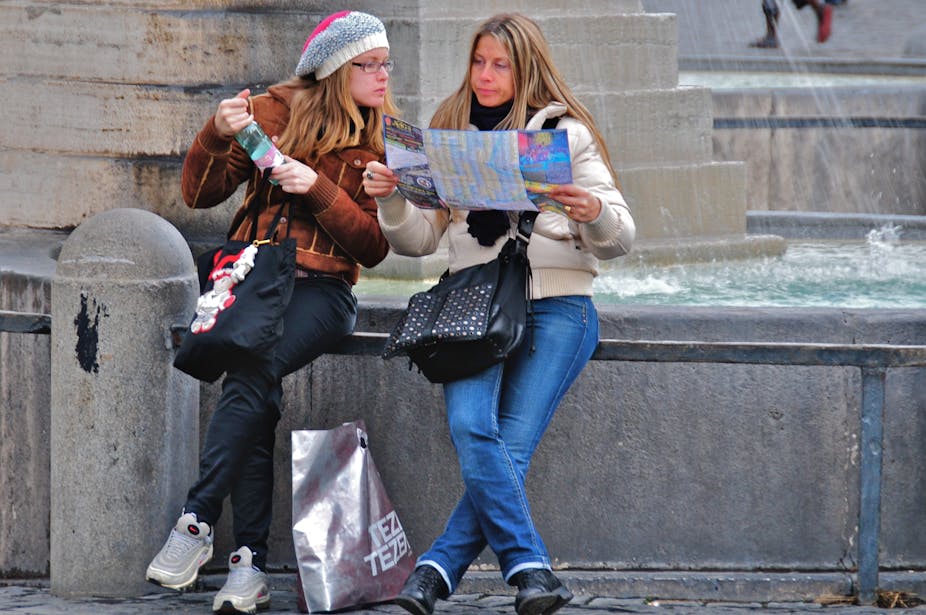
Every year, on September 27, the global tourism community celebrates World Tourism Day . This year’s theme is about community development and how tourism can contribute to empowering people and improve socio-economic conditions in local communities.
But who are the people who might visit “communities” and what does it mean – these days – to be a tourist?
There are many tourist stereotypes – an overweight Westerner in shorts with a camera dangling around their neck, or maybe a trekking-shoed backpacker hanging out in the Himalayas. Many people think of “tourism” and “holidays” as distinct times of the year when the family travels to the seaside or the mountains.
World Tourism Day is an opportunity to discuss how much more encompassing the phenomenon of tourism is than most people might think.
What is a tourist?
People are more often a “tourist” than they realise. The United Nations World Tourism Organisation broadly defines a tourist as anyone travelling away from home for more than one night and less than one year. So, mobility is at the core of tourism.
In Australia, for example, in 2013 75.8 million people travelled domestically for an overnight trip – spending 283 million visitor nights and $51.5 billion.
Reasons for travel are manifold and not restricted to holidays, which makes up only 47% of all domestic trips in Australia. Other reasons include participation in sport events, visiting a friend or relative, or business meetings.
Some of the most-visited destinations in the world are not related to leisure but to other purposes. For example, pilgramage tourism to Mecca (Saudi Arabia) triples the population from its normal 2 million during the Hajj period every year.
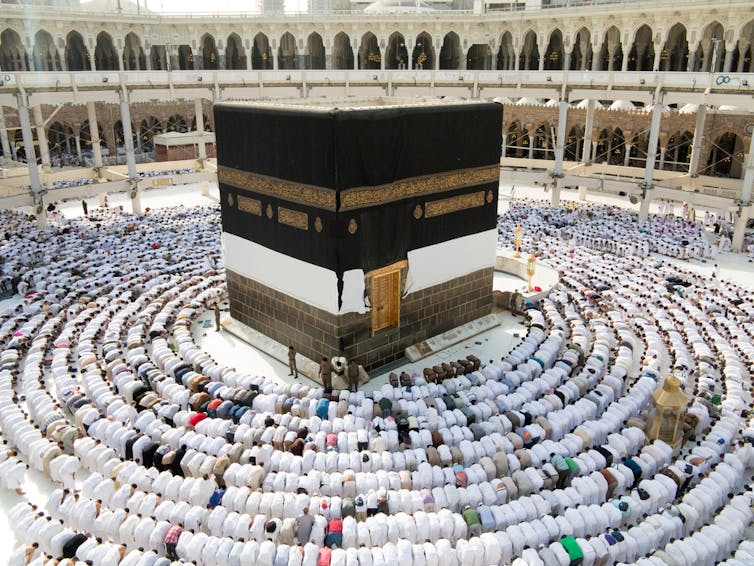
Travel, work and leisure: what’s the difference?
Tourists are not what they used to be. One of the most pervasive changes in the structure of modern life is the crumbling divide between the spheres of work and life. This is no more obvious than in relation to travel. Let me test the readers of The Conversation: who is checking their work emails while on holiday?
A recent survey undertaken in the US showed that 44.8% of respondents check their work email at least once a day outside work hours. Further, 29.8% of respondents use their work email for personal purposes.
Post-modern thinkers have long pointed to processes where work becomes leisure and leisure cannot be separated from work anymore. Ever-increasing mobility means the tourist and the non-tourist become more and more alike.
The classic work-leisure divide becomes particularly fluid for those who frequently engage in travel, for example to attend business meetings or conferences. Conferences are often held at interesting locations, inviting longer stays and recreational activities not only for participants but also for spouses and family.
Further, city business hotels increasingly resemble tourist resorts: both have extensive recreational facilities such as swimming pools and spas, multiple restaurants and often shopping opportunities (e.g. Marina Bay Sands, Singapore ). And, of course, they offer internet access – to be connected to both work and private “business”.
Understanding how people negotiate this liquidity while travelling provides interesting insights into much broader societal changes in terms of how people organise their lives.
For some entrepreneurial destinations these trends have provided an opportunity; namely the designation of so-called dead zones – areas where no mobile phone and no internet access are available. Here the tourist can fully immerse in the real locality of their stay.
Fear of missing out
The perceived need to connect virtually to “friends” (e.g. on Facebook) and colleagues has attracted substantial psychological research interest, with new terms being coined such as FOMO (fear of missing out) addiction, or internet addiction disorder.
A recent Facebook survey found that this social media outlet owes much of its popularity to travel – 42% of stories shared related to travel. The motivations for engaging in extensive social media use and implications for tourism marketing are an active area of tourism research.
Thus, understanding why and what people share while travelling (i.e. away from loved ones, but possibly earning important “social status” points) might provide important insights into wider questions of social networks and identity formation, especially among younger people.
Tourism and emigration
The increasingly global nature of networks has been discussed in detail by sociologist John Urry and others. They note the growing interconnectedness between tourism and migration, where families are spread over the globe and (cheap) air travel enables social networks to connect regularly.
As a result, for many people local communities have given way to global communities, with important implications for people’s “sense of place” and resilience. The global nature of personal networks extends to business relationships where the degree to which one is globally connected determines one’s “network capital”.
Urry also noted that mobility has become a differentiation factor between the “haves” and “have nots”, with a small elite of hypermobile “connectors”. Thus travel and tourism sit at the core of a potentially new structure of leaders and influential decision makers.
The global ‘share economy’
Engaging in this global community of tourists is not restricted to those who travel actively. The so-called Share Economy , where people rent out their private homes (e.g. AirBnB), share taxi rides or dinners, has brought tourism right into the living rooms of those who wish to engage with people who they may not meet otherwise.
Potentially this parallel “tourism industry” provides a unique opportunity for bringing people together and achieving peace through tourism (see International Institute for Peace through Tourism ). A whole new area for research travellers, “guests and hosts” and their economic impacts, is emerging.
In a nutshell, tourism is much more than the service industry it is usually recognised for, both in practice and as a field of academic enquiry. Tourism and the evolving nature of travellers provide important insights into societal changes, challenges and opportunities. Engaging with tourism and travel also provides us with an excellent opportunity to better understand trends that might foster or impede sustainable development more broadly.

Clinical Education Strategy & Risk Project Officer

Senior Research Fellow - Women's Health Services

Lecturer / Senior Lecturer - Marketing

Assistant Editor - 1 year cadetship

Executive Dean, Faculty of Health
- Switch skin
What is Cultural Tourism and Why is It Important?

Tourism trends come and go. What was once deemed as a necessity in travel and tourism may not be a necessity today. So what is cultural tourism and why is it important? Let’s dive in!
How is Culture Defined?
In order to understand cultural tourism, we must first understand what constitutes culture.
Culture is rooted in many complexities and many inner workings. On the surface level, culture can be defined through symbols, words, gestures, people, rituals and more.
However, the core of culture is in its values.
The way a culture perceives itself or stays preserved is through a set of shared values.

Maybe its an ode to ancestry and tradition or a new breadth of
However, the core of culture is in its values.
Whether it’s an ode to ancestry or creating a new set of values as time evolves, it can be also be held true to the
Whether it’s an ode to ancestry or creating a new set of values as time evolves, cultural tourism is uprooted in holding and preserving cultures through traditions and heritage. [1]
What is Cultural Tourism?
Adopted by the UNWTO General Assembly in 2017, Cultural Tourism is defined as the following: “A type of tourism activity in which the visitor’s essential motivation is to learn, discover, experience and consume tangible and intangible cultural attractions/products in a tourism destination.”
The main aim of cultural tourism is to improve the quality and livelihood of the local people who are committed to preserving cultural heritage and traditions.
This can be through the purchase of locally made goods, initiatives through local food and the learning of recipes,
This can be through the purchase of locally made goods, initiatives to learn how to cook local recipes and supporting local inbound operators who have a good knowledge of the cities they are operating in.
This can be done through the following six aspects:
- Handcrafted Goods and Visual Art
- Social Practices
- Rituals and Festive Events
- Oral Traditions
Imagine visiting one of our destinations: Jordan, Tunisia, Kyrgyzstan, Uzbekistan or Tanzania.
Imagine being able to experience all six of these aspects of cultural tourism all created in one package.
Where Can You Practice Cultural Tourism?
Jordan .
From the North to the South, Jordan’s landscapes and its people are ready to welcome you to each and every experience.
In the North, experience the gastronomy of locally preserved recipes and take your hand at being able to learn how to cook yourself.
Take your hand at handcrafted goods like making baskets out of wheat straws or learn the art of traditional weaving in Madaba.
In the South, practice in rituals in the desert by learning about the infamous Bedouin tea, take some words and practices that are so pertinent to those in the South.
See our packages in Jordan
Underground colonies, history and a rich culture are just waiting for you to learn about.
Visit an artist in Gabes who has taken traditional methods of papermaking and carried it to the present today by honoring raw and organic materials pertinent to the atmosphere of Tunisia’s landscape.
Then have an opportunity to stay in local accommodation in underground colonies which stay cool during the summer and warm in the winter.
You can also experience Amazigh history and the different languages present in Tunisia today that trace back to civilizations many years ago.
See our packages in Tunisia
Uzbekistan
One of Central Asia’s unknown wonders
Uzbekistan is located on the Silk Road and holds centuries of history that trace back to the Islamic Golden Age. It holds a unique architectural background and since it holds history between the Persian Empire and the Soviet Union, you can see a contradiction between both styles, all in one place.
See our packages in Uzbekistan
Kyrgyzstan
Where nature is a non-negotiable
With its beautiful nature, with over 2,000 lakes, Kyrgyzstan is another Central Asian wonder that holds beautiful fairytale naturescapes and semi-nomadic living.
Kyrygz people still adhere to ancient civilizations and honor their ancestors by living in Yurts and sharing natural practices such as horseback riding and traditional old games, like Kok Boro and eagle hunting.
See our packages in Kyrgyzstan
Everything is “pole pole” in Tanzania
From visiting indigeneous tribes to participating in rituals to mother nature, Tanzanian people practice the “pole pole” lifestyle, which means slowly slowly in Swahili.
With an intersection of different cultures and practiced rituals, Tanzania has become such a hub for many people to get together and enjoy the lifestyle and indigenous cultures.
See our packages in Tanzania
Why is Cultural Tourism Important?
Cultural tourism is a travel and tourism trend that is here to stay. With more and more accessibility to the world and the people in it, there is peak interest in being able to immersively travel.
- Peaks an interest to immerse yourself in a particular culture
- Creates meanings, stories and understanding between host and guest
- Share cultural practices and be part of the preservation of cultural heritage
- Gain a full understanding a culture without commodification
What better way to honor a destination than by practicing in allowing something to be immortal.
Also, if you’re interested in learning more about experiential tourism, check out this article.
What are some cultural touristic experiences you are looking forward to trying?
What are The Best Times to Visit Jordan?
What is experiential tourism and why is it important, sri lanka weather by month hit or miss we have all the details, best tourist places in sri lanka you need to visit, this is our complete list of jordanian food that you need to try while visiting jordan, ultimate guide for hiking in jordan trails and tips, top 10 places to go in the winter, related articles.

10 Things to Do in Vietnam: From Food to Adventure

Kyrgyzstan Travel Guide 2023 – Unique Activities to Do in Kyrgyzstan

Cutting Edge | Bringing cultural tourism back in the game
The growth of cultural tourism
People have long traveled to discover and visit places of historical significance or spiritual meaning, to experience different cultures, as well as to learn about, exchange and consume a range of cultural goods and services. Cultural tourism as a concept gained traction during the 1990s when certain sub-sectors emerged, including heritage tourism, arts tourism, gastronomic tourism, film tourism and creative tourism. This took place amidst the rising tide of globalization and technological advances that spurred greater mobility through cheaper air travel, increased accessibility to diverse locations and cultural assets, media proliferation, and the rise of independent travel. Around this time, tourism policy was also undergoing a shift that was marked by several trends. These included a sharper focus on regional development, environmental issues, public-private partnerships, industry self-regulation and a reduction in direct government involvement in the supply of tourism infrastructure. As more cultural tourists have sought to explore the cultures of the destinations, greater emphasis has been placed on the importance of intercultural dialogue to promote understanding and tolerance. Likewise, in the face of globalization, countries have looked for ways to strengthen local identity, and cultural tourism has also been engaged as a strategy to achieve this purpose. Being essentially place-based, cultural tourism is driven by an interest to experience and engage with culture first-hand. It is backed by a desire to discover, learn about and enjoy the tangible and intangible cultural assets offered in a tourism destination, ranging from heritage, performing arts, handicrafts, rituals and gastronomy, among others.
Cultural tourism is a leading priority for the majority of countries around the world -featuring in the tourism policy of 90% of countries, based on a 2016 UNWTO global survey . Most countries include tangible and intangible heritage in their definition of cultural tourism, and over 80% include contemporary culture - film, performing arts, design, fashion and new media, among others. There is, however, greater need for stronger localisation in policies, which is rooted in promoting and enhancing local cultural assets, such as heritage, food, festivals and crafts. In France, for instance, the Loire Valley between Sully-sur-Loire and Chalonnes , a UNESCO World Heritage site, has established a multidisciplinary team that defends the cultural values of the site, and advises the authorities responsible for the territorial development of the 300 km of the Valley.
While cultural tourism features prominently in policies for economic growth, it has diverse benefits that cut across the development spectrum – economic, social and environmental. Cultural tourism expands businesses and job opportunities by drawing on cultural resources as a competitive advantage in tourism markets. Cultural tourism is increasingly engaged as a strategy for countries and regions to safeguard traditional cultures, attract talent, develop new cultural resources and products, create creative clusters, and boost the cultural and creative industries. Cultural tourism, particularly through museums, can support education about culture. Tourist interest can also help ensure the transmission of intangible cultural heritage practices to younger generations.

StockSnap, Pixabay
Cultural tourism can help encourage appreciation of and pride in local heritage, thus sparking greater interest and investment in its safeguarding. Tourism can also drive inclusive community development to foster resiliency, inclusivity, and empowerment. It promotes territorial cohesion and socioeconomic inclusion for the most vulnerable populations, for example, generating economic livelihoods for women in rural areas. A strengthened awareness of conservation methods and local and indigenous knowledge contributes to long-term environmental sustainability. Similarly, the funds generated by tourism can be instrumental to ensuring ongoing conservation activities for built and natural heritage.
The growth of cultural tourism has reshaped the global urban landscape over the past decades, strongly impacting spatial planning around the world. In many countries, cultural tourism has been leveraged to drive urban regeneration or city branding strategies, from large-sized metropolises in Asia or the Arab States building on cultural landmarks and contemporary architecture to drive tourism expansion, to small and middle-sized urban settlements enhancing their cultural assets to stimulate local development. At the national level, cultural tourism has also impacted planning decisions, encouraging coastal development in some areas, while reviving inland settlements in others. This global trend has massively driven urban infrastructure development through both public and private investments, impacting notably transportation, the restoration of historic buildings and areas, as well as the rehabilitation of public spaces. The expansion of cultural city networks, including the UNESCO World Heritage Cities programme and the UNESCO Creative Cities Network, also echoes this momentum. Likewise, the expansion of cultural routes, bringing together several cities or human settlements around cultural commonalities to stimulate tourism, has also generated new solidarities, while influencing economic and cultural exchanges between cities across countries and regions.
Despite tourism’s clear potential as a driver for positive change, challenges exist, including navigating the space between economic gain and cultural integrity. Tourism’s crucial role in enhancing inclusive community development can often remain at the margins of policy planning and implementation. Rapid and unplanned tourism growth can trigger a range of negative impacts, including pressure on local communities and infrastructure from overtourism during peak periods, gentrification of urban areas, waste problems and global greenhouse gas emissions. High visitor numbers to heritage sites can override their natural carrying capacity, thus undermining conservation efforts and affecting both the integrity and authenticity of heritage sites. Over-commercialization and folklorization of intangible heritage practices – including taking these practices out of context for tourism purposes - can risk inadvertently changing the practice over time. Large commercial interests can monopolize the benefits of tourism, preventing these benefits from reaching local communities. An excessive dependency on tourism can also create localized monoeconomies at the expense of diversification and alternative economic models. When mismanaged, tourism can, therefore, have negative effects on the quality of life and well-being of local residents, as well as the natural environment.
These fault lines became more apparent when the pandemic hit – revealing the extent of over-dependence on tourism and limited structures for crisis prevention and response. While the current situation facing tourism is unpredictable, making it difficult to plan, further crises are likely in the years to come. Therefore, the pandemic presents the opportunity to experiment with new models to shape more effective and sustainable alternatives for the future.

hxdyl, Getty Images Pro
Harnessing cultural tourism in policy frameworks
From a policy perspective, countries around the world have employed cultural tourism as a vehicle to achieve a range of strategic aims. In Panama, cultural tourism is a key component of the country’s recently adopted Master Plan for Sustainable Tourism 2020-2025 that seeks to position Panama as a worldwide benchmark for sustainable tourism through the development of unique heritage routes. Cultural tourism can be leveraged for cultural diplomacy as a form of ‘soft power’ to build dialogue between peoples and bolster foreign policy. For instance, enhancing regional cooperation between 16 countries has been at the heart of UNESCO’s transnational Silk Roads Programme, which reflects the importance of culture and heritage as part of foreign policy. UNESCO has also partnered with the EU and National Geographic to develop World Heritage Journeys, a unique travel platform that deepens the tourism experience through four selected cultural routes covering 34 World Heritage sites. Also in Europe, cultural tourism has been stimulated through the development of cultural routes linked to food and wine , as well as actions to protect local food products, such as through labels and certificates of origin. The Emilia-Romagna region in Italy, for example, produces more origin-protected food and drink than any other region in the country. One of the regions' cities Parma - a UNESCO Creative City (Gastronomy) and designated Italian Capital for Culture (2020-2021) - plans to resume its cultural activities to boost tourism once restrictions have eased. Meanwhile, Spain has recently taken steps to revive its tourism industry through its cities inscribed on the UNESCO World Heritage List . In this regard, the Group of the 15 Spanish World Heritage Cities met recently to discuss the country's Modernization and Competitiveness Plan for the tourism sector. Cultural tourism has progressively featured more prominently in the policies of Central Asian and Eastern European countries, which have sought to revive intangible heritage and boost the creative economy as part of strategies to strengthen national cultural identity and open up to the international community. In Africa, cultural tourism is a growing market that is driven by its cultural heritage, crafts, and national and regional cultural events. Major festivals such as Dak-Art in Senegal, Bamako Encounters Photography Biennial in Mali, Sauti za Busara in United Republic of Tanzania, Pan-African Festival of Cinema and Television of Ouagadougou in Burkina Faso, and Chale Wote Street Art Festival in Ghana are just a handful of vibrant and popular platforms in the continent that share cultural expressions, generate income for local economies and strengthen Pan-African identity.
Countries are increasingly seeking alliances with international bodies to advance tourism. National and local governments are working together with international entities, such as UNESCO, UNWTO and OECD in the area of sustainable tourism. In 2012, UNESCO’s Sustainable Tourism Programme was adopted, thereby breaking new ground to promote tourism a driver for the conservation of cultural and natural heritage and a vehicle for sustainable development. In 2020, UNESCO formed the Task Force on Culture and Resilient Tourism with the Advisory Bodies to the 1972 World Heritage Convention (ICOMOS, IUCN, ICCROM) as a global dialogue platform on key issues relating to tourism and heritage management during and beyond the crisis. UNESCO has also collaborated with the UNWTO on a set of recommendations for inclusive cultural tourism recovery from the COVID-19 crisis. In response to the crisis, the Namibian Government, UNESCO and UNDP are working together on a tourism impact study and development strategy to restore the tourism sector, especially cultural tourism.
UNESCO has scaled up work in cultural tourism in its work at field level, supporting its Member States and strengthening regional initiatives. In the Africa region, enhancing cultural tourism has been reported as a policy priority across the region. For example, UNESCO has supported the Government of Ghana in its initiative Beyond the Return, in particular in relation to its section on cultural tourism. In the Pacific, a Common Country Assessment (CCA) has been carried out for 14 SIDS countries, with joint interagency programmes to be created building on the results. Across the Arab States, trends in tourism after COVID, decent jobs and cultural and creative industries are emerging as entry points for different projects throughout the region. In Europe, UNESCO has continued its interdisciplinary work on visitor centres in UNESCO designated sites, building on a series of workshops to strengthen tourism sustainability, community engagement and education through heritage interpretation. In the Latin America and the Caribbean region, UNESCO is working closely with Member States, regional bodies and the UN system building on the momentum on the International Year of Creative Economy for Sustainable Development, including through Creative Cities, and the sustainable recovery of the orange economy, among others.

BS1920, Pixabay
In the context of the 2030 Agenda for Sustainable Development, tourism has the potential to contribute, directly or indirectly, to all of the 17 Sustainable Development Goals (SDGs). Tourism is directly mentioned in SDGs 8, 12 and 14 on inclusive and sustainable economic growth, sustainable consumption and production (SCP) and the sustainable use of oceans and marine resources, respectively. This is mirrored in the VNRs put forward by countries, who report on cultural tourism notably through the revitalization of urban and rural areas through heritage regeneration, festivals and events, infrastructure development, and the promotion of local cultural products. The VNRs also demonstrate a trend towards underlining more sustainable approaches to tourism that factor in the environmental dimensions of tourism development.
Several countries have harnessed cultural tourism as a policy panacea for economic growth and diversification. As part of Qatar's National Vision 2030 strategy, for example, the country has embarked on a development plan that includes cultural tourism through strengthening its culture-based industries, including calligraphy, handicrafts and living heritage practices. In the city of Abu Dhabi in the UAE, cultural tourism is part of the city’s plan for economic diversification and to steer its domestic agenda away from a hydrocarbon-based economy. The Plan Abu Dhabi 2030 includes the creation of a US$27 billion cultural district on Saadiyat Island, comprising a cluster of world-renowned museums, and cultural and educational institutions designed by international star architects to attract tourism and talent to the city. Since 2016, Saudi Arabia has taken decisive action to invest in tourism, culture and entertainment to reduce the country’s oil dependency, while also positioning the country as a global cultural destination. Under the 2020 G20 Saudi Presidency, the UNWTO and the G20 Tourism Working Group launched the AlUla Framework for Inclusive Community Development through Tourism to better support inclusive community development and the SDGs. The crucial role of tourism as a means of sustainable socio-economic development was also underlined in the final communique of the G20 Tourism Ministers in October last.

Siem Reap, Cambodia by nbriam
On the other hand, cultural tourism can catalyse developments in cultural policy. This was the case in the annual Festival of Pacific Arts (FestPac) that triggered a series of positive policy developments following its 2012 edition that sought to strengthen social cohesion and community pride in the context of a prolonged period of social unrest. The following year, Solomon Islands adopted its first national culture policy with a focus on cultural industries and cultural tourism, which resulted in a significant increase in cultural events being organized throughout the country.
When the pandemic hit, the geographic context of some countries meant that many of them were able to rapidly close borders and prioritize domestic tourism. This has been the case for countries such as Australia and New Zealand. However, the restrictions have been coupled by significant economic cost for many Small Island Developing States (SIDS) whose economies rely on tourism and commodity exports. Asia Pacific SIDS, for example, are some of the world’s leading tourist destinations. As reported in the Tracker last June , in 2018, tourism earnings exceeded 50% of GDP in Cook Islands, Maldives and Palau and equaled approximately 30% of GDP in Samoa and Vanuatu. When the pandemic hit in 2020, the drop in British tourists to Spain’s Balearic Islands resulted in a 93% downturn in visitor numbers , forcing many local businesses to close. According to the World Economic Outlook released last October, the economies of tourism-dependent Caribbean nations are estimated to drop by 12%, while Pacific Island nations, such as Fiji, could see their GDP shrink by a staggering 21% in 2020.
Socially-responsible travel and ecotourism have become more of a priority for tourists and the places they visit. Tourists are increasingly aware of their carbon footprint, energy consumption and the use of renewable resources. This trend has been emphasized as a result of the pandemic. According to recent survey by Booking.com, travelers are becoming more conscientious of how and why they travel, with over two-thirds (69%) expecting the travel industry to offer more sustainable travel options . Following the closures of beaches in Thailand, for example, the country is identifying ways to put certain management policies in place that can strike a better balance with environmental sustainability. The UNESCO Sustainable Tourism Pledge launched in partnership with Expedia Group focuses on promoting sustainable tourism and heritage conservation. The pledge takes an industry-first approach to environmental and cultural protection, requiring businesses to introduce firm measures to eliminate single-use plastics and promote local culture. The initiative is expanding globally in 2021 as a new, more environmentally and socially conscious global travel market emerges from the COVID-19 context.

Senja, Norway by Jarmo Piironen
Climate change places a heavy toll on heritage sites, which exacerbates their vulnerability to other risks, including uncontrolled tourism. This was underlined in the publication “World Heritage and Tourism in a Changing Climate” , published by UNESCO, UNEP and the Union of Concerned Scientists, which analyses the consequences of climate change on heritage, and its potential to permanently change or destroy a site’s integrity and authenticity. Extreme weather events, safety issues and water shortages, among others, can thwart access to sites and hurt the economic livelihoods of tourism service providers and local communities. Rising sea levels will increasingly impact coastal tourism, the largest component of the sector globally. In particular, coral reefs - contributing US$11.5 billion to the global tourism economy – are at major risk from climate change.
Marine sites are often tourist magnets where hundreds of thousands of annual visitors enjoy these sites on yachts and cruise ships. In the case of UNESCO World Heritage marine sites – which fall under the responsibility of governments - there is often a reliance on alternative financing mechanisms, such as grants and donations, and partnerships with non-governmental organizations and/or the private sector, among others. The West Norwegian Fjords – Geirangerfjord and Nærøyfjord in Norway derives a substantial portion of its management budget from sources other than government revenues. The site has benefited from a partnership with the private sector company Green Dream 2020, which only allows the “greenest” operators to access the site, and a percentage of the profits from tours is reinjected into the long-term conservation of the site. In iSimangaliso in South Africa, a national law that established the World Heritage site’s management system was accompanied by the obligation to combine the property’s conservation with sustainable economic development activities that created jobs for local people. iSimangaliso Wetland Park supports 12,000 jobs and hosts an environmental education programme with 150 schools. At the Great Barrier Reef in Australia, where 91% of all local jobs are linked to the Reef, the Coral Nurture Programme undertakes conservation through planting coral, and promotes local stewardship and adaptation involving the whole community and local tourist businesses.

Grafner, Getty Images
With borders continuing to be closed and changeable regulations, many countries have placed a focus on domestic tourism and markets to stimulate economic recovery. According to the UNWTO, domestic tourism is expected to pick up faster than international travel, making it a viable springboard for economic and social recovery from the pandemic. In doing so it will serve to better connect populations to their heritage and offer new avenues for cultural access and participation. In China, for example, the demand for domestic travel is already approaching pre-pandemic levels. In Russian Federation, the Government has backed a programme to promote domestic tourism and support small and medium-sized enterprises, as well as a cashback scheme for domestic trips, which entitles tourists to a 20% refund for their trip. While supporting domestic tourism activities, the Government of Palau is injecting funds into local businesses working in reforestation and fishing in the spirit of building new sustainable models. The measures put in place today will shape the tourism to come, therefore the pandemic presents an opportunity to build back a stronger, more agile and sustainable tourism sector.
Local solutions at the helm of cultural tourism
While state-led policy interventions in cultural tourism remain crucial, local authorities are increasingly vital stakeholders in the design and implementation of cultural tourism policies. Being close to the people, local actors are aware of the needs of local populations, and can respond quickly and provide innovative ideas and avenues for policy experimentation. As cultural tourism is strongly rooted to place, cooperating with local decision-makers and stakeholders can bring added value to advancing mutual objectives. Meanwhile, the current health crisis has severely shaken cities that are struggling due to diminished State support, and whose economic basis strongly relies on tourism. Local authorities have been compelled to innovate to support local economies and seek viable alternatives, thus reaffirming their instrumental role in cultural policy-making.

Venice, Oliver Dralam/Getty Images
Cultural tourism can be a powerful catalyst for urban regeneration and renaissance, although tourism pressure can also trigger complex processes of gentrification. Cultural heritage safeguarding enhances the social value of a place by boosting the well-being of individuals and communities, reducing social inequalities and nurturing social inclusion. Over the past decade, the Malaysian city of George Town – a World Heritage site – has implemented several innovative projects to foster tourism and attract the population back to the city centre by engaging the city’s cultural assets in urban revitalization strategies. Part of the income generated from tourism revenues contributes to conserving and revitalizing the built environment, as well as supporting housing for local populations, including lower-income communities. In the city of Bordeaux in France , the city has worked with the public-private company InCité to introduce a system of public subsidies and tax exemption to encourage the restoration of privately-owned historical buildings, which has generated other rehabilitation works in the historic centre. The city of Kyoto in Japan targets a long-term vision of sustainability by enabling local households to play an active role in safeguarding heritage by incrementally updating their own houses, thus making the city more resilient to gentrification. The city also actively supports the promotion of its intangible heritage, such as tea ceremonies, flower arrangement, seasonal festivals, Noh theatre and dance. This year marks the ten-year anniversary of the adoption of the UNESCO Recommendation on the Historic Urban Landscape (HUL). The results of a UNESCO survey carried out among Member States in 2019 on its implementation show that 89% of respondents have innovative services or tourism activities in place for historic areas, which demonstrates a precedence for countries to capitalize on urban cultural heritage for tourism purposes.
Cultural tourism has been harnessed to address rural-urban migration and to strengthen rural and peripheral sub-regions. The city of Suzhou – a World Heritage property and UNESCO Creative City (Crafts and Folk Art) - has leveraged its silk embroidery industry to strengthen the local rural economy through job creation in the villages of Wujiang, located in a district of Suzhou. Tourists can visit the ateliers and local museums to learn about the textile production. In northern Viet Nam, the cultural heritage of the Quan họ Bắc Ninh folk songs, part of the Representative List of the Intangible Cultural Heritage of Humanity, is firmly rooted in place and underlined in its safeguarding strategies in 49 ancient villages, which have further inspired the establishment of some hundreds of new Quan họ villages in the Bắc Ninh and Bắc Giang provinces.

Many top destination cities are known for their iconic cultural landmarks. Others create a cultural drawcard to attract visitors to the city. France, the world's number one tourist destination , attracts 89 million visitors every year who travel to experience its cultural assets, including its extensive cultural landmarks. In the context of industrial decline, several national and local governments have looked to diversify infrastructure by harnessing culture as a new economic engine. The Guggenheim museum in Bilbao in Spain is one such example, where economic diversification and unemployment was addressed through building a modern art museum as a magnet for tourism. The museum attracts an average of 900,000 visitors annually, which has strengthened the local economy of the city. A similar approach is the Museum of Old and New Art (MONA), established in 2011 by a private entrepreneur in the city of Hobart in Australia, which has catalysed a massive increase of visitors to the city. With events such as MONA FOMA in summer and Dark MOFO in winter, the museum staggers visitor volumes to the small city to avoid placing considerable strain on the local environment and communities. Within the tourism sector, cultural tourism is also well-positioned to offer a tailored approach to tourism products, services and experiences. Such models have also supported the wider ecosystems around the iconic cultural landmarks, as part of “destination tourism” strategies.
Destination tourism encompasses festivals, live performance, film and festive celebrations as drawcards for international tourists and an economic driver of the local economy. Over the past three decades, the number of art biennials has proliferated. Today there are more than 300 biennials around the world , whose genesis can be based both on artistic ambitions and place-making strategies to revive specific destinations. As a result of COVID-19, many major biennials and arts festivals have been cancelled or postponed. Both the Venice Architecture and Art Biennales have been postponed to 2022 due to COVID-19. The Berlin International Film Festival will hold its 2021 edition online and in selected cinemas. Film-induced tourism - motivated by a combination of media expansion, entertainment industry growth and international travel - has also been used for strategic regional development, infrastructure development and job creation, as well to market destinations to tourists. China's highest-grossing film of 2012 “Lost in Thailand”, for example, resulted in a tourist boom to Chiang Mai in Thailand, with daily flights to 17 Chinese cities to accommodate the daily influx of thousands of tourists who came to visit the film’s location. Since March 2020, tourism-related industries in New York City in the United States have gone into freefall, with revenue from the performing arts alone plunging by almost 70%. As the city is reliant on its tourism sector, the collapse of tourism explains why New York’s economy has been harder hit than other major cities in the country. Meanwhile in South Africa, when the first ever digital iteration of the country’s annual National Arts Festival took place last June, it also meant an estimated US$25.7 million (R377 million) and US$6.4 million (R94 million) loss to the Eastern Cape province and city of Makhanda (based on 2018 figures), in addition to the US$1.4 million (R20 million) that reaches the pockets of the artists and supporting industries. The United Kingdom's largest music festival, Glastonbury, held annually in Somerset, recently cancelled for the second year running due to the pandemic, which will have ripple effects on local businesses and the charities that receive funding from ticket sales.
Similarly, cancellations of carnivals from Santa Cruz de Tenerife in the Canary Islands to Binche in Belgium has spurred massive losses for local tourism providers, hotels, restaurants, costume-makers and dance schools. In the case of the Rio de Janeiro Carnival in Brazil, for instance, the city has amassed significant losses for the unstaged event, which in 2019 attracted 1.5 million tourists from Brazil and abroad and generated revenues in the range of US$700 million (BRL 3.78 billion). The knock-on effect on the wider economy due to supply chains often points to an estimated total loss that is far greater than those experienced solely by the cultural tourism sector.

Guggenheim Museum Bilbao, Spain by erlucho
Every year, roughly 600 million national and international religious and spiritual trips take place , generating US$18 billion in tourism revenue. Pilgrimages, a fundamental precursor to modern tourism, motivate tourists solely through religious practices. Religious tourism is particularly popular in France, India, Italy and Saudi Arabia. For instance, the Hindu pilgrimage and festival Kumbh Mela in India, inscribed in 2017 on the UNESCO Representative List of the Intangible Cultural Heritage of Humanity, attracts over 120 million pilgrims of all castes, creeds and genders. The festival is held in the cities of Allahabad, Haridwar, Ujjain and Nasik every four years by rotation. Sacred and ceremonial sites have unique significance for peoples and communities, and are often integral to journeys that promote spiritual well-being. Mongolia, for example, has around 800 sacred sites including 10 mountains protected by Presidential Decree, and lakes and ovoos, many of which have their own sutras. In the case of Mongolia, the environmental stewardship and rituals and practices connected with these sacred places also intersects with longstanding political traditions and State leadership.
Cities with a vibrant cultural scene and assets are not only more likely to attract tourists, but also the skilled talent who can advance the city’s long-term prospects. Several cities are also focusing on developing their night-time economies through the promotion of theatre, concerts, festivals, light shows and use of public spaces that increasingly making use of audio-visual technologies. Situated on Chile’s Pacific coast, the city of Valparaíso, a World Heritage site, is taking steps to transform the city’s night scene into a safe and inclusive tourist destination through revitalizing public spaces. While the economies of many cities have been weakened during the pandemic, the night-time economy of the city of Chengdu in China, a UNESCO Creative City for Gastronomy, has flourished and has made a significant contribution to generating revenue for the city, accounting for 45% of citizen’s daily expenditure.
The pandemic has generated the public’s re-appropriation of the urban space. People have sought open-air sites and experiences in nature. In many countries that are experiencing lockdowns, public spaces, including parks and city squares, have proven essential for socialization and strengthening resilience. People have also reconnected with the heritage assets in their urban environments. Local governments, organizations and civil society have introduced innovative ways to connect people and encourage creative expression. Cork City Council Arts Office and Creative Ireland, for example, jointly supported the art initiative Ardú- Irish for ‘Rise’ – involving seven renowned Irish street artists who produced art in the streets and alleyways of Cork.

Chengdu Town Square, China by Lukas Bischoff
Environment-based solutions support integrated approaches to deliver across the urban-rural continuum, and enhance visitor experiences by drawing on the existing features of a city. In the city of Bamberg, a World Heritage site in Germany, gardens are a key asset of the city and contribute to its livability and the well-being of its local population and visitors. More than 12,000 tourists enjoy this tangible testimony to the local history and environment on an annual basis. Eighteen agricultural businesses produce local vegetables, herbs, flowers and shrubs, and farm the inner-city gardens and surrounding agricultural fields. The museum also organizes gastronomic events and cooking classes to promote local products and recipes.
In rural areas, crafts can support strategies for cultural and community-based tourism. This is particularly the case in Asia, where craft industries are often found in rural environments and can be an engine for generating employment and curbing rural-urban migration. Craft villages have been established in Viet Nam since the 11th century, constituting an integral part of the cultural resources of the country, and whose tourism profits are often re-invested into the sustainability of the villages. The craft tradition is not affected by heavy tourist seasons and tourists can visit all year round.
Indigenous tourism can help promote and maintain indigenous arts, handicrafts, and culture, including indigenous culture and traditions, which are often major attractions for visitors. Through tourism, indigenous values and food systems can also promote a less carbon-intensive industry. During COVID-19, the Government of Canada has given a series of grants to indigenous tourism businesses to help maintain livelihoods. UNESCO’s Intergovernmental Committee for the Protection and Promotion of the Diversity of Cultural Expressions announced that it will grant, through the International Fund for Creative Diversity (IFCD), US$70,000 dollars to Mexican indigenous cultural enterprises, which will support indigenous enterprises through training programmes, seed funding, a pre-incubation process and the creation of an e-commerce website.
Tourism has boosted community pride in living heritage and the active involvement of local communities in its safeguarding. Local authorities, cultural associations, bearers and practitioners have made efforts to safeguard and promote elements as they have understood that not only can these elements strengthen their cultural identity but that they can also contribute to tourism and economic development. In recent years, there has been a growing interest in the role of intellectual property and in the regulation of heritage. In the field of gastronomy, a lot of work has been done in protecting local food products, including the development of labels and certification of origin. Member States are exploring the possibilities of geographical indication (GI) for cultural products as a way of reducing the risk of heritage exploitation in connection to, for example, crafts, textiles and food products, and favouring its sustainable development.
The pandemic has brought to the forefront the evolving role of museums and their crucial importance to the life of societies in terms of health and well-being, education and the economy. A 2019 report by the World Health Organization (WHO) examined 3,000 studies on the role of the arts in improving health and well-being, which indicated that the arts play a major role in preventing, managing and treating illness. Over the past decade the number of museums has increased by 60%, demonstrating the important role that museums have in national cultural policy. Museums are not static but are rather dynamic spaces of education and dialogue, with the potential to boost public awareness about the value of cultural and natural heritage, and the responsibility to contribute to its safeguarding.
Data presented in UNESCO's report "Museums Around the World in the Face of COVID-19" in May 2020 show that 90% of institutions were forced to close, whereas the situation in September-October 2020 was much more variable depending on their location in the world. Large museums have consistently been the most heavily impacted by the drop in international tourism – notably in Europe and North America. Larger museums, such as Amsterdam’s Rijksmuseum and Vienna’s Kunsthistorisches Museum have reported losses between €100,000 and €600,000 a week. Smaller museums have been relatively stable, as they are not as reliant on international tourism and have maintained a closer connection to local communities. In November, the Network of European Museum Organisations (NEMO) released the results of a survey of 6,000 museums from 48 countries. Of the responding museums, 93% have increased or started online services during the pandemic. Most larger museums (81%) have increased their digital capacities, while only 47% of smaller museums indicated that they did. An overwhelming majority of respondents (92.9%) confirm that the public is safe at their museum. As reported in the Tracker last October, the world’s most visited museum, the Louvre in France (9.3 million visitors annually) witnessed a ten-fold increase in traffic to its website. Yet while digital technologies have provided options for museums to remain operational, not all have the necessary infrastructure, which is the case for many museums in Africa and SIDS.

New technologies have enabled several new innovations that can better support cultural tourism and digital technologies in visitor management, access and site interpretation. Cultural tourists visiting cultural heritage sites, for example, can enjoy educational tools that raise awareness of a site and its history. Determining carrying capacity through algorithms has helped monitor tourist numbers, such as in Hạ Long Bay in Viet Nam. In response to the pandemic, Singapore’s Asian Civilizations Museum is one of many museums that has harnessed digital technologies to provide virtual tours of its collections, thus allowing viewers to learn more about Asian cultures and histories. The pandemic has enhanced the need for technology solutions to better manage tourism flows at destinations and encourage tourism development in alternative areas.
Shaping a post-pandemic vision : regenerative and inclusive cultural tourism
As tourism is inherently dependent on the movement and interaction of people, it has been one of the hardest-hit sectors by the pandemic and may be one of the last to recover. Travel and international border restrictions have led to the massive decline in tourism in 2020, spurring many countries to implement strategies for domestic tourism to keep economies afloat. Many cultural institutions and built and natural heritage sites have established strict systems of physical distancing and hygiene measures, enabling them to open once regulations allow. Once travel restrictions have been lifted, it will enable the recovery of the tourism sector and for the wider economy and community at large.
While the pandemic has dramatically shifted the policy context for cultural tourism, it has also provided the opportunity to experiment with integrated models that can be taken forward in the post-pandemic context. While destinations are adopting a multiplicity of approaches to better position sustainability in their plans for tourism development, there is no one-size-fits-all solution.
A comprehensive, integrated approach to the cultural sector is needed to ensure more sustainable cultural tourism patterns. Efforts aimed at promoting cultural tourism destinations should build on the diversity of cultural sub-sectors, including cultural and heritage sites, museums, but also the creative economy and living heritage, notably local practices, food and crafts production. Beyond cultural landmarks, which act as a hotspot to drive the attractiveness of tourism destinations, and particularly cities, cultural tourism should also encompass other aspects of the cultural value chain as well as more local, community-based cultural expressions. Such an integrated approach is likely to support a more equitable distribution of cultural tourism revenues, also spreading tourism flows over larger areas, thus curbing the negative impacts of over-tourism on renowned cultural sites, including UNESCO World Heritage sites. This comprehensive vision also echoes the growing aspiration of visitors around the world for more inclusive and sustainable tourism practices, engaging with local communities and broadening the understanding of cultural diversity.
As a result of the crisis, the transversal component of cultural tourism has been brought to the fore, demonstrating its cross-cutting nature and alliance with other development areas. Cultural tourism – and tourism more broadly – is highly relevant to the 2030 for Sustainable Development and its 17 SDGs, however, the full potential of cultural tourism for advancing development – economic, social and environmental - remains untapped. This is even though cultural tourism is included in a third of all countries’ VNRs, thus demonstrating its priority for governments. Due the transversal nature of cultural tourism, there is scope to build on these synergies and strengthen cooperation between ministries to advance cooperation for a stronger and more resilient sector. This plays an integral role in ensuring a regenerative and inclusive cultural tourism sector. Similarly, tourism can feature as criteria for certain funding initiatives, or as a decisive component for financing cultural projects, such as in heritage or the cultural and creative industries.

Houses in Amsterdam, adisa, Getty, Images Pro
Several countries have harnessed the crisis to step up actions towards more sustainable models of cultural tourism development by ensuring that recovery planning is aligned with key sustainability principles and the SDGs. Tourism both impacts and is impacted by climate change. There is scant evidence of integration of climate strategies in tourism policies, as well as countries’ efforts to develop solid crisis preparedness and response strategies for the tourism sector. The magnitude and regional variation of climate change in the coming decades will continue to affect cultural tourism, therefore, recovery planning should factor in climate change concerns. Accelerating climate action is of utmost importance for the resilience of the sector.
The key role of local actors in cultural tourism should be supported and developed. States have the opportunity to build on local knowledge, networks and models to forge a stronger and more sustainable cultural tourism sector. This includes streamlining cooperation between different levels of governance in the cultural tourism sector and in concert with civil society and private sector. Particularly during the pandemic, many cities and municipalities have not received adequate State support and have instead introduced measures and initiatives using local resources. In parallel, such actions can spur new opportunities for employment and training that respond to local needs.
Greater diversification in cultural tourism models is needed, backed by a stronger integration of the sector within broader economic and regional planning. An overdependence of the cultural sector on the tourism sector became clear for some countries when the pandemic hit, which saw their economies come to a staggering halt. This has been further weakened by pre-existing gaps in government and industry preparedness and response capacity. The cultural tourism sector is highly fragmented and interdependent, and relies heavily on micro and small enterprises. Developing a more in-depth understanding of tourism value chains can help identify pathways for incremental progress. Similarly, more integrated – and balanced – models can shape a more resilient sector that is less vulnerable to future crises. Several countries are benefiting from such approaches by factoring in a consideration of the environmental and socio-cultural pillars of sustainability, which is supported across all levels of government and in concert with all stakeholders.
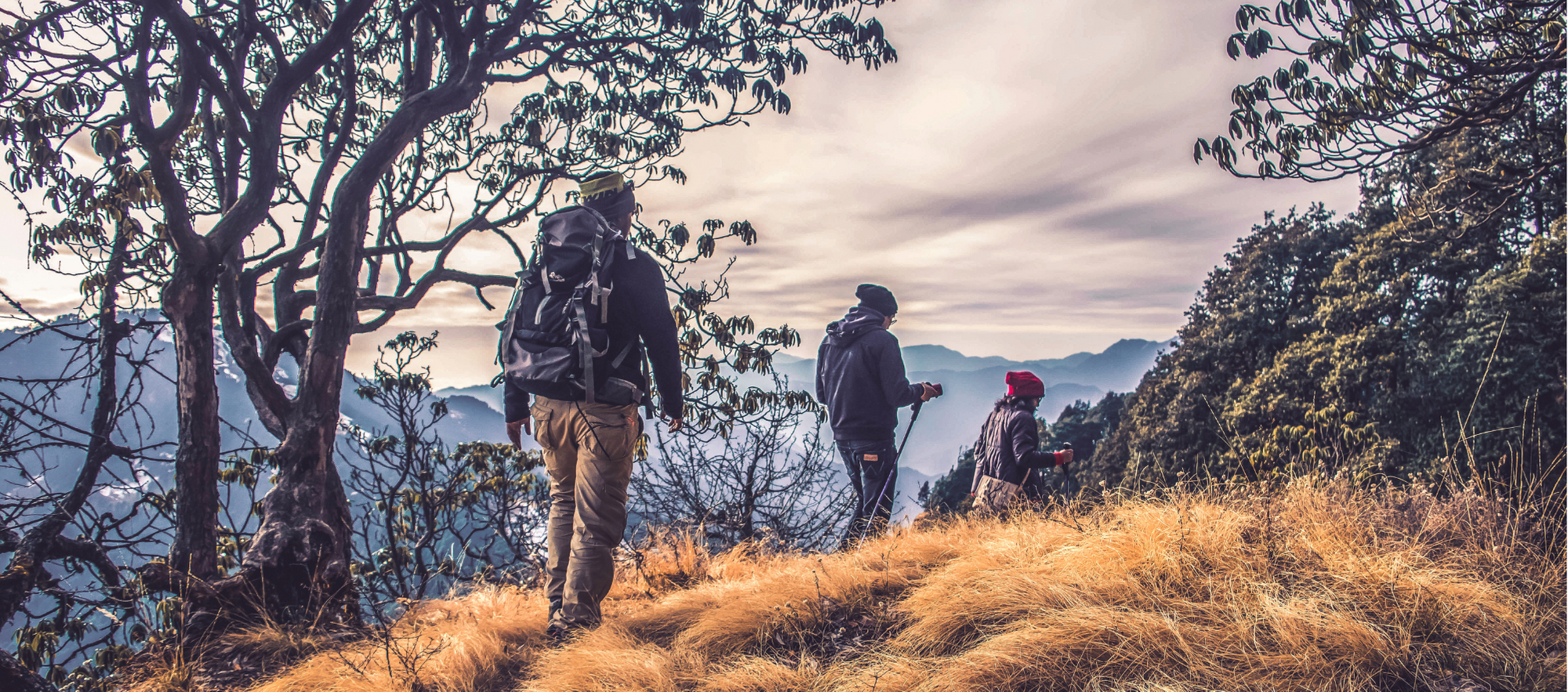
abhishek gaurav, Pexels
Inclusion must be at the heart of building back better the cultural tourism sector. Stakeholders at different levels should participate in planning and management, and local communities cannot be excluded from benefitting from the opportunities and economic benefits of cultural tourism. Moreover, they should be supported and empowered to create solutions from the outset, thus forging more sustainable and scalable options in the long-term. Policy-makers need to ensure that cultural tourism development is pursued within a wider context of city and regional strategies in close co-operation with local communities and industry. Businesses are instrumental in adopting eco-responsible practices for transport, accommodation and food. A balance between public/ private investment should also be planned to support an integrated approach post-crisis, which ensures input and support from industry and civil society.
The COVID-19 crisis has highlighted the essential role of museums as an integral component of societies in terms of well-being, health, education and the economy. Digitalization has been a game-changer for many cultural institutions to remain operational to the greatest extent possible. Yet there are significant disparities in terms of infrastructure and resources, which was underscored when the world shifted online. Museums in SIDS have faced particular difficulties with lack of access to digitalization. These imbalances should be considered in post-crisis strategies.
The pandemic presents an occasion to deeply rethink tourism for the future, and what constitutes the markers and benchmarks of “success”. High-quality cultural tourism is increasingly gaining traction in new strategies for recovery and revival, in view of contributing to the long-term health and resilience of the sector and local communities. Similarly, many countries are exploring ways to fast track towards greener, more sustainable tourism development. As such, the pandemic presents an opportunity for a paradigm shift - the transformation of the culture and tourism sectors to become more inclusive and sustainable. Moreover, this includes incorporating tourism approaches that not only avoid damage but have a positive impact on the environment of tourism destinations and local communities. This emphasis on regenerative tourism has a holistic approach that measures tourism beyond its financial return, and shifts the pendulum towards focusing on the concerns of local communities, and the wellbeing of people and planet.

Entabeni Game Reserve in South Africa by SL_Photography
Related items
More on this subject.

Other recent news
Cultural Tourism
- Living reference work entry
- Latest version View entry history
- First Online: 25 April 2023
- Cite this living reference work entry

- Shinji Yamashita 3
16 Accesses
There are two ways of defining culture which deserve attention for understanding cultural tourism. First, culture is defined anthropologically as a “way of life” including everything from food to religion. Second, there is another definition in which culture is taken in a more restricted way such as “art.” This usage was originated in the nineteenth century but is still used widely.
It is important to consider the dynamic relationship of the two definitions of culture. This is particularly the case when considering culture as a tourism resource (Yamashita 2015 ). For example, terraced rice fields in Bali, Indonesia, are seen anthropologically as part of Balinese agricultural system. However, they could become tourism resources when they attract tourists and are appreciated as a “cultural landscape.” Culture, in this way, becomes a tourism resource by transforming from local “ways of life” to an object of aesthetic consumption. In 2017, during the UNWTO’s 22nd general assembly, cultural...
This is a preview of subscription content, log in via an institution to check access.
Access this chapter
Institutional subscriptions
Beck, U., A. Giddens, and S. Lash. 1994. Reflexive modernization: Politics, tradition and aesthetics in the modern social order . Cambridge: Polity Press.
Google Scholar
Higgings-Desbiolles, F., A. Doering, and B. Bigby, eds. 2021. Socialising tourism: Rethinking tourism for social and ecological justice . London: Routledge.
Picard, M. 1996. Bali: Cultural tourism and touristic culture . Singapore: Archipelago Press.
UNWTO. 2021. Tourism and culture . https://www.unwto.org/tourism-and-culture . Accessed 27 July.
Yamashita, S. 2003. Bali and beyond: The exploration of the anthropology of tourism . New York: Berghahn.
———. 2015. The Balinese subak as world cultural heritage: In the context of tourism. In Recent developments in Bali tourism: Culture, heritage, and landscape in an open fortress , ed. I. Nyoman Darma Putra and Siobhan Campbell, 116–144. Denpasar: Buku Arti.
———. 2021. Public tourism: New forms of tourism after the Great East Japan Earthquake. In Socialising tourism: Rethinking tourism for social and ecological justice , ed. F. Higgings-Desbiolles et al., 161–174. London: Routledge.
Chapter Google Scholar
Download references
Author information
Authors and affiliations.
The University of Tokyo, Tokyo, Japan
Shinji Yamashita
You can also search for this author in PubMed Google Scholar
Corresponding author
Correspondence to Shinji Yamashita .
Editor information
Editors and affiliations.
School of Hospitality Leadership, University of Wisconsin-Stout, Menomonie, WI, USA
Jafar Jafari
School of Hotel and Tourism Management, The Hong Kong Polytechnic University, Hong Kong, Hong Kong
Honggen Xiao
Section Editor information
Department of Geography and Environmental Studies, University of Haifa, Haifa, Israel
Yoel Mansfeld Ph.D
Rights and permissions
Reprints and permissions
Copyright information
© 2023 Springer Nature Switzerland AG
About this entry
Cite this entry.
Yamashita, S. (2023). Cultural Tourism. In: Jafari, J., Xiao, H. (eds) Encyclopedia of Tourism. Springer, Cham. https://doi.org/10.1007/978-3-319-01669-6_45-2
Download citation
DOI : https://doi.org/10.1007/978-3-319-01669-6_45-2
Received : 09 March 2021
Accepted : 22 September 2022
Published : 25 April 2023
Publisher Name : Springer, Cham
Print ISBN : 978-3-319-01669-6
Online ISBN : 978-3-319-01669-6
eBook Packages : Springer Reference Business and Management Reference Module Humanities and Social Sciences Reference Module Business, Economics and Social Sciences
- Publish with us
Policies and ethics
Chapter history
DOI: https://doi.org/10.1007/978-3-319-01669-6_45-2
DOI: https://doi.org/10.1007/978-3-319-01669-6_45-1
- Find a journal
- Track your research
Cultural Tourism: Definitions, Types, Advantages & Disadvantages, or Stakeholders of Cultural Tourism
Cultural tourism is a rapidly growing segment within the global travel industry, catering to individuals seeking to immerse themselves in local populations’ customs, traditions, and lifestyles. It combines the elements of leisure with an authentic experience of a destination’s unique historical, architectural, artistic, and culinary aspects. As a result, this form of tourism allows travellers to gain a deeper appreciation and understanding of different societies and their cultural characteristics.
In recent years, the demand for cultural tourism has been on the rise as more people are interested in exploring foreign customs and cultural experiences beyond the typical tourist attractions. This trend fosters cross-cultural connections and mutual understanding and creates positive economic and social impacts on local communities. By preserving and showcasing their traditions, local people have the opportunity to generate income and employment while maintaining a sense of pride in their cultural heritage.
With the increasing focus on sustainability and responsible tourism practices, cultural tourism sets itself apart by emphasizing the importance of engaging with local communities, adhering to ethical standards and minimizing negative impacts on the environment. As such, it presents a viable option for tourists who wish to expand their horizons while also contributing positively to the places they visit.
Table of Contents
Understanding cultural tourism.
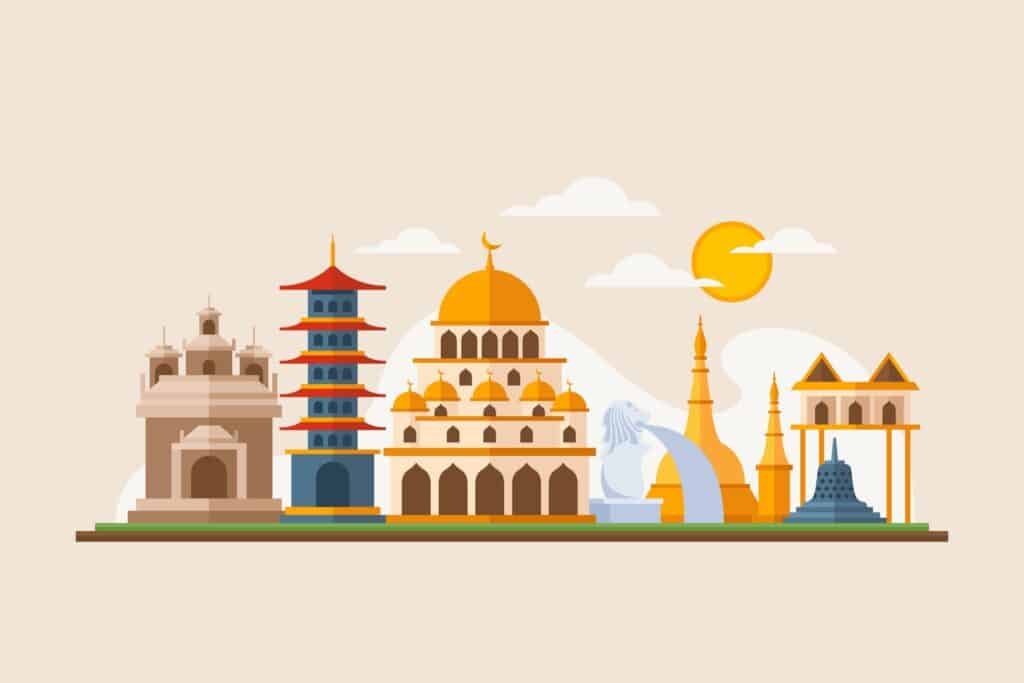
Cultural tourism is a significant and growing aspect of the global tourism industry. The United Nations World Tourism Organization (UNWTO ) defines cultural tourism as the movement of people to cultural attractions away from their normal residence, with the intention of gathering new information and experiences that satisfy their cultural needs. It encompasses various activities undertaken by tourists to explore and experience different cultures, customs, and traditions.
One of the key aspects of cultural tourism is the opportunity it provides visitors to learn and engage with local communities, their history, and their way of life. This tourism is more than just visiting heritage sites or attending cultural events; it involves understanding and experiencing how people from different cultures live, express themselves through art, and maintain their traditions.
Cultural tourism fosters mutual understanding and respect between people from different cultural backgrounds. It encourages dialogue and exchange, breaking down social and cultural barriers and contributing to more tolerant societies. This form of tourism is an essential aspect of sustainable tourism development, as it seeks to preserve precious heritage for future generations while supporting economic growth for local communities.
As the tourism industry continues to grow, the demand for unique and authentic experiences increases. Cultural tourism serves to meet this demand by offering visitors the opportunity to immerse themselves in various cultural settings, fostering a deeper understanding of the world and its diverse cultures.
Importance of Cultural Tourism
Cultural tourism plays a significant role in society as it helps preserve and promote the values, beliefs, traditions, and heritage that define a particular culture. It allows individuals and communities to exhibit unique perspectives on arts, rituals, folklore, music, literature, language, oral traditions, and other cultural elements. Cultural tourism serves as a bridge between societies, aiding in fostering mutual respect, tolerance, and understanding among various cultures.
Economic benefits are also apparent through cultural tourism. Visitors contribute to the local economy, supporting local businesses and sustaining host communities’ cultural products and experiences. By engaging in cultural tourism, visitors gain an authentic understanding of indigenous and local cultures, empowering them to appreciate the rich diversity and uniqueness of the world.
Furthermore, cultural tourism helps preserve cultural heritage, vital for maintaining a sense of identity and continuity for future generations. This preservation and promotion of different cultures provide a sense of pride and belonging for people who are part of those traditions. In turn, this enhances cultural exchange, allowing individuals to learn about other ways of life while appreciating their values and beliefs.
Cultural tourism also supports the sustainability of performing arts and other creative industries. Through various interactions with artists and performers, visitors can develop an appreciation for a wide range of artistic expressions, contributing to the overall vitality of the art world.
Through the development of cultural tourism, a society can showcase its cultural heritage while contributing to its economic prosperity. By embracing the importance of cultural tourism, we can foster a greater understanding, appreciation, and celebration of the rich tapestry of customs, beliefs, and traditions that make up the world’s diverse cultures.
Types of Cultural Tourism
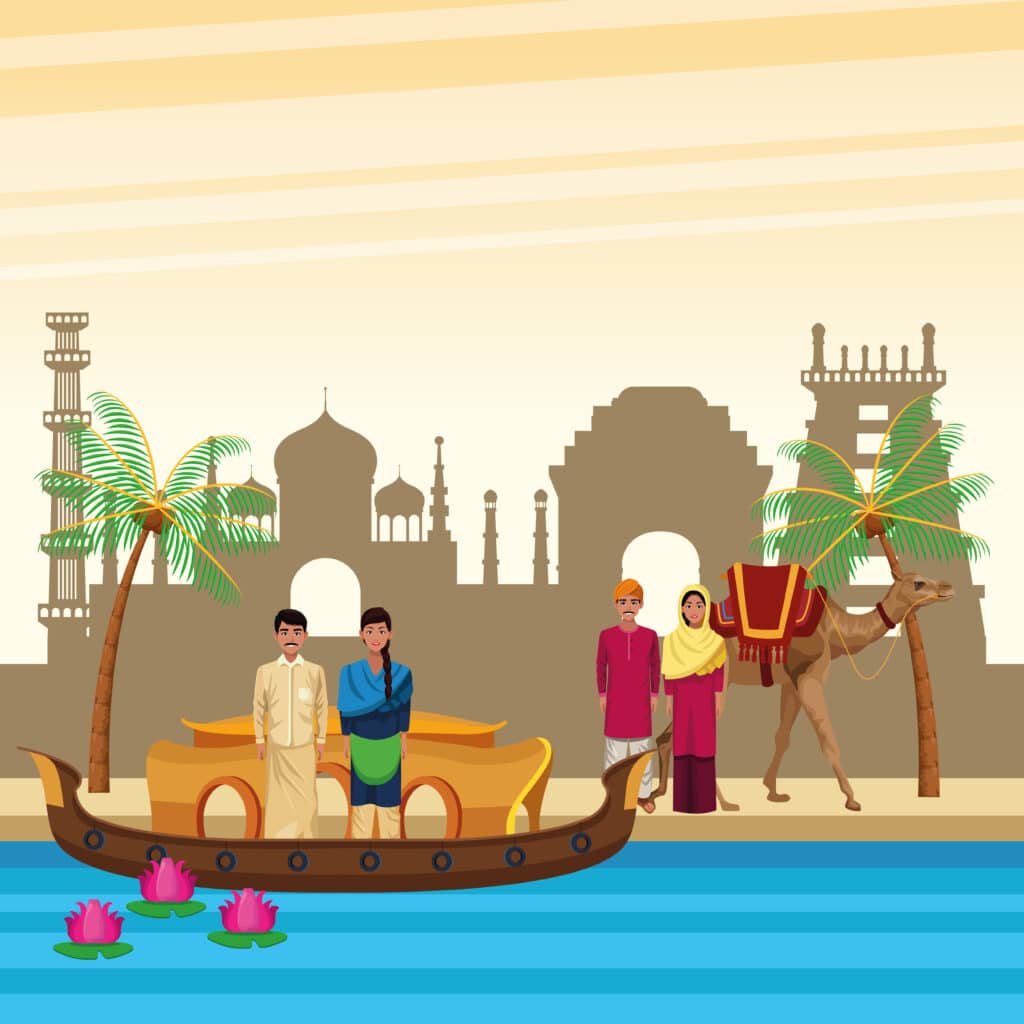
Cultural tourism allows travellers to immerse themselves in the history, heritage, and traditions of different places around the world. This form of tourism can be categorized into several types, each offering a unique way for visitors to experience and appreciate local cultures.
One type of cultural tourism is Historical and Heritage Tourism . This focuses on exploring sites related to a region’s past, such as ancient archaeological sites, monuments, and museums. It can instil a sense of wonder and appreciation for past civilizations’ achievements and teach travellers about the history of the places they visit.
Moving to the artistic side, Arts Tourism highlights the creative aspects of a culture. Tourists visit galleries, theatres, and concerts to experience local art, music, dance, and drama. It allows them to understand different communities’ aesthetic and expressive tendencies, opening their minds to new perspectives and forms of creativity.
Religious and Spiritual Tourism is another common form, where tourists visit religious sites, such as temples, churches, and mosques, or engage in spiritual practices like meditation and yoga. This type of cultural tourism can provide insights into various societies’ belief systems and rituals, fostering understanding and tolerance among people of different faiths.
However, culture isn’t just about history, arts, and religion but also daily life. Ethno and Indigenous Tourism involves tourists visiting and interacting with indigenous communities to learn about their customs, way of life, and unique perspectives on the world. This type of cultural tourism encourages empathy and cross-cultural understanding while emphasising respect for indigenous people’s rights and dignity.
Lastly, Culinary and Agritourism put emphasis on local food and drink traditions, as well as the agricultural practices that underpin them. This type of tourism can include attending food festivals, partaking in cooking classes or workshops, and visiting farms, vineyards, or breweries. Culinary experiences help tourists understand the richness of a region’s flavours and the relationship between local communities and their land and resources.
In summary, cultural tourism comes in various forms, appealing to different interests and tastes. It offers travellers a chance to explore and interact with diverse cultures, fostering connections and understanding among people around the world.
Forms of Cultural Tourism
Cultural tourism offers a wide range of experiences for travellers who seek to immerse themselves in different cultures, traditions, and ways of life. Various forms of cultural tourism cater to different interests and preferences.
Museums and galleries play a significant role in cultural tourism as they showcase a certain location’s history, art, and culture. Examples include art galleries displaying local and international masterpieces and museums featuring exhibits about the history and development of a specific region or theme.
Monuments and historic sites attract cultural tourists interested in exploring the past. Famous landmarks, archaeological sites, and heritage buildings tell the stories of civilizations and cultures that once thrived. UNESCO World Heritage Sites are often at the top of travellers’ lists, representing the world’s most significant cultural and natural heritage.
Architecture as a form of cultural tourism exposes tourists to varying architectural styles and meanings. Walking tours, cityscapes, and visits to iconic buildings provide a deeper understanding of a city’s architectural design’s cultural, social, and political influences.
Festivals and special events are another important aspect of cultural tourism, highlighting a particular community’s local customs and practices. These may include carnivals, parades, performances, traditional dances, and food festivals that provide a unique insight into the cultural identity of a place.
Gastronomy and cuisine play an integral role in the cultural tourism experience, as they allow tourists to savour the flavours and ingredients unique to a location. Local markets, food tours, cooking classes, and traditional restaurants all offer opportunities to appreciate the culinary heritage of a destination.
Shopping for crafts and textiles is a popular form of cultural tourism, as it allows travellers to bring home tangible memories of their journeys. Local artisans may showcase their talents through handmade textiles, pottery, jewellery, and other crafts, reflecting their community’s cultural heritage and artistic expression.
Cultural tourism encompasses diverse experiences, enabling travellers to engage with their chosen destination’s rich history, art, architecture, events, cuisine, and crafts. By exploring these varied aspects, visitors can deepen their understanding and appreciation of the world’s unique cultural landscapes.
Tangible and Intangible Cultural Attractions
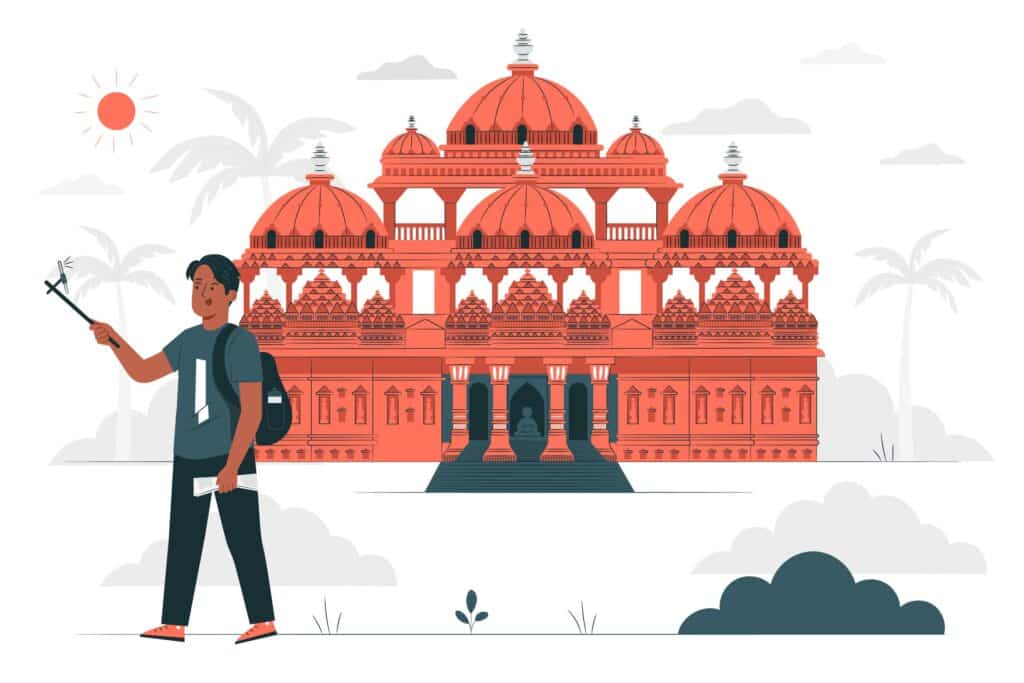
Cultural tourism often focuses on two major aspects: tangible and intangible cultural attractions. These attractions shape a destination’s identity, providing depth and context for visitors and facilitating cultural exchange. This section will explore various facets of tangible and intangible attractions, comprehensively understanding their significance and diversity.
Tangible cultural attractions encompass elements of history, arts, and architecture that visitors can physically experience. Notable examples include monuments, visual art, and crafts that showcase local communities’ unique skills and traditions. Such attractions often reflect centuries of evolution and showcase the ingenuity of a region’s inhabitants. By visiting these sites and engaging with these art forms, travellers gain firsthand insights into the cultural heritage of their destination.
On the other hand, intangible cultural attractions comprise the non-material aspects of a culture that contribute to its unique characteristics and traditions. Music, social practices, festive events, and customs are some of the intangible elements that enrich the cultural landscape of a tourist destination. Interaction with local people plays a crucial role in understanding the region’s intangible cultural attractions, as they act as custodians of these traditions and their oral histories.
A dynamic interplay exists between tangible and intangible cultural attractions, creating a vibrant, multi-dimensional experience for tourists. For instance, the physical structure in architectural landmarks represents the tangible aspect, while the stories, legends, and rituals connected to the site contribute to its intangible allure. This symbiotic relationship reflects the essential interdependence between culture’s material and immaterial aspects.
In conclusion, tangible and intangible cultural attractions are indispensable pillars of cultural tourism. They provide an enriching experience for visitors and play a vital role in preserving and promoting a destination’s unique cultural heritage. Both aspects should be regarded with equal importance and cultivated to ensure a comprehensive and engaging experience for travellers seeking to explore a destination’s cultural offerings.
Advantages of Cultural Tourism
Cultural tourism provides a unique opportunity for individuals to immerse themselves in a particular society’s history, traditions, and customs. In doing so, they can develop a deeper understanding and appreciation of the diverse cultures that make up the world.
One significant advantage of cultural tourism is its potential to boost local economies. Tourist expenditures in local businesses such as hotels , restaurants, and shops can contribute to the growth and development of a region. Additionally, cultural tourism can create jobs, especially for local artisans, performers, and guides who offer authentic cultural experiences to visitors.
Another benefit of cultural tourism is the preservation and revitalization of cultural heritage. By attracting tourists interested in learning about and experiencing different traditions, communities are encouraged to preserve and maintain their cultural assets, such as historic sites, museums, and festivals. This helps ensure that future generations can continue to enjoy and learn from these valuable resources.
Cultural tourism also fosters cross-cultural understanding and appreciation. As people engage with diverse cultures, they may develop a broader perspective and a greater respect for cultural differences. This can lead to increased tolerance and harmony among different societies.
However, it is important to be aware of the potential disadvantages of cultural tourism. For instance, there may be issues related to overcrowding, environmental impact, or the commodification of cultural traditions. This makes it crucial to manage cultural tourism responsibly, ensuring it benefits both the tourists and the host communities.
Disadvantages of Cultural Tourism
Cultural tourism has gained popularity in recent years, drawing visitors from around the globe to experience and appreciate diverse cultures. However, this type of tourism also brings several disadvantages that must be considered.
One significant drawback of cultural tourism is the potential for commodification of cultures. As communities open their doors to tourists, they risk losing the authenticity and uniqueness of their cultural identity. Traditional practices and artefacts may be tailored to appeal to the tourist market, diluting their cultural significance.
Moreover, cultural tourism can put pressure on resources and spaces used by local communities. The influx of tourists may lead to overcrowding and increased competition for essential amenities. This could negatively impact the quality of life for local residents and strain the available infrastructure.
Another issue is the potential for environmental degradation resulting from cultural tourism. Some tourist activities may involve access to sensitive natural areas, leading to erosion, pollution, or disturbance of wildlife habitats. The construction of tourist facilities and infrastructure can also threaten the environment.
Lastly, cultural tourism can contribute to the unequal distribution of economic benefits. While some members of the community may profit from tourism-related businesses, others may not be able to participate in or benefit from these enterprises. This could exaggerate income disparities and create economic imbalances within communities.
In conclusion, despite cultural tourism’s numerous benefits to travellers and host communities, it is crucial to acknowledge and address its potential negative aspects. To ensure the long-term success of cultural tourism, policies and practices must be implemented that prioritize the protection of cultural and environmental resources and promote equitable distribution of economic benefits.
Cultural Tourism Destinations

Cultural tourism is a popular type of travel that allows visitors to immerse themselves in various destinations’ history, heritage, and traditions. Throughout the world, numerous places provide rich cultural experiences for travellers. Here, we explore a few notable cultural tourism destinations.
China is a vast and diverse country with a history dating back thousands of years. One can explore the architectural wonders of the Great Wall, the Terracotta Army in Xi’an, or the magnificent Forbidden City in Beijing. Visiting local markets and trying traditional cuisine also adds to the cultural experience in China.
India is another top destination for cultural tourism, offering many historical sites and vibrant traditions. The Taj Mahal in Agra, a UNESCO World Heritage Site, is a must-see with its iconic marble mausoleum. Another popular destination is Rajasthan , where the colourful cities and the royal palaces, such as the spectacular City Palace of Jaipur, offer a glimpse into the past.
France , specifically Paris , provides visitors with rich art, architecture, and cuisine. Iconic sites such as the Louvre, Notre Dame Cathedral, and the Eiffel Tower showcase the country’s artistic and architectural achievements throughout history.
Similarly, Spain is renowned for its rich cultural heritage with attractions such as the Alhambra in Granada, the Park Güell in Barcelona, designed by Gaudí, and the Prado Museum in Madrid.
Turkey , especially Istanbul , offers an intricate blend of European and Asian influences, with historic sites such as the Hagia Sophia, the Blue Mosque, and the Topkapı Palace. Moreover, the open-air bazaars and Turkish baths deliver an authentic cultural experience.
Italy , the birthplace of the Renaissance, is brimming with artistic and architectural masterpieces. Cities like Rome, Florence, and Venice are steeped in history, allowing visitors to marvel at landmarks like the Colosseum, St. Peter’s Basilica, or the Uffizi Gallery.
The beautiful island of Bali in Indonesia is known for its lush landscapes, Hindu temples, and vibrant arts scene, making it an excellent location for immersing oneself in the culture of the region.
Uzbekistan has gained attention recently as tourism grows along the Silk Road route. Visitors can admire the stunning architecture and mosaics of cities such as Samarkand, Bukhara, and Khiva, which capture the rich heritage of the ancient trading route.
In conclusion, cultural tourism invites travellers to explore fascinating destinations across the globe. While each location offers unique experiences, they provide a deeper understanding of human history, traditions, and heritage.
Stakeholders of Cultural Tourism
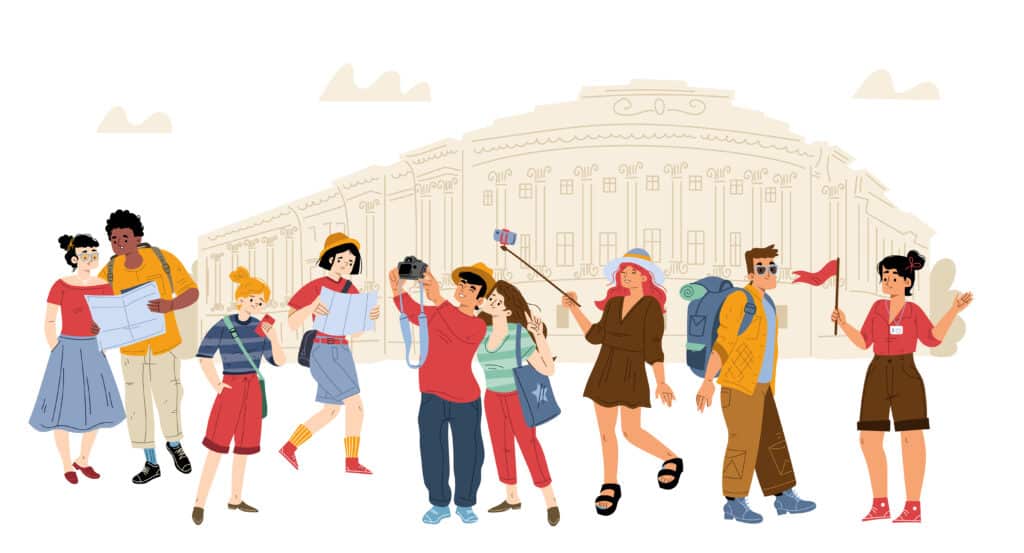
Cultural tourism is a multi-faceted industry that brings value to travellers in search of authentic experiences and to a myriad of stakeholders. From local communities to government bodies and from small businesses to environmental conservation efforts, cultural tourism can shape economies and lifestyles in both positive and negative ways. This guide delves into the key stakeholders in the cultural tourism sector, exploring their roles, impacts, and interconnected interests.
Tourists: The Heart of the Industry
Arguably, tourists are the backbone of cultural tourism. Whether they are history enthusiasts seeking out ancient ruins or gastronomes on the hunt for authentic local cuisine, tourists drive demand and shape the landscape of the tourism industry. They often seek enriching experiences that can offer a deep understanding of local cultures.
Local Communities: The Soul of the Destination
Local communities provide the lived experience that many cultural tourists seek. These people preserve the traditions, language, and heritage sites that form the basis of cultural tourism. Unfortunately, they can also bear the brunt of poorly managed tourism through cultural commodification and environmental degradation.
Government Bodies: The Framework Providers
Local and national governments play an instrumental role in regulating and promoting cultural tourism. They invest in infrastructure, enforce zoning laws, and facilitate public services like safety and sanitation that are vital to the tourism industry.
Tourism Boards and Agencies: The Promoters
Tourism boards, often funded by governments, are responsible for marketing a destination’s cultural assets to the world. These bodies work closely with other stakeholders to develop tourism packages, advertise local attractions, and even set guidelines for responsible tourism.
Tour Operators and Travel Agents: The Experience Curators
Specializing in delivering personalized experiences, these businesses are intermediaries between tourists and destinations. They can make or break the quality of the cultural tourism experience through their choices of local partnerships, itineraries, and guides.
Cultural Institutions: The Keepers of Heritage
Museums, art galleries, and historical sites are essential touchpoints for cultural tourists. They collaborate closely with various stakeholders to ensure that cultural assets are preserved and made accessible to the public.
Artisans and Performers: The Artistic Impressions
Artisans and performers add texture to the cultural fabric of a destination. These stakeholders benefit from increased visibility and economic opportunities , providing tourists a gateway to the authentic local culture.
Small Business Owners: The Local Economy Boosters
From restaurants and cafes to souvenir shops, small businesses see a surge in revenue when cultural tourism is thriving. They form a vital part of the local economy, providing services that enrich the tourist experience.
Academics and Researchers: The Thought Leaders
Cultural tourism is a field ripe for academic inquiry, touching upon anthropology, economics, and sociology disciplines. Research in this area can help shape policies that benefit tourists and local communities.
NGOs: The Advocates of Sustainability
Organizations that focus on cultural or environmental conservation often align with the interests of responsible cultural tourism. They act as watchdogs and advocates, ensuring that tourism practices are sustainable and ethical.
Real Estate Developers: The Infrastructure Builders
Though not directly related to the culture, real estate is essential in accommodating the influx of tourists, especially in booming destinations. They must balance business interests with responsible development.
Media: The Influencers
Media outlets, including travel bloggers and journalists, have a significant role in shaping public perception of a destination. Their storytelling can amplify the benefits or expose the pitfalls of cultural tourism.
The Environment: The Unspoken Stakeholder
Although not a traditional “stakeholder,” the environment stands to be significantly affected by tourism activities. Sustainable practices must be adopted to preserve the natural and cultural landscapes that attract visitors in the first place.
Understanding the intricate web of stakeholders in cultural tourism is the first step in creating an industry that benefits all. As cultural tourism evolves, stakeholders must actively dialogue to ensure sustainable and enriching experiences for everyone involved.
Cultural Tourism Experience
Cultural tourism experiences provide a unique opportunity for travellers to immerse themselves in the local culture, customs, and traditions of the places they visit. These immersive travel experiences enable tourists to understand the heritage and identity of the communities they encounter.
One popular way to experience cultural tourism is through homestays. These accommodations offer the chance to live with a local family, providing a firsthand glimpse into their daily lives and customs. The cultural exchange within a homestay environment can be transformative, offering insights that would otherwise remain veiled during a typical sightseeing vacation.
Another important aspect of cultural tourism is engaging with the local communities, participating in their events and festivals, and learning about their history and heritage through interactions with the people there. These experiences enable travellers to connect meaningfully with locals, fostering mutual appreciation and understanding of different cultures.
Cultural experiences often focus on different dimensions, such as:
- Arts and crafts: Exploring local artisans’ craftsmanship and heritage by visiting workshops, galleries, and markets.
- Cuisine: Sampling regional culinary specialities can offer a taste of local culture, traditions, and history.
- Religious sites: Visiting places of worship offers insight into the spiritual beliefs and practices of the area.
- Performing arts: Engaging with local music, dance, and theatre performances can reveal unique cultural perspectives and expressions.
Cultural tourism emphasizes responsible travel and encourages visitors to respect and appreciate the local customs, traditions, and the natural environment while exploring new destinations. Tourists can create unforgettable memories by connecting with people from different backgrounds and gaining a deeper understanding of their practices and values, fostering greater global empathy and cultural appreciation.
- EN - English
- PT - Portuguese
- ES - Spanish
- How it works
- Become a Host
- Download the app
Top Destinations
- United States
- United Kingdom
What type of experience are you looking for?
- Non-Profit School
- Permaculture project
- Eco Village
- Holistic Center
- Guest House
- How Worldpackers works

Learn from the most experienced travelers of the community
Traveling with worldpackers, planning and budgeting for travel, make a living while traveling as a lifestyle, travel with worldpackers.
- Using Worldpackers
- Work exchange
- Social impact
Plan your trip
- Women traveling
- Budget travel
- Solo travel
- Language learning
- Travel tips
- Get inspired
- Digital nomads
- Travel jobs
- Personal development
- Responsible travel
- Connect with nature
Top destinations
- South America
- Central America
- North America
- More destinations
- WP Life WP Life
- Exclusive discounts Discounts
What is cultural tourism and how to make it part of your trips
Learn all about cultural tourism and find out about amazing destinations to live cultural experiences around the world.
Worldpackers Worldpackers
Jan 08, 2024
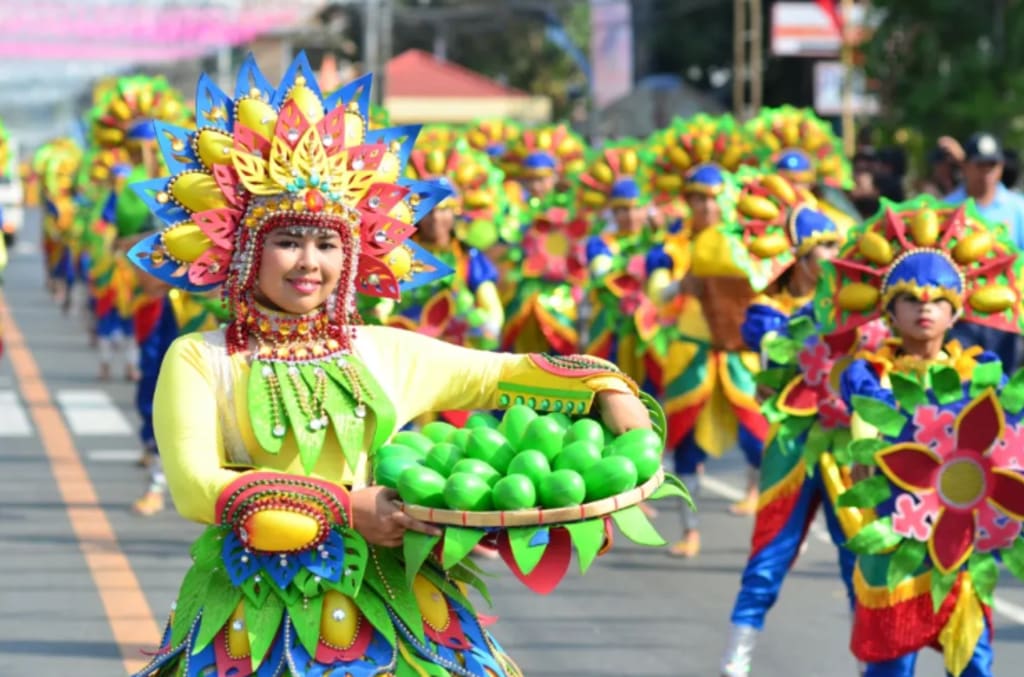
When you’re traveling, do you try to go beyond the surface and understand the different cultures that surround you? Then this article is for you. We will talk about the main characteristics of cultural tourism and will suggest 10 fascinating destinations with unique cultural aspects.
We will also tell you how you can have a deeper cultural immersion than a typical tourist , mixing with locals and learning from them while you get free accommodation.
You might also like to read:
- 20 ways to travel more intentionally
- 6 ways travel promotes learning and education
What is cultural tourism?
Cultural tourism is a form of travel that focuses on exploring and appreciating the unique traditions, history, and practices of a place . It is not just about visiting museums or attending festivals, but also delving deeply into the everyday aspects of local life. Authentic local food, local markets, and even casual chats with locals are an integral part of cultural tourism.
While a conventional tourist may seek relaxation and fun and focuses on visiting famous tourist places, the cultural tourist seeks to go beyond the superficial layer. They want to immerse themselves in local history, explore the unique customs of a region, and learn about its art and architecture. This type of experience is an opportunity to grow personally and empathize with people from different parts of the world.
Among the different types of cultural tourism, there are gastronomic tourism, rural tourism, religious tourism, ethnographic tourism, sports tourism, spiritual tourism, and voluntourism, to name a few.
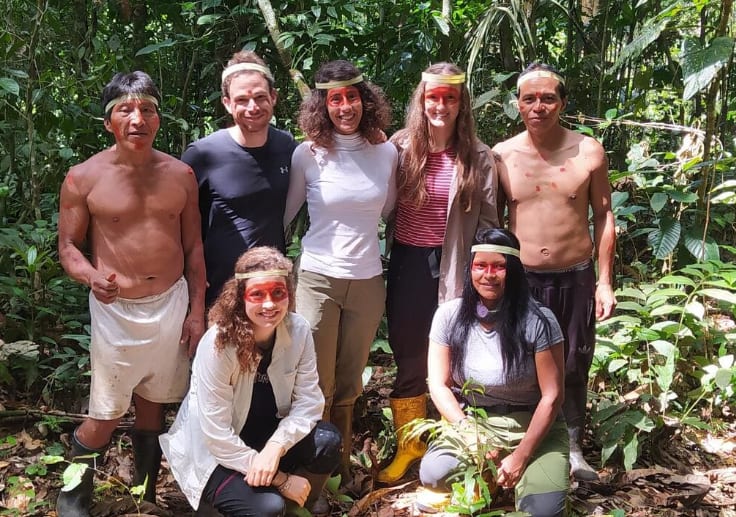
Characteristics of cultural tourism
A main characteristic of cultural tourism is the deep appreciation for different cultures . Travelers not only visit a place to see its natural or architectural beauties, but also to immerse themselves in its culture and understand it thoroughly.
Another important characteristic is the constant educational component that exists in this type of trip. You don't just learn about a new culture: you are also an active part of the cultural exchange while sharing your own customs and knowledge with local people.
Respect for cultural heritage is another indispensable condition for the cultural tourist, since not only the most famous tourist attractions are visited, but also places of great importance for local communities, such as natural sites with a strong mythology, ruins of ancient civilizations, or religious temples. They are spaces that house ancestral stories and traditions, which must be valued and preserved with the greatest care.
You might also be interested in: 5 actionable ways to live like a local while traveling
Importance of cultural tourism
Cultural tourism allows travelers to immerse themselves in the heart of a culture and learn about its history, customs, and traditions. But it's not just travelers who benefit from cultural tourism.
Local communities also have much to gain as this form of travel can be a powerful driver for local economic development. Income generated by tourism can be reinvested in community projects, helping improve infrastructure and boost local employment.
Role of the cultural traveler
When we embark on a cultural journey, we are much more than just passive spectators: we actively become respectful participants within these diverse communities. It is vital to understand that each culture has its own unique identity forged by centuries - sometimes millennia - of history.
As cultural travelers, our role is to learn and respect these differences. It is this open-mindedness that allows us to experience the intrinsic beauty of the varied ways in which humans interpret and express our existence .
Being a responsible tourist is central so that both parties can benefit from this exchange, since lack of respect or damage caused in the place visited can have irreparable consequences. Visiting a community with the sole objective of taking photos for social media, without being really interested in it, can ruin places in the long run.

10 places where you can practice cultural tourism
Cultural tourism can be practiced anywhere in the world since there are countless diverse cultures all around us. As you travel you will realize that there are many more than you thought, because even within the same country there can be dozens or even hundreds of ethnic groups with their own religion, beliefs, mythology, dialect, gastronomy and so on.
Below we will see some of the most favorable destinations for cultural tourism, but obviously the choice of where to go depends on your interests.
Kyoto, Japan
Kyoto is known as the cultural heart of Japan. With its intact Shinto shrines and ancient Buddhist temples – such as Kinkaku-ji (the Temple of the Golden Pavilion) – Kyoto offers travelers an authentic glimpse into Japan's imperial past.
Don't forget to participate in a tea ceremony and stroll through Gion, a famous geisha neighborhood full of traditional houses where the maiko learn what is necessary to become geishas.
Keep reading about Japan:
- Japan off the beaten path: discover 6 unique non-touristy destinations
- Japan on a budget: live like a local and save your dollars
- How to teach English in Japan: the easiest way
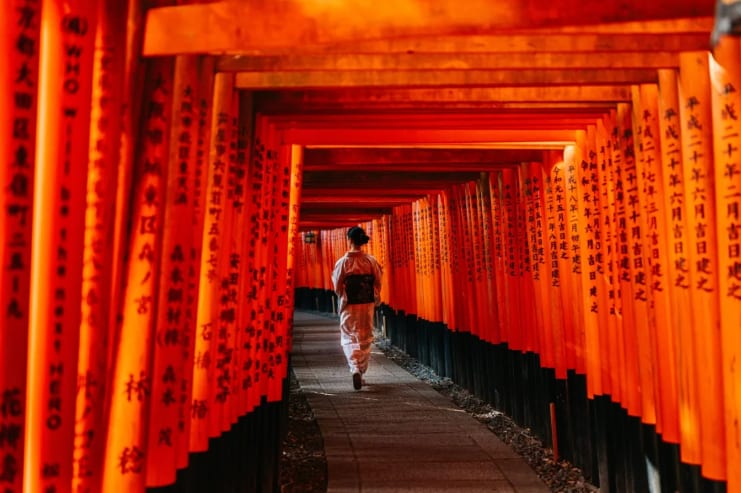
Ubud, Bali, Indonesia
Ubud is the cultural heart of Bali and a must-see destination for travelers looking to immerse themselves in the rich history and traditions of this mythical Indonesian island. This small town is surrounded by terraced rice fields, lush tropical forests and centuries-old Hindu temples that look like something straight out of a postcard.
Unlike the tourist bustle of Kuta, Canggu or Seminyak, Ubud offers a more authentic and immersive experience when exploring its surroundings. Here you can learn about Balinese customs, participate in craft workshops, or attend local cooking classes . In addition, its vibrant art scene will allow you to discover everything from traditional dances to contemporary art.
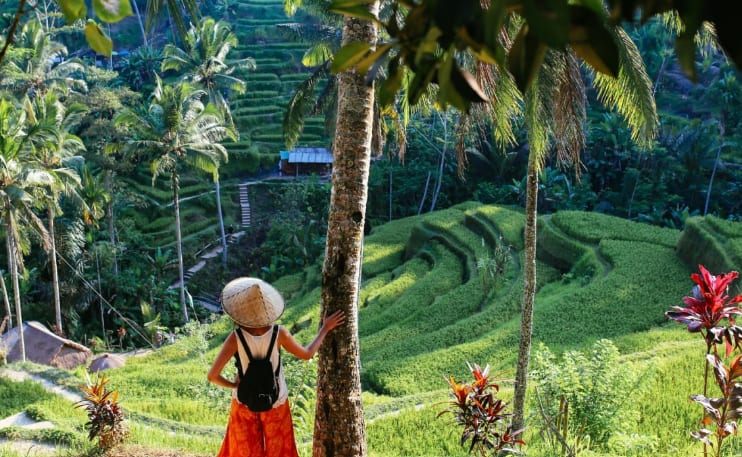
Dharamsala, India
Located in the northern region of India, Dharamsala is known for being the residence of the Dalai Lama and the center of the Tibetan government in exile . Here you can visit the Dalai Lama temple, where you can witness Buddhist ceremonies and better understand this ancient tradition.
Aside from its rich religious heritage, you will also find a fascinating mix of Indian cultures and Tibetan influences that are reflected in both local customs and cuisine. You can enjoy typical dishes such as momos (dumplings) or thukpa (a noodle soup), while interacting with the friendly locals.
Another must-see attraction is the Dhauladhar mountains that surround Dharamshala; perfect for those adventurers interested in hiking while enjoying spectacular panoramic views. There is also the unique opportunity to learn about traditional Ayurvedic medicine through educational workshops offered by local experts.
Keep reading: Discover India's top 3 best ecotourism destinations
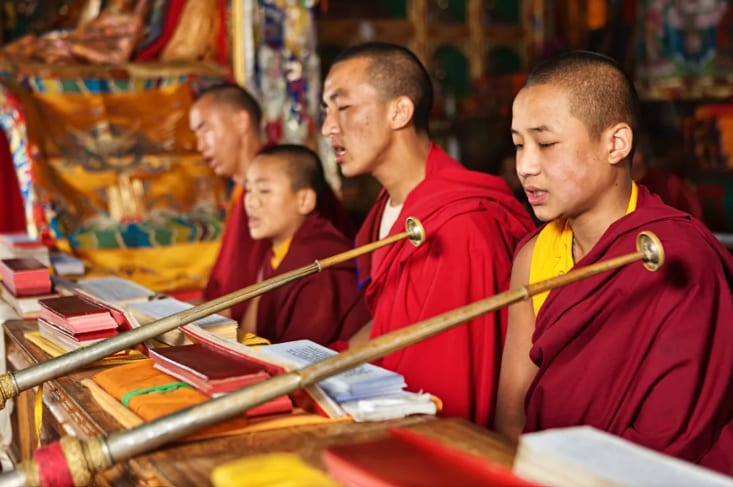
Marrakesh, Morocco
Marrakech, in Morocco , is famous for its medina or old town, declared a World Heritage Site by UNESCO. Here you can explore labyrinths of narrow alleys filled with colorful bazaars where local artisans sell their wares.
A visit to the imposing Bahia Palace or the Saadian tombs will transport you directly to Morocco's glorious past: it’s an impressive experience of cultural tourism.
You cannot miss the opportunity to try authentic Moroccan dishes , such as couscous or a delicious tagine while enjoying the lively and hypnotizing atmosphere in Jemaa el-Fna, one of the largest and busiest markets in the world.
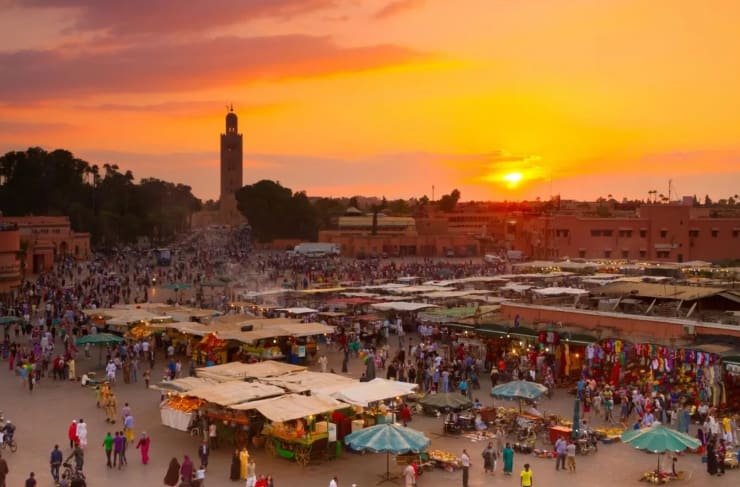
Istanbul, Turkey
Istanbul is an ideal destination for cultural tourism. This magical city is located at the crossroads between Europe and Asia, giving it a unique mix of Eastern and Western influences.
Its ancient history has left tangible traces that you can explore during your visit. From architectural wonders such as the Blue Mosque, the Topkapi Palace or the majestic Hagia Sophia to its bustling bazaars full of colors, aromas, and unique flavors.
Turkish culture has a lot to offer: its rich gastronomy with emblematic dishes such as kebab or baklava; its impressive ancestral religious traditions such as that of the dancing dervishes; and its palpable modernity in vibrant neighborhoods like Beyoğlu where contemporary art galleries coexist with bohemian cafes.
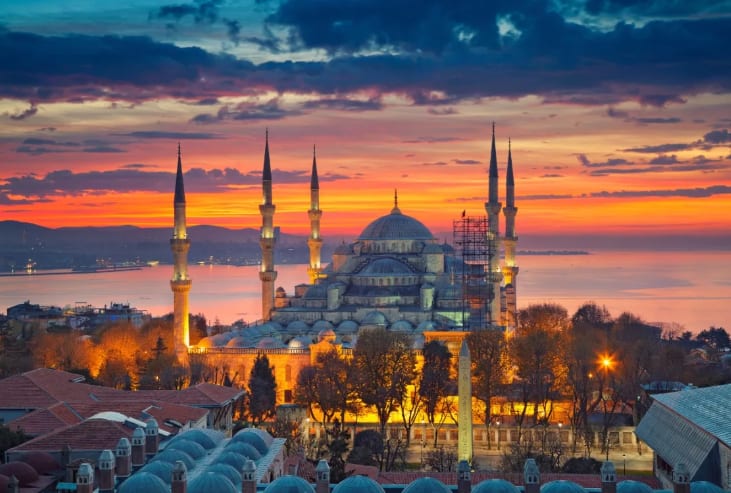
Rome, Italy
Rome, the "Eternal City", is a living museum. From the Colosseum to the Vatican, every corner tells a fascinating story about ancient Roman civilization and its impact on our society today, making it a classic destination for cultural tourism.
You can tour the ancient ruins of the Roman Forum and admire masterpieces of Renaissance art at the Vatican Museums. Every step through Rome allows you to immerse yourself deeply in its vibrant culture and rich history.
Keep reading : The 20 best places to visit in Italy
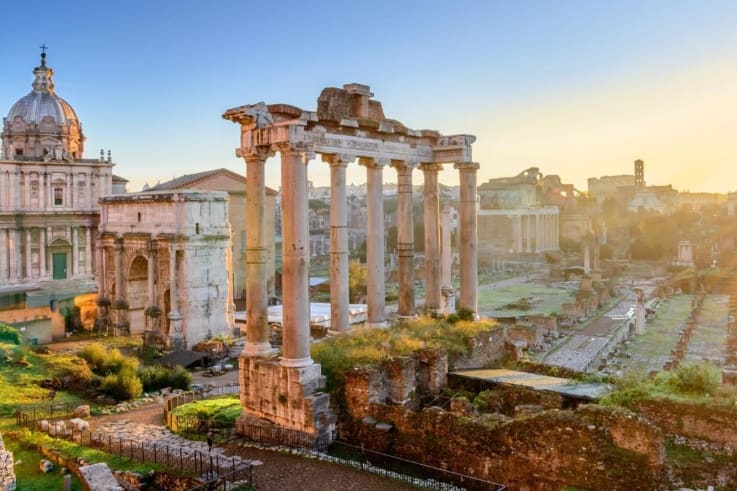
Granada, Spain
Known for its stunning Moorish architecture and charming cobblestone streets, Granada is another perfect destination for travelers looking to have a cultural tourism experience in Europe.
This Andalusian city, in the South of Spain, lies at the foot of the Sierra Nevada mountains and offers a unique mix of Moorish and Christian influences.
The Alhambra, a jewel of Islamic art with its intricate mosaics and hanging gardens, is its main tourist attraction, but there is much more in Granada. The UNESCO World Heritage neighborhood of Albayzín is full of winding streets where you can browse local shops or simply enjoy the panoramic views from one of the many viewpoints.
You also can't miss Sacromonte, famous for its gypsy caves converted into houses and even flamenco bars. Here you can experience an authentic flamenco nigh t, full of the passionate rhythm that characterizes this traditional dance from southern Spain.
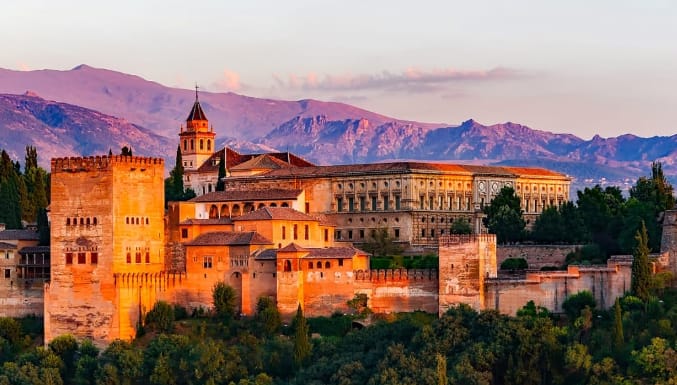
Salvador de Bahia, Brazil
Salvador is the capital of the state of Bahia and the fourth most populated city in Brazil . Founded in 1549 by the Portuguese, it was the most important center in the slave market, which over time led to an artistic culture where African expressions mixed with European and Indigenous influences.
No wonder it is one of the country’s most popular tourist destinations: it combines beautiful beaches with history, festivals, and traditions , being considered the cultural capital of Brazil.
Pelourinho is the old neighborhood of Salvador de Bahía, declared a World Heritage Site. Its cobbled streets are full of historical sites, colonial architecture, museums, restaurants, bars, hotels, musicians, and capoeira.
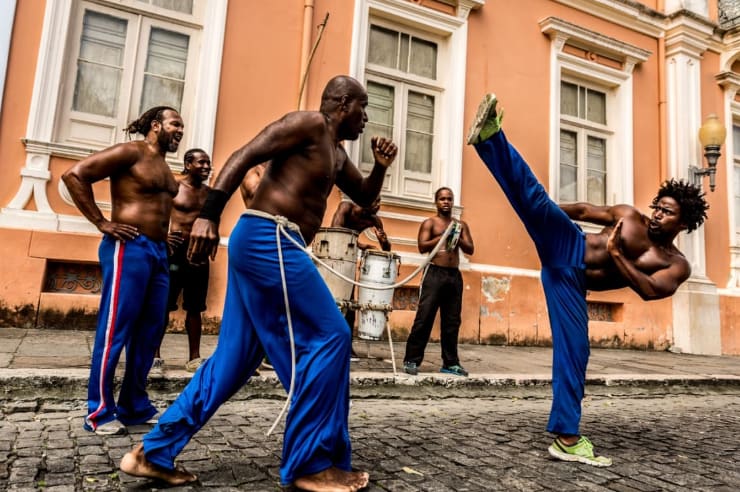
Cusco, Peru
The charm of Cusco, Peru , lies in its rich history and culture that have survived through time. This ancient Peruvian city is another perfect destination for travelers interested in cultural tourism in South America.
As the cradle of the Inca Empire, Cusco offers an unmatched experience. Here you can explore ancient Inca ruins such as the famous citadel of Machu Picchu, a must-see for any history and archeology lover.
You can also visit other historical sites such as Sacsayhuamán or Pisac. And if you are looking to immerse yourself even more in the local culture, there is nothing better than trying the exquisite Andean cuisine and participating in its colorful traditional festivals.
In addition to being a living museum full of archaeological treasures, Cusco is also known for its vibrant nightlife with numerous bars and clubs where you can enjoy folk music while mingling with locals and other international travelers.
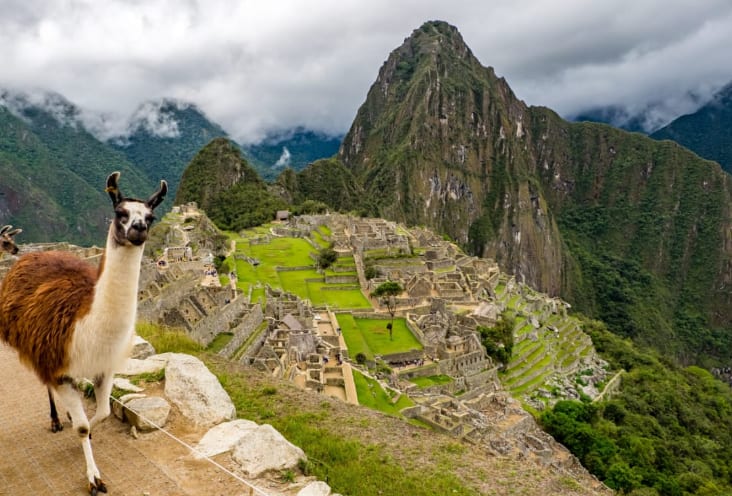
Guadalajara, Mexico
This vibrant city, known as the birthplace of mariachi, is full of history, traditions and art that reflect the richness of Mexican culture . You can stroll through the local squares where mariachi groups perform regularly or visit the famous Degollado Theater during one of its nightly shows.
But the cultural wealth of Guadalajara goes far beyond mariachi. The towns near this metropolis are famous for their impressive craft production . Tlaquepaque and Tonalá are two perfect examples: these places are full of workshops where you can watch artists work with clay, blown glass, and other ancient techniques to create wonderfully detailed pieces.
Guadalajara also offers a wealth of cultural and historical museums, as well as well-preserved colonial buildings that tell the history of Mexico . You cannot miss visiting the Hospicio Cabañas, an architectural jewel from the 19th century and a UNESCO World Cultural Heritage Site.
In addition, the city is surrounded by agave plantations, the plant that is used to produce tequila and mezcal.
You might also like : Ul timate list of the best places to visit in Mexico: the top 13
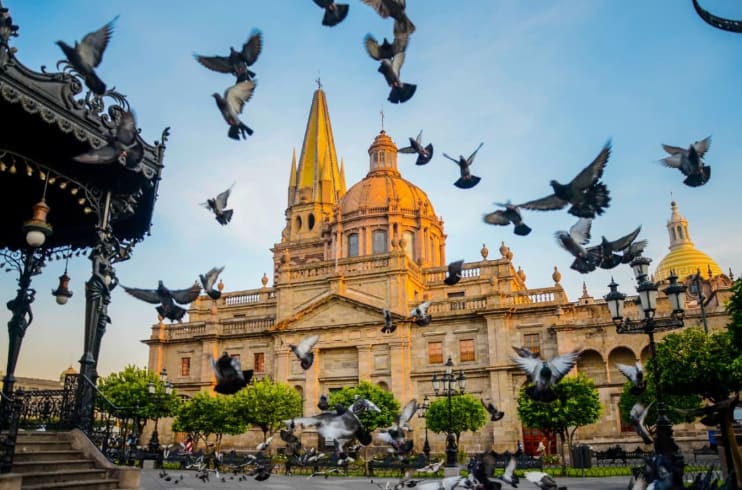
Discover different cultures with Worldpackers
An excellent way to have a true cultural immersion in the places you travel is by volunteering through Worldpackers . This platform facilitates an exchange of work for accommodation which allows for transformative and budget-friendly trips.
It’s quite simple: you lend a hand in different projects for a few hours a day , and in return you get free accommodation on site. Depending on the host, you might also get other benefits such as free meals and activities.
This type of trip is super cheap, but that’s not the best part. Volunteering with Worldpackers you can meet many people with similar interests to yours and develop new skills, such as learning a language , bartending, or bioconstruction.
From hostels in big cities to organic farms and holistic centers surrounded by nature , the possibilities are plenty. There are positions available in all of the countries mentioned in this article and much more: there are more than 140 countries available on the platform.
Keep reading :
- Collaborative tourism: what are collaborative travel relationships?
- 6 types of volunteer work abroad that give you free accommodation
- How to find volunteering opportunities around the world using Worldpackers
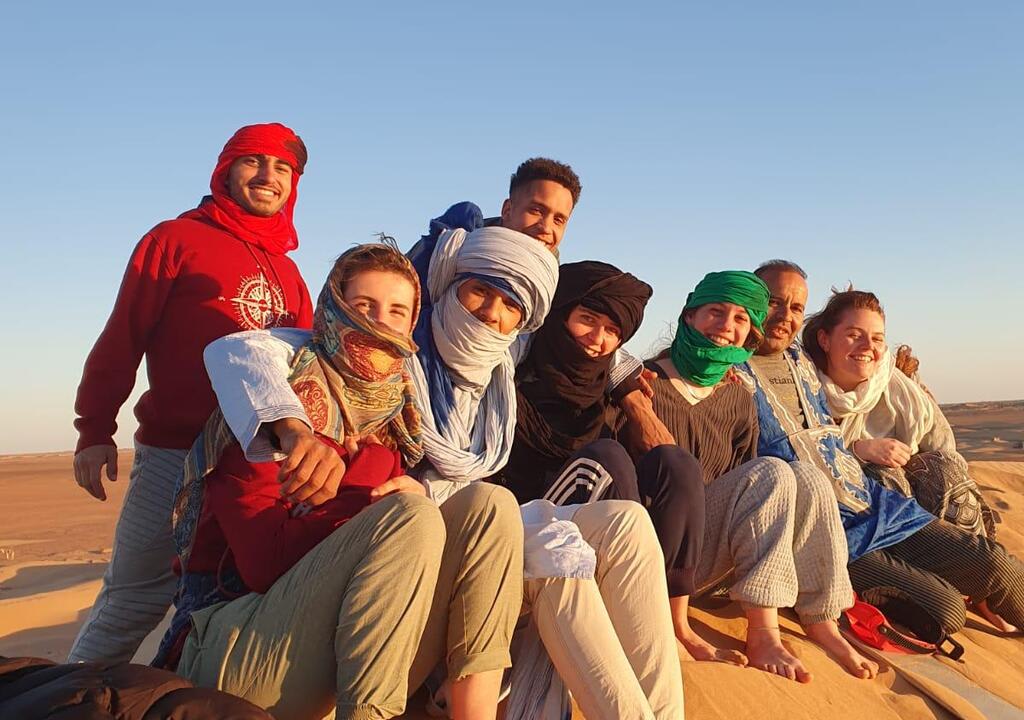
Did that spike your interest? Create a free profile on Worldpackers and start saving your favorite volunteering positions. And if you liked these tips on how to practice cultural tourism around the world, let us know in the comments section below!
Join the community!
Create a free Worldpackers account to discover volunteer experiences perfect for you and get access to exclusive travel discounts!
Worldpackers Editorial
Worldpackers.
The safest community to travel, volunteer and make a positive impact in +140 countries.
Be part of the Worldpackers Community
Already have an account, are you a host, leave your comment here.
Write here your questions and greetings to the author
Great trip!
More about this topic

What is cultural exchange and how to experience it?
The sustainable plate: tracking the origins of organic food.
Two Brothers
Volunteer trips: transform your life & impact, how do worldpackers trips work.
As a member, you can contact as many hosts and travel safely as many times as you want.
Choose your plan to travel with Worldpackers as many times as you like.
Complete your profile, watch the video lessons in the Academy, and earn certificates to stand out to hosts.
Apply to as many positions as you like, and get in contact with our verified hosts.
If a host thinks you’re a good fit for their position, they’ll pre-approve you.
Get your documents and tickets ready for your volunteer trip.
Confirm your trip to enjoy all of the safety of Worldpackers.
Have a transformative experience and make a positive impact on the world.
If anything doesn’t go as planned with a host, count on the WP Safeguard and our highly responsive support team!
After volunteering, you and your host exchange reviews.
With positive reviews, you’ll stand out to hosts and get even more benefits.
- Philippines
- South Korea
- National Parks
- Travel Stories
- How Much Does It Actually Cost to Travel the World?
- What’s In My Backpack: The Ultimate Long-Term Travel Packing List
- My Favorite Non-Fiction Travel Books
- All Budget Travel Resources
- Writing Portfolio
What is Cultural Travel? & How to Travel the World Immersively.
This post may contain affiliate links. This just means I may receive a small commission at no extra cost to you for helping them promote their product or service. I don’t endorse any services I don’t personally use or recommend.
Travel allows us to experience the world. But as we travel, we are also leaving our footprint on each and every place we visit. This is why culturally immersive travel is so important. Because the wrong kind of travel negatively impacts the world. & it can ruin travel for the rest of us.
One of the reasons we started this blog was to help others travel better . To feel comfortable getting off-the-beaten-path, interacting with locals, and learn to embrace experiences that at first feel foreign. To take you “ Beyond the traditional Bucketlist” if you will.
But often when I talk about “Immersive Travel” or “Cultural Travel” I’m confronted with confused faces. This blog post should clear that up.

What is Cultural Travel?
Or immersive travel. It’s one and the same.
Cultural travel is the right way to travel. & before you argue that there is no right way to travel …let me stop you right there. Because there is.
“Do we really want to travel in hermetically sealed popemobiles through the rural provinces of France, Mexico and the Far East, eating only in Hard Rock Cafes and McDonalds? Or do we want to eat without fear, tearing into the local stew, the humble taqueria’s mystery meat, the sincerely offered gift of a lightly grilled fish head? I know what I want. I want it all. I want to try everything once.” Anthony Bourdain
Side Note: I KNOW that people who only get 2-weeks off per year ( I’m looking at you America ) are often just looking for an easy destination with a beach to relax on. This isn’t travel . This is a vacation. & this post is in no way meant to make you feel like you’re vacationing “wrong”. It’s a different type of trip entirely.
Cultural travel is about experiencing and preserving the various traditions around the world. It’s about being open to new experiences and willing to step into another’s shoes. Cultural travel is jumping in with both feet and leaving your preconceived notions about what your trip should be behind you.
It’s eating local dishes. & sleeping in guesthouses. It’s meeting locals and building genuine connections. It’s learning about the complicated history of a country and leaving your trip with a greater understanding of the place you came to see and the people who live there.

Often times in today’s day and age ‘travelers’ will visit a country just to snap some photos of the famous sights to post on Instagram (ie. Bali swings, Thai beaches, leaning tower of Pisa… you know the drill) or to drink the night away, or even just to lounge on a tropical beach. But that kind of vacation can be detrimental to the very communities you’re traveling to.
If you’re interested in the negative effects the wrong kind of travel can have on the world check out this article I wrote for Lonely Planet in 2021.
Benefits of Immersive Travel
Beyond supporting the local communities and the preservation of local customs and traditions, you’ll also experience some personal benefits.
You’ll Blow Your Mind Wide Open
There’s simply no way to travel this way with a closed mind. You’ll get to know different cultures intimately and understand them a lot better. You’ll also become less judgmental of others the more you travel.
Build Your Confidence

Being able to navigate public transportation in any city in the world and find cheap local food is so rewarding. It’s why solo travel is such an amazing way to develop self-confidence and self-sufficiency. Getting outside your comfort zone & realizing that YOU CAN HANDLE IT, that no matter what the world throws at you, you know what to do is such a powerful feeling.
& you’ll only get that way through experience.
Unparalled Learning Experience
Forget about learning confidence…traveling this way is a great way to learn in general! It’s better than school. I got a ( very expensive ) 4-year degree from an American University & I learned 100x more from life on the road.

History, politics, environmental issues, and animal science…When you’re confronted with these subjects face-to-face you learn more. & it sticks with you. I can’t rattle off facts from any of my college courses but ask me about Cuban or Burmese politics or the environmental challenges of over-tourism & palm oil production in Bali & I can talk for hours.
Better Travel Stories
Immersive travel makes you a more interesting person.
This is my own personal opinion of course, but when you have stories to tell & have done things few others have…of course you become more interesting.
All my favorite travel moments have come because we put ourselves out there & tried to learn something about the countries we’re exploring.
A Few of My Favorite Cultural Experiences
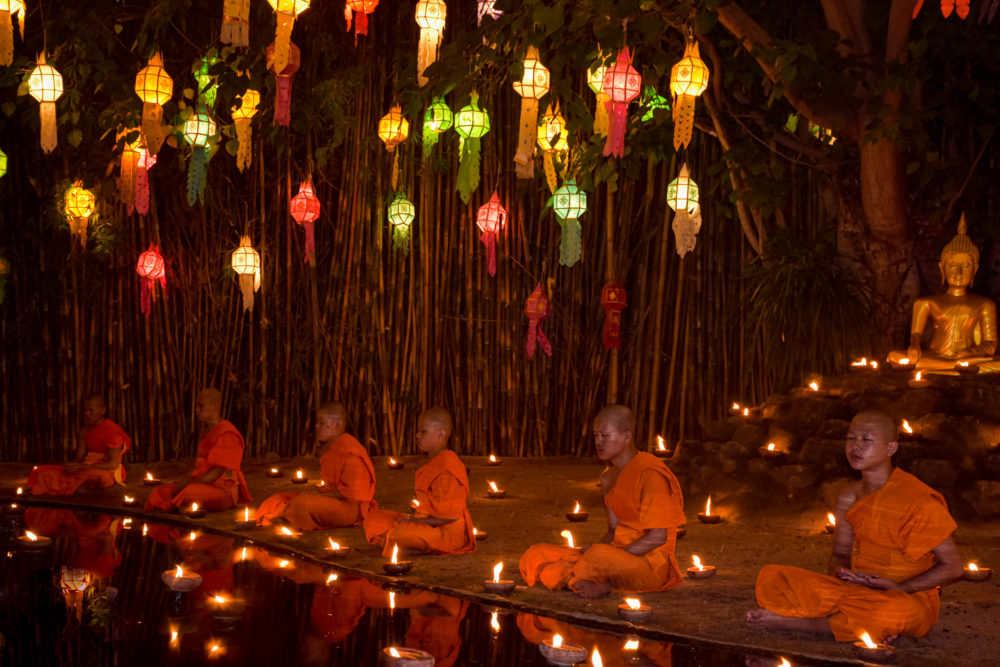
- Reading English medical books to Burmese children with a local teacher (and National League of Democracy party member).
- Couchsurfing in Medan, our host brought us to his favorite local spot for dinner with his entire family.
- Drinking beers & practicing our Spanish at a Colombian market in the hot sun with some sassy local men.
Package Tours vs. Independent Travel
If you’ve ever seen those charter buses packed full of tourists all adorned in the same T-shirt you know what package tours are. They dutifully follow the schedule they are provided (& paid big bucks for) making chit-chat with other tourists who were also lazy enough to book a trip all-inclusive.
Package tours are not my thing. Typically. Most of the time they are catered to seeing the bare minimum of a country. They are luxury experiences that often keep you in your protected bubble of comfort and you leave the country feeling very much the same as you were before you left.
Obviously, there are always exceptions to the rule. GAdventures runs budget-friendly overland tours through Africa geared at Adventurous travelers. OtherWayRoundTravel in Colombia runs small group tours for adventurous 20 to 35-year-old travelers and it’s run by locals.
On the opposite end of the spectrum is independent travel. I would classify us as independent travelers. But what exactly is independent travel?
Independent Travel Definition: Travel in which you organize everything yourself, without a travel agent or other company to organize activities and accommodation for you.
It’s that simple.
If you opt to plan your vacation yourself you fall into the category of independent travel. This is the style most backpackers and extreme budget travelers will be familiar with.
The Semi-Independent Traveler. The Sweet Spot.
The semi-independent traveler. The tourist who does a little of both. They have planned their own vacation but along the way they sign on to some group activities with local vendors.
For example…
If you head to Indonesia and start your trip in Bali. Then you spend a week exploring the island on your own, maybe hike some volcanos in Java before you head to Sumatra to see orangutans in the wild . Up until this point you have been an independent traveler. But then you sign on for a week-long all-inclusive agency to take you trekking in the jungles & sleeping in rustic cabins with a small group of like-minded travelers. You’ve become a semi-independent traveler.

It can be so relaxing to have a difficult portion of your trip planned for you and if you have done your due diligence & research you’ll still be contributing to the local communities.
This is the most popular way to travel.
Which Type of Travel is Right For You?
Now that you know how to distinguish between the types of travel you can decide where you fall. Here’s a quick set of questions you can ask yourself before you commit to independent travel.
Do you feel safe traveling to the country of your choice?
Are you interested in gaining a deeper understanding of the country and want to have an experience unique to others who visit the country?
Are you comfortable fending for yourself when things inevitably go wrong?
Are you traveling on a budget?
Do you have a lot of time for researching and traveling?
Are you interested in off-the-beaten-path destinations and supporting the local economy over your own personal comfort?
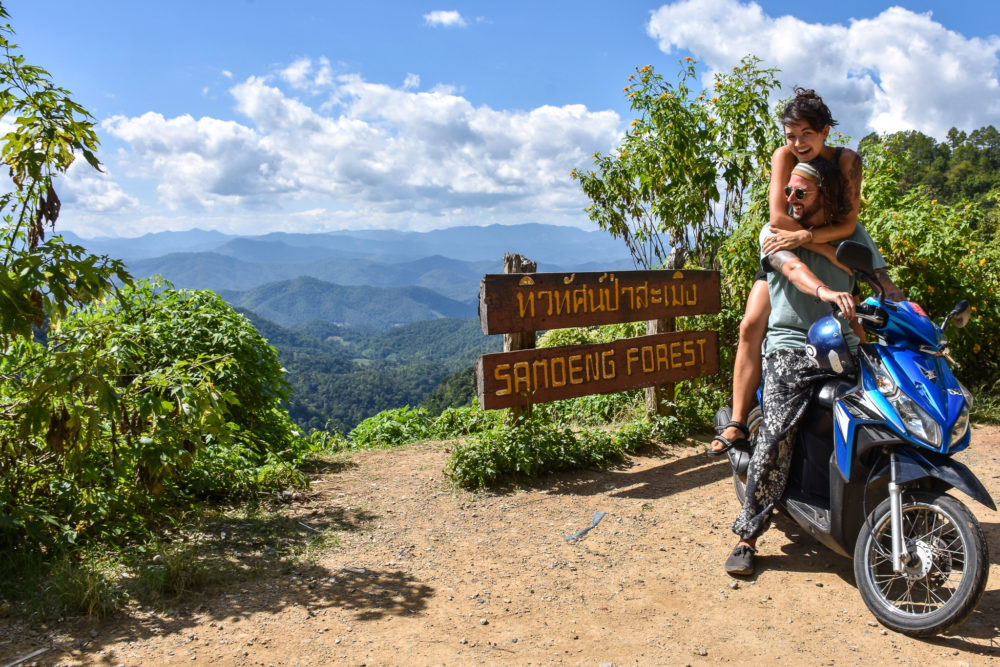
If you answered ‘Yes’ to most of these questions, Good News: Independent travel is right for you!! Even if you didn’t, I would encourage you to at one point in your life give independent travel a try and see how you do.
How to Choose a Good Cultural Tour Company
If you’re not ready to give it a go and explore the world on your own the least you can do is choose a good tour company.
What makes for a “good” tour company?
- The money goes back to the community.
- It’s run by locals.
- The focus is on gaining a better understanding of the country rather than pure luxurious comfort.
- Animals and humans are treated humanely and with respect.
Do your research before you sign up. Sometimes companies that masquerade as giving back to communities are large corporations owned by foreign investors.
& please for the love of all things diverse and quirky, don’t stay in all-inclusive resorts. They are the worst kind of tourism (alongside the eco-logical disaster that are cruises).
10 Tips For Immersive Travel
Immersing in a foreign country can be difficult. These are the 10 rules we stick to when we travel to make exploring more rewarding and to better understand the country quicker.
1. Take Public Transportation.
Or motorbikes. Or rent yourself a car. Just try to avoid hiring a personal driver for the day unless it’s someone you met, connected with, and feel could give you an insightful tour of their country. Too often we default to the easiest method of transport when the journey can be just as rewarding as the destination.
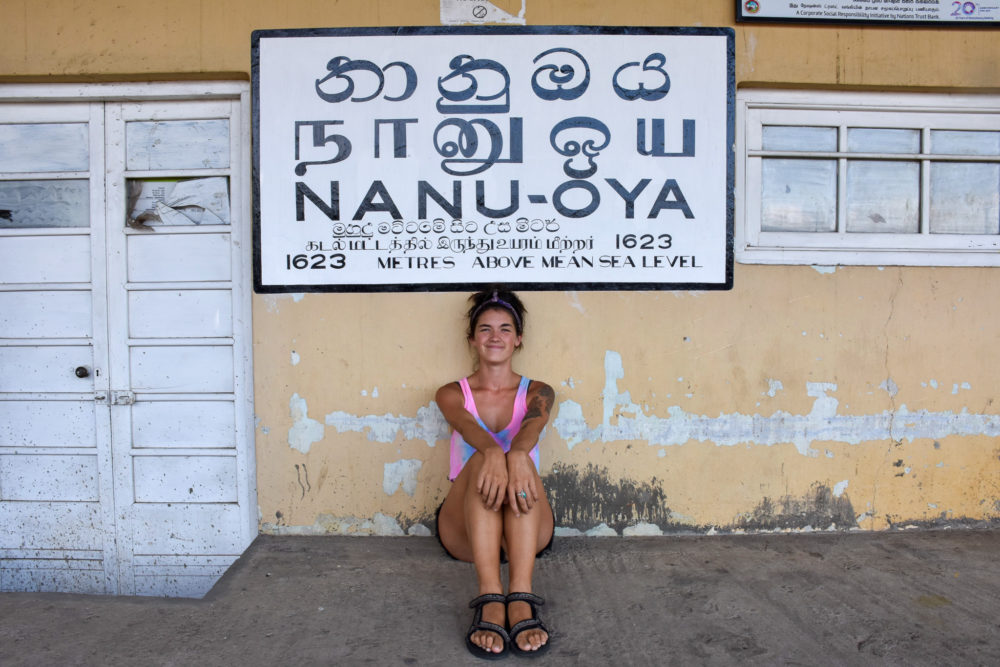
Although the bus is not often the most comfortable, it’s always the most interesting.
2. Savor the Street Food.
EAT LOCAL. I’ll scream it from the rooftops because there is simply nothing more aggravating than people who travel halfway across the world to eat the same food they would have eaten at home. Pizza in Thailand? Vegan Burger in Bali? Eggs Benedict in Colombia? WHY.

Maybe food isn’t as important to everyone as it is to us, but at least try to support local businesses as you would back home. You never know what’s going to be your new favorite meal.
Also, street food is sanitary and delicious and anyone who tells you otherwise isn’t living correctly.
3. Stay in Guesthouses.
I use Booking.com to find them. You can also couch-surf using Couchsurfing.com or find a homestay online. Staying with a local has loads of benefits. First, you’re supporting the community & not a foreign hotel chain. Secondly, you have the chance to eat home-cooked local meals & chat.

Guesthouses are also clean, comfortable, and private in comparison to other budget-friendly options like hostels.

4. Be Friendly.
To locals and other travelers. A smile and good attitude gets you a long way.
It’s these connections you make with like-minded travelers that blossom into life-long friendships. & the connections you make with locals that you’ll look back on fondly once your trip is over.
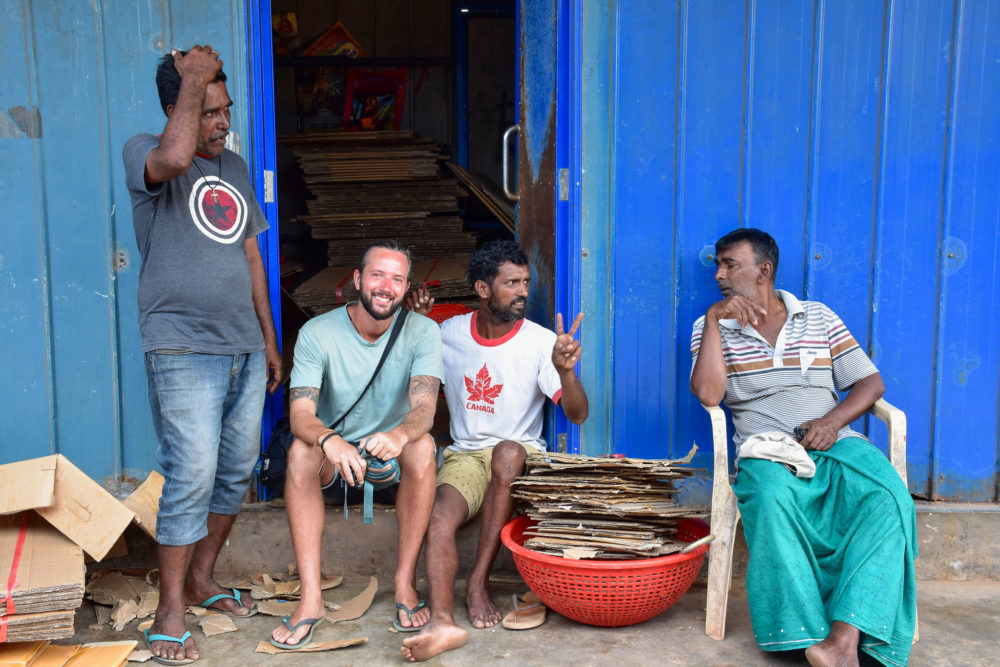
5. Stay Longer. Move Slower.
The longer you spend somewhere the easier it is to immerse yourself in the local life. Obviously, living in a foreign country or even studying abroad allows you to understand a place far better than a tourist simply passing through.
Just do less. If you only have a week to travel, instead of cramming in 6 cities, just pick 2. You’ll get to spend more time in each place and leave with more meaningful experiences. Unless you’re just traveling to check things off of a never-ending bucket list that is.
6. Take the Time to Learn Some Phrases.
You don’t have to be fluent, but the simple act of learning the language basics shows you are interested in their country and life.

It will make getting around easier, you’ll be more self-sufficient, & you’ll be able to make friends with locals. With Duolingo & other free language apps on the market, you have no excuse.
7. Avoid Impersonal Group Tours.
Use the tips I listed above to find the best tours if you are too nervous to independently travel.
8. Visit Local Markets.
Markets are the lifeblood of a destination. It’s where the locals shop, eat, and where many work. Seek out authentic local markets instead of tourist markets and you’ll gain insight into the country. & have countless opportunities to eat local food. & support local businesses.
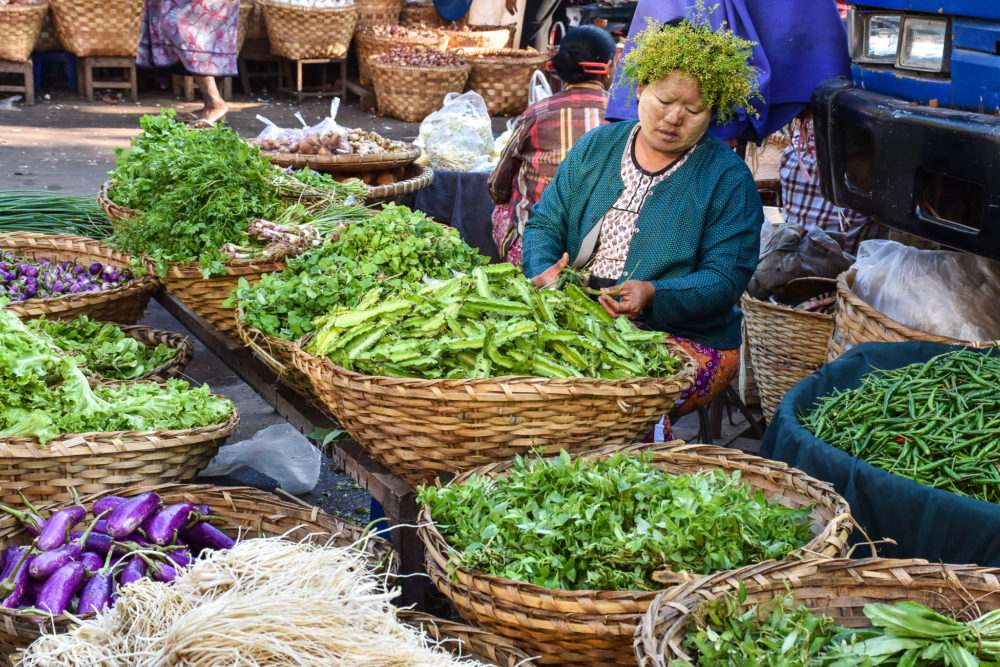
9. Don’t have Set in Stone Plans.
When you’re traveling independently things go wrong. We write a whole blog post about our most embarrassing travel fails . But sometimes things also go right.
Example : You meet a group of travelers headed to a remote region in Laos you had never heard of. & you want to tag along. But if you’ve booked everything in advance your schedule won’t be flexible. You want to leave yourself open to the world’s opportunities.
10. Follow Local Customs.
This is the single most important item on this list. Don’t be an American Idiot (or whatever the equivalent is for the rest of the world). Be considerate and knowledgeable of the culture.

If you are visiting temples in Asia be sure to dress conservatively with your shoulders and knees covered. & don’t you dare uncover yourself for a stupid Instagram photo.
If you’re a woman in the Middle East & it’s recommended to wear a hijab. Do it.
Not only are you respecting their cultural norms and traditions you’re saying you’re willing to embrace the uncomfortable to experience the country responsibly.
10 Destinations for Immersive Travel
Obviously, you can (& should) immersively travel everywhere. But these destinations have such a wonderfully rich culture and traditions that they will change the way you travel forever.
Considering you make an effort to visit them the right way.
- Indonesia .
- Sri Lanka .
These 10 countries all have such a strong (& foreign) culture for travelers to experience.
& that’s immersive travel for ya. It’s something to strive for. Now that you have a better understanding of independent travel and what it means to truly experience different cultures you’re better equipped to get off-the-beaten-path and see what’s out there.
Save This Post For Later!

Further Reading...

Travel Story: Illegal Bedouin Cave Camping in Petra
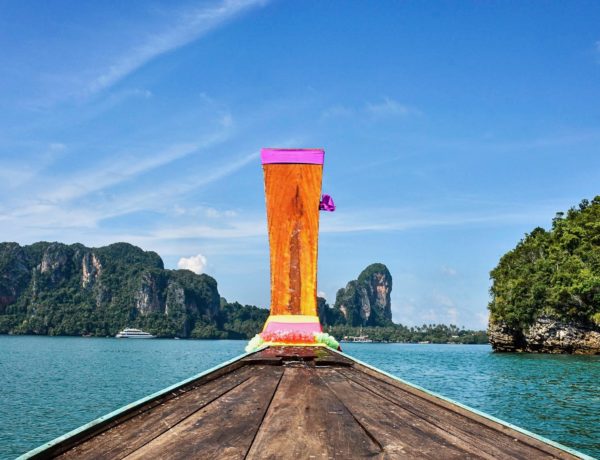
30 Useful Gifts to Give Backpackers & Travel Lovers
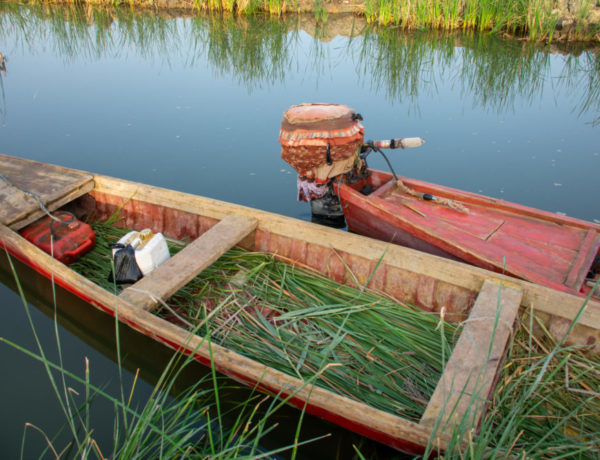
Guns, Methane Marshes, & Abou Haidar: Our Night Spent in the Heart of Ancient Mesopotamia
Great ideas and thanks so much for sharing your knowledge and time!
Audrie Robinson
I loved this article thank you!
Leave a Reply Cancel Reply
Save my name, email, and website in this browser for the next time I comment.
Notify me of new posts by email.
Sign up to our newsletter!
This site uses Akismet to reduce spam. Learn how your comment data is processed .
Travel the U.S. for $30 A Day: The Ultimate Budget USA Road Trip
How i got the yellow fever vaccine in colombia for free ( + tips for cheap vaccines), beyond_the_bucketlist.

Wander-Lush
World’s Best Cultural Tourism Destinations: 30 Cultural Trips to Take This Year
Discover the best cultural trips and immersive travel experiences our world has to offer. From Southern India to the High Arctic, here are the top 30 countries and regions for cultural tourism this year .
With many of us now on the lookout for deeper and more meaningful travel experiences , cultural tourism – travel that prioritises learning about and appreciating different ways of life – has never been more appealing.
Immersive cultural experiences give travellers an opportunity to see the world from a different perspective, form meaningful relationships, and develop new skills. They can also open the door to a slower, more sustainable type of travel that has benefits for local communities and a lighter impact on the planet.
Whether you’re a seasoned cultural traveller researching for your next trip or you’re interested in getting off-the-beaten-track but aren’t sure where to start, I hope this guide to culture and travel offers you some food for thought!
I also suggest reading these tips for socially responsible travel for advice about engaging with different cultures in a sensitive and mindful way.
Please note: This post contains affiliate links, meaning I may earn a commission if you make a purchase by clicking a link (at no extra cost to you). Learn more.
This post may contain sponsored links for which I received compensation.
What is cultural tourism?
Cultural travel is as broad and multifaceted as culture itself – it’s difficult to pin down, and highly subjective. For me, cultural tourism is a kind of travel that prioritises activities and experiences designed to immerse you in a way of life that differs from your own.
It might involve consuming tangible cultural products (museums, archaeological sites, food , tea ) or encountering intangible cultural elements (rituals, performances, processes). As well as art, literature, religious monuments and the like, it also encompasses ways of living, values and beliefs – both historical and contemporary.
It’s almost impossible to avoid local culture when you travel. No matter your motivation, it’s inevitable that you’ll end up experiencing some aspect of local culture, even if it’s something as simple as eating local cuisine or learning a few words of the language.
Apart from these incidental encounters, cultural tourism represents a more concerted effort to engage with local culture through specialised activities. In the same way an adventure traveller might seek out a particular hiking route, for example, a cultural traveller might plan their trip around a festival.
Cultural vacations might involve:
- Learning a new skill, for example through a cooking class or craft workshop
- Attending a local festival or event
- Participating in a ritual or ceremony
- Eating local food
- Staying with a family at a homestay
- Immersing yourself in the local community by teaching English as a foreign language
- Visiting a community-based tourism project
- Visiting World Heritage Sites and immersive museums
- Taking a locally guided tour
There’s lots more to cultural trips (as you’ll soon see), but these are some of the common elements we tend to associate with this genre of travel.
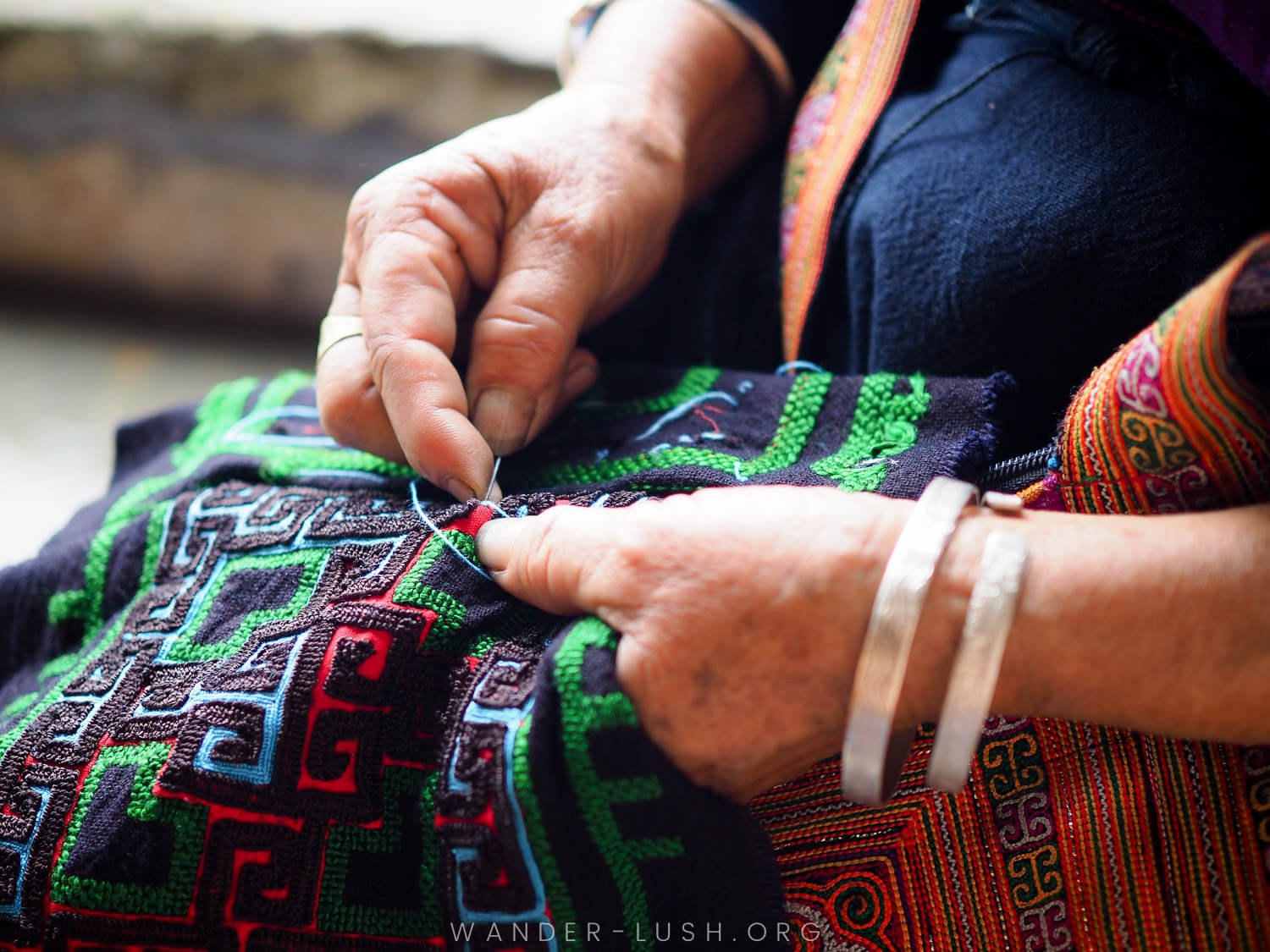
Pros and cons of cultural travel
Cultural travel is almost a guaranteed way to enrich your experience as a tourist. But it’s worth noting that this type of travel has both benefits and downsides for host communities.
Cultural tourism helps to encourage the preservation of culture and heritage by keeping endangered traditions alive. There might be little demand for heritage handicraft skills, for example, but outside interest (and an opportunity to earn an income) could be enough to safeguard a tradition that might otherwise have been lost.
By the same token, cultural tourism can incentivise better protections for physical heritage sites, ensuring that monuments and the like remain accessible for future generations. Cultural tourism can have far-reaching social impacts and environmental benefits when it gives rise to new social enterprises, local businesses and women-led ventures geared towards giving tourists an immersive experience.
On the other hand, there’s always a question mark around authenticity when it comes to cultural travel. If a ritual is performed for the benefit of outsiders, does it lose its meaning? Commodification of culture for tourism is a serious issue that impacts many communities and can be damaging to social and economic development more broadly.
Cultural tourism often involves travelling to more remote areas, which introduces a whole host of other pros and cons. A road constructed for the benefit of tourists is also new infrastructure for the community – but it might speed up globalisation and cultural erosion, while the very presence of tourists can worsen environmental pollution or cause rifts between different social groups.
These are complicated issues. Personally, I think cultural exchange is one of the most important aspects of travel and when managed properly and in a way that actively involves communities, the benefits can outweigh the drawbacks.
Top 30 countries & regions for cultural trips
There’s not a town, city, county or region in the world that doesn’t have something amazing to offer in terms of local culture. This makes it very hard to pick the ‘best’ places for cultural tourism.
However, each of these 30 hand-picked destinations stands out for its extravagant festivals and celebrations, rich cuisine and heritage handicrafts that give travellers a window on culture, heritage and the local way of life.
At the end of the list, you’ll find my top tips for having a more culturally immersive travel experience no matter where in the world you go.
Cultural destinations in the Americas
Antioquia Department, Colombia • Cuba • Ecuador • Big Island of Hawaii, USA • Orleans Parish, USA • Oaxaca, Mexico
Colombia’s Antioquia Department – for pueblos, bandeja paisa & Botero
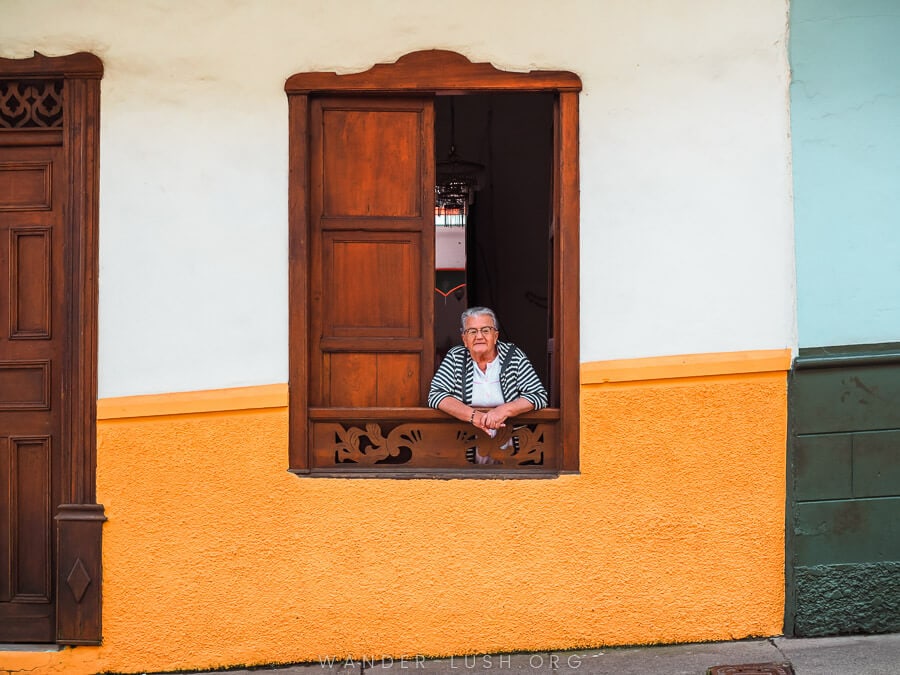
A melange of Indigenous traditions and colonial influences, there are few destinations in the world more culturally vibrant or intriguing than Colombia.
Antioquia Department in the north-west – with the city of Medellin as its capital – has become one of the most popular destinations in the country for tourists, beloved for its exquisite landscapes, colourful small towns and coffee farming heritage.
Along with several other departments, this part of Colombia is home to the Paisas , a self-defined cultural group whose name is derived from a Spanish word meaning ‘countryman’. They speak their own dialect, eat their own cuisine, and pass down their culture through a rich tradition of music and folklore.
Modern-day Antioquian culture is defined by the region’s artists, writers and poets. And then there’s the city of Medellin itself, which has undergone a huge transformation in recent years and is now considered one of the country’s main cultural hubs.
Top cultural experiences in Antioquia
Eat Paisa cuisine: One of the biggest joys of visiting Antioquia is experiencing the food scene. Paisa cuisine is heavily influenced by the topography and way of life in the Colombian Andes – carb-heavy dishes that feature beans, rice and maize are designed to fuel bodies for back-breaking work on the land. Bandeja Paisa is by far the most popular traditional dish and a must-eat in Medellin. The Antioquian version of a ploughman’s lunch, it consists of carne asada (grilled steak), chicharrón (crispy pork rind), rice and red beans served with a slice of avocado, fried plantains, a fried egg and a corn arepa on the side. It’s not for the faint hearted!
Visit a pueblo : Colombia is renowned for its small towns with colourful painted facades and pretty flower boxes. Antioquia is home to some of the loveliest pueblos in the country, including Jardin , Jericó and Santa fe de Antioquia, to name but a few. Developed during Spanish times, most follow the same basic town plan: A public square, a market, a church, and rows and rows of houses built in the region’s vernacular style. If you’re short on time, Pueblo Paisa in Medellin is a model village in the heart of the capital.
Shop at the San Alejo Handicraft Market: If you happen to be visiting Medellin on the first Saturday of the month, don’t miss this unique opportunity to see Colombia’s handicraft traditions on display. Vendors from across the region descend on the city to sell traditional products, including woven Wayuu bags, and artisanal foods. You can chat to the vendors and watch live demonstrations to see how these Indigenous handicrafts are produced.
Visit Comuna 13: A locally guided tour of Medellin’s Comuna 13 will allow you to delve into the city’s tumultuous recent past in a respectful and mindful way. This collection of once-notorious city neighbourhoods has become a symbol for the nation’s transformation and cultural revitalisation. Street art, music and other expressions of local creativity are all on display for visitors to enjoy.
Cuba – for Mambo, classic cars & casas particulares
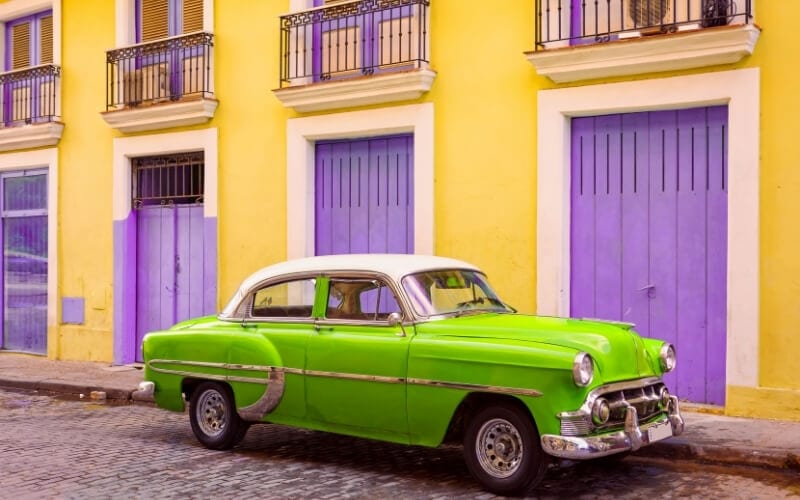
The native Taino Indians called their beautiful island Cubanacán. When the Spaniards arrived in 1511, they shortened it to ‘Cuba’ and claimed it for Spain, labelling it “the most beautiful land human eyes have ever beheld.”
Ethnically, the country is a vibrant mix of Europeans, Africans brought over as enslaved workers throughout the 1700s, and a large group of Chinese imported as indentured servants. Sadly, the original inhabitants have largely disappeared.
On December 31, 1959 the Cuban Revolution succeeded in converting the country into a communist nation. Since then – and due to the mutually adversarial relationship with the United States – the island nation has existed in semi-isolation, frozen in time.
The cars that roam the streets are the same classic American models from the 1950s, and the frequently crumbling buildings have enjoyed little renovation.
Despite Cuba’s trying history, the spirit of the people lives on and in its rich and celebrated culture. Before you go, learn the dos and don’t of visiting Cuba .
Top cultural experiences in Cuba
Dance the night away at a musical venue: Cuba is the birthplace of dozens of musical genres including Mambo, Cha-Cha-Cha and Afro-Cuban Jazz. These Afro-European genres have contributed and enriched music categories around the world. Be sure to experience one of Cuba’s world-famous carnivals and Jazz Festivals.
Overdose on art and architecture: With nine UNESCO World Heritage sites and an amazing collection of museums, Cuba is a culture vulture’s paradise. Most are found in the capital city of Havana, but you also find little gems in the second city, Santiago de Cuba, and the perfectly preserved colonial city of Trinidad. Cuba’s architecture ranges from Spanish colonial and French Baroque to 1920s Art Deco. Visit the Museum of Fine Arts in Havana and the Bacardi Museum in Santiago to start; but don’t miss the quirky Rum Museum or the delectable Museum of Chocolate either.
Stay at a Cuban homestay: These Airbnb-type experiences are called ‘ casas particulares ‘. This is your opportunity to live with a Cuban family and delve into the culture.
Go hiking: Cuba’s national parks, biosphere reserves and 1,500 miles (2,400km) of coastline provide an opportunity to experience the outdoor culture.
By Talek from Travels With Talek
Ecuador – for jungle homestays, festivals & colada morada

A country with just over 17 million people, Ecuador is an extremely culturally diverse nation and a cultural tourism destination that should not to be overlooked.
Retaining a strong influence from Spanish colonisation, with widely-celebrated Catholic festivals and traditions, there is also a diverse mix of Andean Indigenous groups and traditions that dominate the mountainous centre of the country. In the east, the influence of various Amazonian Indigenous groups and their traditions is strong.
The coast of Ecuador, meanwhile, is marked by African influence from the cultures of enslaved peoples brought during colonisation.
With such a diversity of cultures – each with their own festivals, traditional foods and more – there are plenty of immersive experiences to partake in across the country that make a trip to Ecuador a must for any cultural traveller.
Top cultural experiences in Ecuador
Visit a remote community in the Amazon rainforest: One of the most popular and fascinating cultural experiences for travellers to Ecuador is to visit an Indigenous community to learn about and experience the rich traditions. Even a jungle tour of the Amazon on a budget can be tailored to include a visit to an Indigenous community, where you’ll learn to make traditional dishes and beverages such as chicha . Tribes deeper in the Amazon that welcome visitors often offer more in-depth cultural experiences including homestays, ritual cleansings, or even ayahuasa retreats.
Celebrate Easter in Ecuador: In addition to the Indigenous traditions in Ecuador, there are many popular celebrations from the Catholic tradition that travellers can partake in. Easter celebrations during Holy Week include Quito’s parade, known as the Procesión Jesús del Gran Poder, which features thousands of purple-hooded devotes carrying crosses and statues. Make sure you enjoy a bowl of traditional Fanesca , a rich and creamy soup made with 12 grains representing the 12 Disciples.
Dress up for Día de los Difuntos : Another cultural celebration with Indigenous roots is the Día de los Difuntos or ‘Day of the Deceased’, marked on November 2nd. Ecuador celebrates by honouring the dead and visiting cemeteries. Celebrations also include preparing and eating guaguas de pan , bread in the shape of a baby filled with fruit jam, and drinking colada morada , a thick, sweet drink made with berries and fruit and thickened with blue corn flour before being served warm. These delicious treats are sold in bakeries across the country for at least a month prior to the festivities. The largest celebrations are held in Indigenous communities such as Otavalo in Northern Ecuador.
By Carley from Home to Havana
The Big Island of Hawaii – for palm weaving, stargazing & petroglyphs
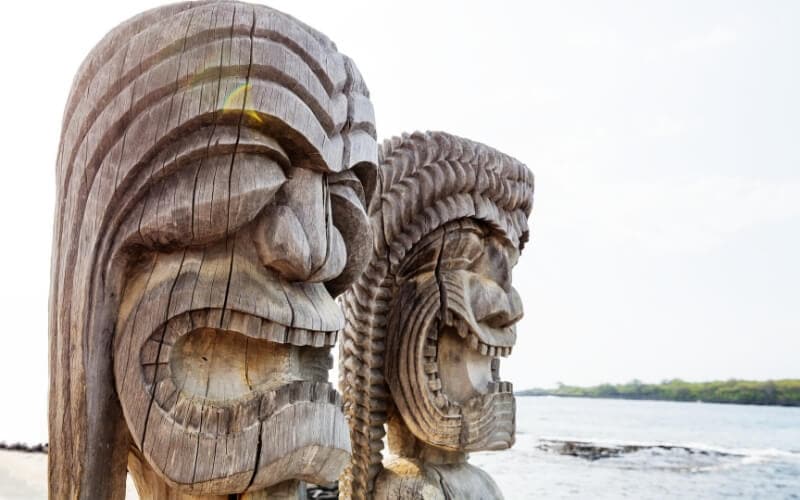
The natural abundance of the Big Island of Hawaii, the largest island in the Hawaiian archipelago, is nothing short of spectacular. With eight different climate zones, three active volcanoes, and the most mesmerising waterfalls and beaches in different shades, there’s a wealth of diversity to explore on the Big Island .
This unique natural setting is also home to several important cultural sites. After all, this is the Hawaiian island where the first Polynesian settlers arrived, where the first ruler of the Kingdom of Hawaii, King Kamehameha the Great, was born, and where the European explorers first arrived.
With such a rich heritage, it comes as no surprise that Hawaiian culture is still very much alive on the Big Island. Here are some experiences that allow you to explore the island’s heritage.
Top cultural experiences on the Big Island of Hawaii
Take a self-guided tour of the Pu’uhonua o Hōnaunau National Historical Park: Just south of Kailua-Kona, there’s a site where the royal family and their warriors once lived. It’s very well preserved and you can still see the thatched huts, an ancient temple, wooden carvings and fishponds. But this site was more than just a royal retreat: When Hawaiians broke the law or kapu , they were condemned to death. The only option to escape their fate was reaching this sanctuary, known as the Place of Refuge. You can visit this intriguing site on a self-guided tour.
Learn the traditional Hawaiian art of weaving palm fronds: In the Hawaiian craft known as lau niu , the leaves of the coconut palm were used to thatch roofs, create baskets and even hats. There’s a handful of workshops where you can learn this traditional craft from a professional weaver. Not only does it make for a unique experience, it also allows you to craft your own handmade Hawaiian souvenir.
Go stargazing at Maunakea: In Hawaiian culture, the dormant Maunakea volcano, with its unique alpine Lake Waiau, is considered sacred. They believed the summit to be the realm of the gods and the meeting place of earth and sky. To this day, cultural rituals are performed on the slopes of Maunakea. This intriguing volcano is home to the world’s largest astronomical observatory, the Onizuka Center for International Astronomy, which hosts a regular stargazing program.
Check out the Hawaiian petroglyphs: Hawaiian petroglyphs tell the stories of ancient times and give a unique inside into the different cultural beliefs on the islands. You can find carvings of canoes, turtles, babies and more at one of the petroglyph sites that dot the Big Island, such as the Puuloa Petroglyph site in Hawaii Volcanoes National Park or the Puako Petroglyph Archaeological Preserve near the Mauna Lani Resort.
Conquer the ocean in an outrigger canoe: Step aboard a double-hull outrigger canoe and explore the shore in the same way the Polynesian settlers did centuries ago. This type of canoe features lateral support floats or outriggers fastened to one or to both sides of the hull. Learn how to paddle and work as a team as you glide along the Kona reefs teeming with fish. If you’re lucky, you might even spot a pod of dolphins.
By Sarah from CosmopoliClan
Orleans Parish – for jazz, Madi Gras & creole cooking
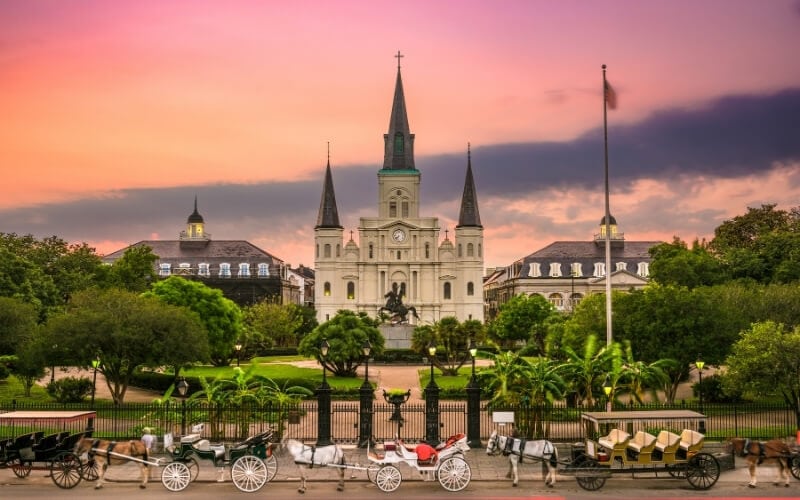
When it comes to cultural destinations, few cities have as much to offer as New Orleans and the surrounding parishes. Located in Southeastern USA, New Orleans is all about tradition and culture. The city’s unique heritage comes from a blend of French, Spanish, Cajun, and Creole cultures.
Combined, these groups have given birth to something truly iconic. The beautiful Mardi Gras celebrations are a remnant of the French colonial era, while the beautiful Spanish colonial architecture in Jackson Square is worthy of a walking tour .
You will also find unique Cajun cuisine served in the city’s most popular restaurants. Add in the many historical museums, southern plantation homes, and distinct architectural styles and Orleans Parish makes for the ultimate cultural destination in the US.
Top cultural experiences in New Orleans
Join a Mardi Gras parade: New Orleans is well-known for its lavish and grand Mardi Gras parades and balls. Visitors can enjoy the festivities for an entire month in the lead up to the big day. Outside of Mardi Gras, there are plenty of other festivals in New Orleans to check out as well.
Listen to jazz: New Orleans is the birthplace of jazz. The city’s Creole population gathered and celebrated in the city’s Congo Square on Sundays and thus jazz was born!
Tour a plantation home: Many southern plantation homes are located along the banks of the Mississippi. These can be seen on a road trip along the Great River Road. On a tour, you will learn about pre-Civil war life in the South and the history of slavery. Learn more about the ethics of visiting plantation homes here .
By Ketki from Dotted Globe
Oaxaca – for Indigenous cuisine, Zapotec rugs & mezcal
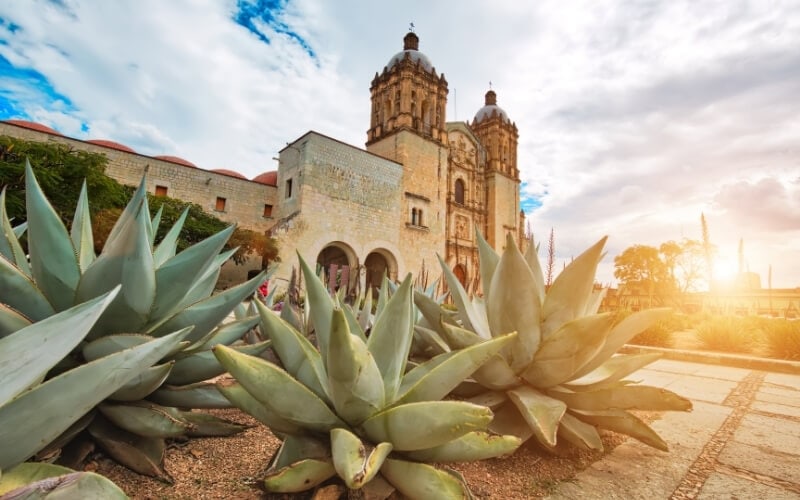
The state of Oaxaca is a cultural hub in Mexico. Void of resorts or even big-name hotel chains, Oaxaca is rich in flavourful cuisine, celebrations, and Indigenous revitalisation.
Located in southern Mexico, Oaxaca features a variety of different landscapes, from lush hills and forests, to dry arid deserts and blissful beaches. However, the community atmosphere of Oaxaca is what keeps people coming back, both international visitors and Mexican residents alike.
Oaxaca is known as the food capital of Mexico, with dozens of celebrity chefs. Notably, Indigenous culture is very visible in Oaxaca, with 16 recognised Indigenous groups in the state. Zapotec weaving is one of the most sought-after souvenirs in the area – and Mexico in general – and it comes from Oaxaca.
Top cultural experiences in Oaxaca
Celebrate Dia de los Muertos : Oaxaca City is a top destination for Dia de los Muertos (Day of the Dead), with its dazzling parades, intricate family altars and abundant festivities. Dia de los Muertos is a pre-Columbian tradition that honours deceased loved ones with food, drink, and merriment. So, if you happen to visit Oaxaca during a festival like Dia de los Muertos, bring comfortable shoes for fun activities throughout the day. Oaxaca City is an extremely walkable city, and you will want to explore every inch of its mural lined walls.
Eat Oaxacan cuisine: Since Oaxacan cuisine is also central to the region’s identity, sign up for a food tour with a local to learn the origins of some of the most popular dishes and what makes Oaxacan food and flavour so unique and different from other states in Mexico. Or, if you want to take a more hands-on approach, take a cooking class with a world-class chef at Casa de los Sabores and learn how to make mole and other Oaxacan staples.
Visit a Zapotec village: If you’d prefer to focus on Indigenous cuisine, take a day trip out to the Zapotec village of Teotitlán del Valle for a cooking class at El Sabor Zapoteco . After you finish, there are many things to do in Teotitlán del Valle , but you will probably want to get your fill of shopping at the many boutique shops for best quality Zapotec rugs.
Drink mezcal: If you’re a fan of hard drinks, Oaxaca is a great destination for mezcal tasting! Hop on any tour and view the vast agave fields as you taste mezcal throughout the day. Depending on the season, you may even get to try your hand at using the harvesting machete!
By Kay from The Awkward Traveller
Learn more: A local’s guide to the best of Mexican culture and an in-depth guide to Mayan culture in the Yucatan .
Cultural travel destinations in Europe
French Basque Country • Armenia • Sicily • Greece • Bosnia & Herzegovina • Russia • Northern Europe’s Arctic Regions • The Greater Caucasus • Andalusia, Spain
French Basque Country – for frontons , fêtes & espadrilles

The Basque country at the southwestern-most tip of France is one of those regions you might not guess is French – at least not at first.
The half-timbered houses are painted oxblood or green, and the Euskara (Basque) language, Europe’s oldest, is related to no other tongue. The Basques are also among the oldest ethnic groups of Europe.
Basque culture is unique and is spread among seven provinces, of which three are in France (the other four are in Spain). The Basques have their own festivals, music and dances, their own foods, games and folklore, as well as an acute sense of history and heritage.
Top cultural experiences in French Basque Country
Here are just a few cultural experiences to whet your appetite for all things Basque!
Gastronomy: The food is different from your regular French fare. For example, the Espelette pimento is spicier than seasonings you’ll find elsewhere in France, and food itself is taken to new heights here – the region has the highest number of Michelin stars per capita in the world. And let’s not forget the pintxo , the Basque equivalent of the Spanish tapas.
Fronton s: You’ll find one of these walls in every Basque village – it’s what Basques use to play their national sport, Basque pelota (known in some countries as jai alai). It’s played with a racquet-like bat which scoops up the ball. Then, a bit like squash, the players fling it back and forth against the wall, or fronton.
Family-owned businesses: Basque artisanal traditions run deep, whether it’s leatherwork, espadrilles, Basque linen or beret making. This is a region in which hand-made goods thrive and where mass-production takes a back seat. The local government makes sure family businesses are promoted and Basque know-how exported, however stiff the competition – there are special labels for family businesses, and even labels for those businesses that have been around for more than a century (and there are plenty). As a result, hand-made goods from this small region find their way around the world, symbolising not only Basque savvy but Basque determination to hang on to its heritage.
Bayonne Festival: With its one million annual participants, the Fêtes de Bayonne is France’s largest festival. It was ‘borrowed’ in 1932 from not-too-distant Pamplona in Spain, but has grown immeasurably since. Each July, visitors dress up in white clothes and red scarves (and a red beret, of course) and spend five days eating, drinking, singing Basque songs and watching Basque sports. The Festival includes bullfighting, which has a long tradition in the region, although this particular sport might be short-lived given the growing opposition to it.
By Leyla from Offbeat France
Bosnia & Herzegovina – for old bazaars, woodcarving & kahva
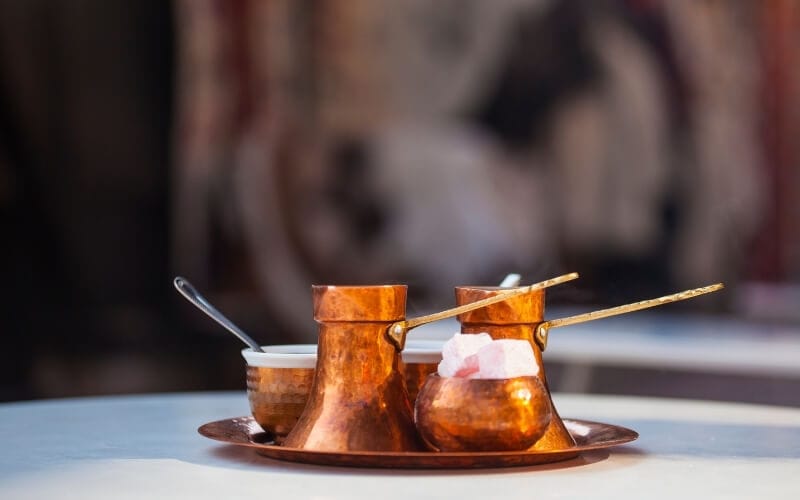
Bosnia and Herzegovina is one of the most culturally and ethnically diverse countries in the Balkans . If you have your sights set on this lesser-visited part of Europe for your next cultural trip, it’s the perfect setting to learn about the region’s different – often competing – influences and how they’ve shaped modern life.
Bosnia is the original cultural melting pot, and Sarajevo is where it all comes to a head. The city is divided into two parts – Ottoman and European – with the sprawling Old Bazaar on one side, and the Austro-Hungarian planned portion of the capital on the other. A plaque on the pavement marks the spot where East Meets West.
But the boundaries aren’t always that clear. Bosnia and Herzegovina’s character is a combination of Bosnian, Serb and Croat, layered with Jewish, Romanian, Albanian and Turkish traditions. The vignette of a mosque’s minaret and a church bell tower rising up side by side is a perfect motif for the country’s diversity.
Top cultural experiences in Bosnia & Herzegovina
Explore Sarajevo’s Old Bazaar: One of the most beautiful Ottoman bazaars in the region (and there are a lot), just wandering the rows of picturesque wooden shops connected by cobbled streets – the sound of coppersmiths beating intricate designs onto plates ringing in your ears – is a completely immersive experience. At the kafane coffeehouses, where kahva and rakia are served with much pageantry, you get a feel for famous Bosnian hospitality.
Take a food tour of Sarajevo: Bosnians are fiercely proud of their national cuisine. Dishes such as burek (filled savoury pastry) and cevapi are a common ground and bring the country together. A food tour of Sarajevo takes you behind the scenes on some of the city’s liveliest markets and busiest restaurants while giving you an insight into the history behind some of the country’s most iconic dishes.
Visit a woodcarving master in Konjic: Sarajevo in particular has an incredibly rich art and literature scene, as evidenced in the many festivals that take place in the city throughout the year. Bosnia’s heritage handicrafts shine a light on the culture of craftsmanship that has bestowed the country with so many beautiful landmarks over the years. Woodcarving has been practiced for generations in the city of Konjic and today, visitors can tour the masters’ workshops for an up-close encounter.
See the Stećci Medieval Tombstone Graveyards: Stećci medieval tombstones were laid during the time of the Bosnian Kingdom. Recognised as a UNESCO World Heritage Site, they’re found throughout the territory including in forests close to the border with Serbia . Carved from limestone, the Stećci contain motifs and inscriptions and provide a rare window onto this epoch of the country’s history that’s still shrouded in much mystery.
Greece – for markets, mythology & Orthodox Easter
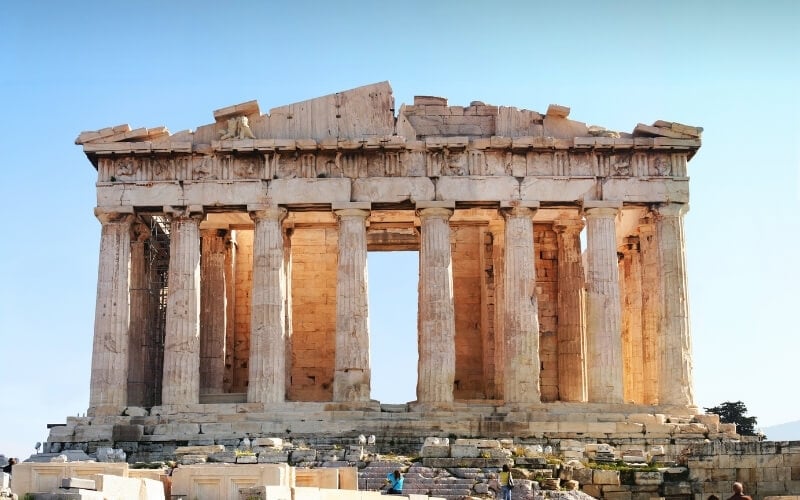
Greece is a country rich in culture, from the legacy of ancient history and mythology to traditional cuisine and celebratory festivals that still bring people together to this day. Greek nationals tend to be very proud of their history and culture , which can be seen in the well-executed museums, galleries and archaeological sites throughout the country.
Believed to be the ‘birthplace of Western civilisation’, Greece is known for its scholars, medics, architects, philosophers and politicians that shaped the way the world works today. This makes the country an excellent choice for cultural tourism as there are simply so many things to see and do that will both satiate your wanderlust while also teaching you new things.
Whether you’re interested in archaeological excavations, gastronomic tours, local festivals or ancient architecture, Greece certainly has you covered.
Top cultural experiences in Greece
Take a Mythology Tour of Ancient Athens: Athens has a whole host of archaeological sites to explore , from the Ancient Agora and Hadrian’s Library to the world-famous Acropolis and Parthenon perched on a hillside overlooking the city. One of the best ways to discover these sites is via a Mythology Tour that takes you around the best historic monuments and ruins while also giving you interesting information about the city and country’s history and mythology. This tour , suitable for all ages, gives you skip-the-line access to some of Athens’ most important landmarks along with an experienced guide to give you detailed history about how Greece became the centre of the world.
Visit the Athens Central Market: If your idea of cultural tourism involves food, you might be interested in a trip to the Athens Central Market and a local cookery class. A gastronomic experience allows you to soak up the sights and smells of the city’s biggest market, picking up local produce and souvenirs while also trying some tasty titbits along the way . You’ll then take your purchases back to the kitchen where you’ll cook up a storm using local recipes and techniques. Try classics like Dolmades (stuffed vine leaves), Tzatziki and Spanakopita (spinach and feta pies) to give you a real taste of traditional Greek cuisine.
Attend the Epidaurus Festival: The Ancient Theatre of Epidaurus, a grand amphitheatre located on the bank of the Acropolis Complex, runs an annual summer festival of art. The festival combines modern and traditional music, theatre and dance with the picturesque Ancient Greek setting, making it a real highlight for any traveller. Over the years, the Epidaurus festival has played host to names like Frank Sinatra, Maria Callas and Luciano Pavarotti.
Celebrate Orthodox Easter in Greece: Easter is one of the biggest traditional festivals on the Orthodox calendar, so no matter where you are in Greece during this time, you’re sure to come across some pretty exciting celebrations! One destination that always enjoys epic Easter festivities is the island of Corfu. Local Easter traditions begin on Palm Sunday (a week before Easter) and there are different festivities each day leading up to the main event.
Palm Sunday sees a large procession of the Holy Shrine; Monday, Tuesday and Wednesday see locals preparing their Easter meals and sweet specialities, going to evening ceremonies and lighting up the town with lanterns; Maundy Thursday is egg-painting day; Good Friday features the mournful marches of the philharmonic orchestra and the procession of epitaphs; Good Saturday features an artificial earthquake(!), bell ringing, the throwing of clay pots and tossing coins into a barrel; and the whole week culminates on Easter Sunday with a celebration of the Resurrection of Christ – fireworks, marches, music and traditional family meals galore!
By Chrysoula from Athens and Beyond
Learn more: 7 awesome cultural activities in Athens .
Russia – for ballet, banyas & borscht
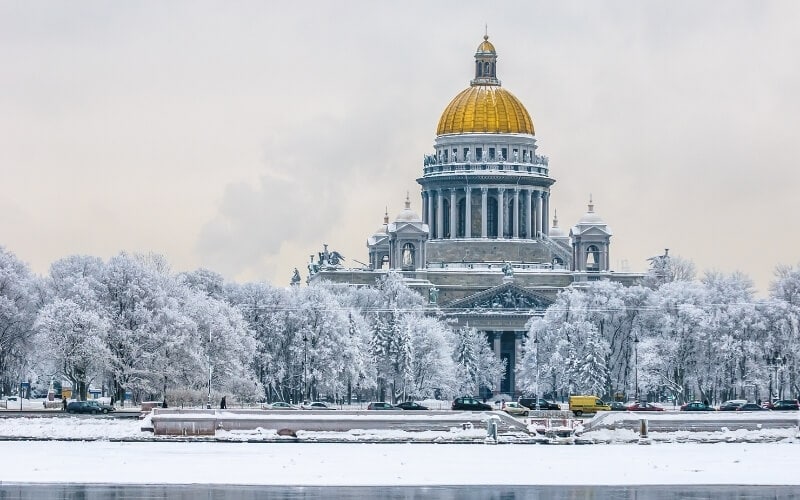
While many may think of Russia as cold and grey, this could not be further from the truth. From the famous colourful onion domes of St. Basil’s Cathedral to the gilded fountains of the Peterhof Palace, Russia’s beauty is undeniable.
Russia is also a country rich in culture and filled with literature, ballet, painting and classical music.
Top cultural experiences in Russia
To really delve into Russian culture, there are a few experiences you should have whilst here.
Experience a Russian banya : One of the best cultural experiences you can have in Russia is to visit a banya . A banya is similar to a sauna. The biggest difference, though, is that a banya has high levels of humidity, while a sauna usually has dry air. They’ve been a part of Russian life for over a thousand years! You wear funny felt hats to protect your hair and ears from the heat. This also helps to regulate your body temperature, so you are able to sit in the banya for a longer period of time.
Another interesting aspect of the Russian banya is ‘flogging’ using birch twigs ( venik ). This is supposed to benefit your health and improve your immune system, and honestly, if you have someone who knows what they are doing, it does feel really good!
After you’ve gone in and out of the banya a couple times, you then cool yourself off by taking a quick, cold shower, jumping into a cold pool or tub (banyas do have these), jumping into a snowbank (seriously). Or… You can just jump in a frozen lake!
See a ballet at the Bolshoi: Seeing a ballet at the Bolshoi Theatre is one of the best things to do in Moscow and all of Russia in general. Even though ballet did not originate in Russia, Russian ballet is world-renowned, and the locals are incredibly proud of the tradition. If you can, try to see a performance of The Nutcracker or Swan Lake on the historic stage. Tickets sell out very quickly, so don’t delay in purchasing them once they go on sale!
Experience NYE: New Year’s Eve is the biggest holiday in Russia. This is because Christmas was forbidden during the Soviet years. Many traditions were moved from Christmas to the New Year, including keeping presents under the Christmas tree and visits from the Russian equivalent of Santa. Celebrations and fireworks take place across the country on December 31 – the biggest and most famous displays are in Moscow’s Red Square and Gorky Park.
Sample Russian cuisine: No trip to Russia would be complete without experiencing the local cuisine. The best Russian food and drinks to sample on your visit are: Pelmeni (a Russian dumpling filled with meat and usually topped with sour cream); borscht (a traditional Russian soup whose main ingredient is beetroot); beef stroganoff (a Russian dish made with sautéed beef in a sauce with smetana ); syrniki (essentially a cottage cheese pancake topped with jam or sour cream – SO good!); kvass (a fermented beverage made from rye bread); and caviar and vodka (alas, you can’t come to Russia and not try caviar and vodka!)
By Lindsey from Have Clothes, Will Travel
Northern Europe’s Arctic Regions – for reindeer & Sami traditions

In Europe’s high northern reaches, you will find one of the continent’s oldest and most distinct cultures, the Sami. Spread across the Arctic regions of Norway, Sweden, Finland, and Russia, the Sami are Indigenous people who have traditionally led a nomadic lifestyle, known for herding their reindeer between their summer and winter feeding grounds.
The origins of the Sami are largely unknown, and it is believed that they once inhabited grounds much further south. But years of persecution drove them north and forced them to decrease livestock numbers in order to maintain their way of life.
Against all odds, they have managed to hold onto large parts of their culture, including languages, traditions and ceremonies. As the modern world has encroached further north, there have been clashes over natural resources and land, which has put the plight of the Sami at the forefront of people’s minds in recent years and led to movements to protect the people and the culture.
Top cultural experiences in the Arctic regions
Head to Tromso for an immersive Sami experience: Today, there are plenty of ways you can learn about and experience Sami culture. During the winter months, there are many Sami experiences in Tromsø, Norway and beyond where you can educate yourself about the Sami way of life, hear stories that have been passed down through the generations, and eat traditional foods.
Shop at a Sami market: Keep an eye out for Sami markets where you can purchase handmade traditional items.
Participate in a Sami festival: Norway is known to have the largest festivals and in various Arctic cities, you will find Sami festivals on National Sami Day (February 6th). In the summer, there are also Sami music festivals, such as the one found near Murmansk in Russia.
A visit to Northern Europe’s Arctic region is one of the most meaningful cultural trips in Europe as it helps bring attention to a group of people who have spent many years marginalised in their respective modern-day societies.
By Megan from Megan Starr
Andalusia – for Moorish architecture, tapas & Flamenco

Andalusia is an autonomous region in Southern Spain, geographically bounded by Spain’s southern coast. It’s culturally vibrant and very distinctive when compared to other parts of Spain such as Catalunya.
This part of the country was ruled by the Moors for centuries, and Moorish influence is evident in the cuisine, architecture and culture. Seville, Cordoba and Granada are all among the best Spain city breaks and each serve as a good base for exploring more of the region.
Top cultural experiences in Andalusia
Marvel at the Moorish architecture: The Andalusian architecture will capture your attention as soon as you land there, and this is probably the easiest way to start digging into the region’s past and cultural evolution. Cities like Seville and Granada have major UNESCO sites that will blow your mind – the style is in no way similar to buildings in France or even northern Spain for that matter. Islamic calligraphy and intricate details are most evident at the Real Alcazar Palace in Seville, the Alhambra in Granada , and the Mezquita in Cordoba.
Go tapas hopping: People in Andalusia are known for being a more little laid back, and generally enjoy food, family and companionship. Popular ‘tapas hopping’ is best experienced in Andalusia. Tapas bars in the south cultivate a cosy atmosphere with rounds of $1 dollar beers, spinach and chickpeas, cheese, and churros. Moorish/Muslim influence can be seen in the preparation of some foods, especially marzipan, and in the use of herbs and spices such as cumin and cilantro.
Watch a Flamenco performance: After food, flamenco is what defines Andalusia. Flamenco is a dance that is synonymous with Southern Spain and is one of the most energetic and passionate forms of dance/storytelling. Flamenco shows in Seville and other cities in Andalusia are a great way to understand and enjoy this side of Southern Spanish culture.
By Mayuri from To Some Place New
Cultural tourism destinations in the Asia Pacific
Central Australia • Timor-Leste • Sarawak, Malaysia • Cambodia • Japan • Bhutan • Kerala, India • Rajasthan, India • Uzbekistan • The Tibetan Plateau • Taiwan
Central Australia – for ancient landscapes, ochre & bush tucker

The Arrernte and Anangu people have lived in Central Australia for over 20,000 years. From Uluru and Kata Tjuta (the Olgas) to the MacDonnell Ranges and Alice Springs, they have made their home in one of Australia’s driest and hottest regions.
The landscape, its plants and animals permeate every aspect of their culture. The natural environment is the basis for the Creation (or Dreamtime) stories at the core of their beliefs, ceremonies and traditions.
Their relationship with the land also has a practical aspect as a source of food, shelter and medicine. The Arrernte and Anangu’s land management techniques, native foods and art have all found their ways into broader Australian life.
Today, members of the communities have roles as guides, ranges and managers of major tourism businesses. For travellers, there are many opportunities to appreciate the on-going connection the Arrernte and Anangu people have with the Central Australian landscape.
Top cultural experiences in Central Australia
Visit Uluru (Ayres Rock): You can’t go to Central Australia and not visit Uluru. It is an iconic Australian landmark and when you visit this enormous rock, you’ll find many ways to immerse yourself in Indigenous culture. At Yulara Resort you can join a free session to learn about Indigenous food, crafts and didgeridoo playing.
On your way to Uluru, stop at the Cultural Centre. There are ranger talks about the area’s wildlife, how the Anagu have lived in the area for thousands of years, and how that knowledge is used to manage the park today. There are also galleries featuring local art and craft. For something a bit different, try a Segway tour of the rock . As you cruise around the 10 km base, you get a wonderful explanation of the Creation Stories tied to many of the rock’s features, caves and waterholes.
Ochre Pits: Ochre is a natural clay that comes in a range of colours and has been used for ceremonial and medicinal purposes for thousands of years. The Ochre Pits are at a site in the West MacDonnell Ranges where ochre has been collected by Arrernte men for generations. The Ochre Pits are an easy and accessible stop as you tour the gorges of the West MacDonnell Ranges. The colourful ochre cliff face is spectacular and it is quite an experience to be in the presence of a site that has been used for so long and continues to play a role in Arrernte life.
Alice Springs Desert Park: With the lives and lore of the Arrernte tied so closely to the environment, this combination of a wildlife park and botanic garden gives you a great insight into their relationship with the land. Besides the fantastic desert animal exhibits, there is a full program of keeper and cultural talks over the day. Learn about surviving in the desert, bush food and the meaning many of the animals have in the daily life of the Arrernte. The park is in Alice Springs with the West MacDonnell Ranges providing a spectacular backdrop.
By Natalie & Steve from Curious Campers
Timor-Leste – for sacred houses, tais weaving & Cristo Rei

Asia’s youngest nation, tiny Timor-Leste fought hard for its independence, first from Portugal and later from Indonesia. Holding strong to customs and beliefs is part of the resistance and against all odds, the Timorese have managed to pass down many traditions through music, dance and storytelling.
Fiestas held year-round throughout the country showcases these oral traditions, while in recent years, contemporary collectives have began building on the nation’s heritage of performance arts to process the events of the past and express their visions for the future.
There aren’t many physical reminders of Timor’s time as a Portuguese colony left – most architecture was subsequently destroyed – but the invisible influence is still there, along with the influence of the Catholic Church.
In the more remote regions, ethnic groups such as the Fataluku speak their own language and observe a fascinating array of cultural practices you won’t find anywhere else on Earth.
Top cultural experiences in Timor-Leste
Tais weaving: Timor’s ornate national textiles are storytelling objects, filled with symbols inspired by folktales and animist traditions. At the Tais market in Dili you can shop for handwoven tais scarves and tablecloths, while visiting a weaving centre such as Koperativa Lo’ud gives you a chance to see the natural dyeing and weaving process in person.
See the uma lulik in Lospalos: Part of the Fataluku tradition, these sacred houses perched high on stilts symbolise the link between the dead and the living. They are sacred objects that cut an impressive profile as you pass them on the coast around far-eastern Timor.
Make the pilgrimage to Cristo Rei: Standing 27 metres tall on a hill overlooking the capital, Dili, Cristo Rei is the ultimate symbol of Timor-Leste’s piety. More than 99% of Timorese are Christian, and the church has played a huge role in shaping the island’s character post-independence. Walking the 590-step path lined with Stations of the Cross is a right of passage. At the top, views of Dili, Atauro Island and the sparkling coastline.
Sarawak, Malaysia – for ikat textiles, longhouses & forest trekking

The largest of Malaysia’s 13 states , Sarawak envelops much of Borneo. Local culture and way of life is intimately intertwined with the island’s flora and fauna and offers visitors experiences quite distinct from anything you find in Peninsular Malaysia.
Life, history, culture and spirituality is all heavily influenced by the area’s Indigenous peoples, most notably the Iban. Malaysia’s mix of Malay, Indian, Muslim, Chinese and British culture can also be felt in Kuching , the autonomous state’s biggest city and a hub for culture and the arts.
Top cultural experiences in Sarawak
Visit a museum in Kuching: The Tun Jugah Textile Museum, the Sarawak Cultural Village and the Sarawak State Museum – all in or near Kuching – offer immersive exhibits that explore Iban culture. The former is dedicated almost completely to the art of ikat weaving, a time-honoured craft tradition that’s kept alive by artisans and students who learn to dye and weave at the museum workshop.
Stay in an Iban longhouse: Travelling up river into the forest to spend the night at an Iban longhouse is an unforgettable experience. As well as sleeping in traditional quarters, you’ll get to taste home-cooked food and experience various oral traditions, including Renong singing and Ensera storytelling.
Eat Sarawak cuisine: Malaysia is a foodie’s paradise and Sarawak is no exception. In addition to the usual mix of cuisines served up at hawker markets, the state boasts many regional breakfast specialties including Sarawak laksa, kolo mee (Sarawakian noodles) and ayam pansuh (chicken cooked in bamboo).
Cambodia – for Theravada Buddhism, apsara & golden silk

It’s easy to think of Cambodian culture as a relic of the past – a crumbling stupa or a cobwebbed museum display. But nothing could be further from the truth.
Khmer culture is a living, breathing thing, and it permeates everything – from underrated Cambodian cuisine to the country’s handicraft industry and the young collectives in Battambang and Kampot who are reviving the arts scene.
Many traditions and art forms almost lost during the 1970s have been brought back from the brink by artists and entrepreneurs determined to keep Cambodian culture alive.
Whether you’re interested in the legacy of the most powerful Golden Age state, the Khmer Empire, or discovering reminders of the Kingdom’s time as part of French Indochina in the beautiful colonial architecture and peppercorn plantations, it’s never been easier for visitors to get a feel for Cambodian culture.
Top cultural experiences in Cambodia
Take a Buddhism tour of Siem Reap: Spirituality plays a huge role in contemporary Cambodian life and there’s no better lens for exploring the country through. After you’ve taken in the Temples of Angkor that blend Hinduism and Buddhism, learn the ins and outs of Theravada Buddhism with an immersive Buddhism tour of Siem Reap . It’s a life-changing experience that teaches you how ancient beliefs coexist with modern society.
Watch an Apsara performance: It wasn’t so long ago that Cambodia’s national dance, Apsara, was considered an endangered art form. Artist and genocide surviver Arn Chorn-Pond has almost single-handedly revived Apsara traditions through his organisation Cambodian Living Arts. Nothing captures the Cambodian spirit like the understated but immensely beautiful performance. Nightly shows are held in Phnom Penh along with hands-on Apsara workshops that teach visitors the basic moves.
Go forest trekking in Mondulkiri: Mondulkiri and Ratanakiri in Cambodia’s far north-east are two of the country’s most remote provinces , known for their thick forests and biodiversity, including wild elephants. Ethnic minority groups including the Tampuan and the Bunong have developed sustainable tourism offerings, hosting guests at homestays and organising guided forest treks. During the tours, you get a glimpse of how people have coexisted with the forest for generations, and learn about the struggles they face today.
Seek out Khmer handicrafts: From Siem Reap’s Golden silk to Takeo cotton and clay pottery in Kampong Chhnang, every Cambodian province has its specialty crafts, many of which are still made by hand according to traditional techniques. In addition to making the perfect Cambodia souvenir , many co-ops offer tours and workshops so you can see the processes up close.
Japan – for ryokans , geisha culture & tea ceremonies

For those seeking an immersive cultural travel experience, Japan offers visitors a unique look at some of the oldest and most beautiful traditions in the world.
From the historic temples and shrines found throughout the country to the many spiritual and cultural celebrations, there are plenty of opportunities for visitors to Japan to learn about the various philosophies and spiritual traditions that underpin Japanese culture.
Top cultural experiences in Japan
Observe a temple ritual: Consider participating in some of the various rituals at Japan’s temples and shrines. This is especially beneficial if you’re visiting Japan with kids , as it helps to gain a better understanding and appreciation for Japanese customs. Many people in Japan have deep-seated beliefs in symbolism. At the temples and shrines, you can observe and participate in practices that will bring you good fortune, luck, prosperity or health.
Spend the night in a ryokan : To truly embrace Japanese culture, book a stay at a ryokan rather than a hotel. These traditional Japanese inns typically feature rooms with tatami-matted floors and communal onsens or bathhouses. Guests tend to walk around the ryokan in a yukata or lounging kimono and slippers. It is also common for guests to walk around barefoot, as it is considered unclean to wear shoes inside.
Drink matcha : A tea ceremony is another immersive experience that is unique to Japan. Although popular throughout Japan, tea ceremonies are especially prominent in Kyoto, the home of geisha culture. Geishas are treated somewhat like celebrities in Japan, and booking a geisha performance and tea ceremony can be expensive and fairly difficult to arrange. However, you can book a tea ceremony with a maiko , or geisha apprentice, for a more modest price. This one-of-a-kind ritual ceremony is sure to be one of the most memorable travel experiences you’ll have in Japan!
By Melissa from Parenthood and Passports
Bhutan – for handicrafts, thangka & fertility symbols

Most people think of the Tiger’s Nest when they think of Bhutan. But this small, mountainous nation has a wealth of cultural history to offer in addition to its ornate monasteries.
Bhutan is a nation of crafters. In every town and city you will find streetwise vendors selling all manner of clothing, kitchenware, homeware and decorations that have been made using techniques that have been taught and passed down for hundreds of years.
Likewise, if you turn your attention to the buildings, you’ll see that many of them are adorned with colourful decals and patterns, especially designs that depict the eight auspicious signs which, among other things, represent wealth, good fortune, purity and harmony.
Bhutan is the only country in the world to measure their country’s wellbeing based on Gross National Happiness as opposed to Gross Domestic Production, which makes it (un)officially the happiest country on Earth.
Best cultural experiences in Bhutan
Attend a Tshechu ceremony: The annual Tshechu ceremonies show off Bhutan’s handicraft history perfectly. Throughout the year, locals gather across the country in regional Tshechus to celebrate Bhutan’s culture by singing traditional songs and performing dances in elaborate, brightly coloured costumes. At the Tsechu celebrations, an enormous religious banner or thangka depicting the country’s founder, Guru Rinpoche, is unveiled. The thangka is the size of a three storey building, hundreds of years old, and has not faded through the centuries due to the tradition of making sure that the light of the sun never touches it, so it’s still incredibly colourful and detailed.
Visit the Choki Traditional Art School: In order to see the historical handicrafts of Bhutan in production for yourself, make sure to visit the Choki Traditional Art School. Located just to the north of the capital city of Thimpu, here you can witness the students being taught how to weave, paint and sculpt masks, clothes, models, tapestries and dioramas from Bhutan’s history. Students’ ages range from elementary through to late teens, with all levels of skill on display. The students’ creations can then be bought from the school craft shop, with the proceeds helping fund the continuation of the institute’s classes.
Spot the phallus in Punakham: Punakham is the former capital of Bhutan, and was the seat of government until 1955. Located in the north of the country, the town is notable to western tourists for one particular reason. In the 15th century, a controversial master named Lama Drukpa Kunley (also known as the ‘Divine Madman’) popularised the phallus as a means to ward off slander and provide protection for those who lived in houses that displayed it prominently. Yes, it may be taboo for most of the world, but not here – these graphic symbols of fertility and good luck are artistically painted on walls everywhere!
By Jeremy from Cultura Obscura
Kerala, India – for houseboats, tea estates & contemporary art

Dubbed ‘God’s Own Country’, Kerala is a noodle-shaped state in the Southwest of India on the Malabar Coast. It’s known for its beautiful nature – especially a series of canals known as the backwaters and the hilly terrain of the Western Ghats Mountains.
Kerala people are officially the most literate in India and have the longest life expectancy. It is often said the Keralites have the best quality of life in this part of India, and that things are a lot more advanced. This is conveyed in the increasingly popular field of ecotourism and other initiatives.
The region is a beautiful mix of influences and religions. The spice trade has flourished in the area, which brought about European colonisation. You can feel Portuguese influence to this day, especially in the town of Kochi.
Top cultural experiences in Kerala
Cruise Kerala’s backwaters on a houseboat: With the decline of goods being transported on water, Kerala’s trade boats were repurposed into houseboats, and now provide a unique immersive experience on the famous backwaters. The most popular route is between Alleppey and Kumarakom or Kolam. Spending at least one night on the backwaters is necessary for the ultimate houseboat experience.
Soak up the tea heritage in Munnar: Munnar in the Western Ghats is famous for its tea production. You can visit several tea estates in the area and enjoy a tasting. In the village of Munnar, you can also experience the peaceful coexistence of three religions. There’s a Hindu temple, a Catholic church and a mosque all within a few meters from each other.
Attend the Muziris Biennale in Kochi: A bi-annual international exhibition of contemporary art takes place in Kochi. This is the largest festival of its kind in Asia. When the biennale is on, the whole city lives it. The main space for the festival is a large complex of empty buildings near the port. Here, art installations covering all possible mediums bring the space to life. It’s a wonderful sight and quite a modern undertaking in Kerala.
Watch the artists at work at Kerala Kalamandalam: This is one of India’s most traditional universities of art and culture. Students learn Indian performing arts, especially those typical for Kerala. When visiting, you can observe students practicing unique dances with distinct facial expressions such as the Kathakali or Ottan Thullal, learning martial arts, and playing on unique musical instruments. The school is located in Cheruthuruthy.
By Veronika from Travel Geekery
Learn more: 9 amazing cultural encounters in Kerala .
Rajasthan, India – for folk dance, thaali & camel fairs

Rajasthan, the ‘Land of Kings’, is one of the most historically and culturally significant states of India. Over the centuries, Rajasthan has witnessed many rulers and many epic battles. Each built their own magnanimous fort and helped develop the region’s rich culture of art, dance and literature.
Over the past few decades, the Ghoomar dance from Jodhpur region and Kalbeliya dance of the deserts of Jaisalmer and Bikaner have become famous all over the world. Along with dance, folk music and songs relating the heroic tales of epic battles, these form an essential part of Rajasthan culture.
Against a backdrop of the vast Thar Desert, this has all shaped the culture of Rajasthan as we see it today.
Top cultural experiences in Rajasthan
Rajasthan offers travellers a plethora of unique cultural experiences .
Be a bystander at the Pushkar Camel Fair: The Pushkar Camel Fair, held every year in November, is one of the largest animal trading fairs in the world. This colourful carnival is a great opportunity for travellers to experience the charm-in-chaos of traditional melas (Indian fairs) along with a huge tribal gathering. In 2018, nearly half-a-million people visited this multi-day festival. Pushkar is only 150km from Rajasthan’s capital, Jaipur, and is easily accessible by road.
Visit Choki Dhani: A resort village merely 20km from Jaipur, Choki Dhani is the go-to place to experience a collection of Rajasthan cultural experiences. Spread across 10 acres, this uniquely designed resort-village reflects the grandeur of the Rajasthani tradition. Visitors can experience Rajasthani traditional folk dance, watch a puppet show, see skits and sketches depicting important battles, and relish a traditional Rajasthani thaali (set meal), eaten while seated on the floor.
Watch a Dharohar dance performance: The Dharohar dance show at Bagore Ki Haveli in Udaipur is a mesmerising experience in itself. This hour-long show is a combination of many traditional, tribal and folk dances local to the region along with a puppet show. One of the highlights of the show is when an 80-year-old folk dancer performs with more than 10 earthen pots stacked on her head.
By Mainak from Places in Pixel
Uzbekistan – for ceramics, Silk Road heritage & plov

Uzbekistan is an upcoming cultural destinations in Central Asia. With a new visa policy, it is now easier than ever to visit the country – and there are many good reasons to do so.
Uzbekistan was once an important part of the famous Silk Road and has a rich cultural heritage that is still visible in the beautiful Islamic architecture and historic sites throughout the country.
Uzbekistan’s major cities including Samarkand, Khiva and Bukhara were multicultural melting pots where people from all over the world exchanged goods, ideas and philosophies. The Turks, Greeks, Persians, Russians and Mongols all ruled parts of what is now Uzbekistan. Each of them left behind their own influence.
With so much history around, it’s sometimes easy to forget modern Uzbek culture, but this is just as interesting. The Uzbek people are very friendly and will give you a warm welcome to their world of delicious Uzbek food, traditional dance and music, and beautiful handicrafts.
Top cultural experiences in Uzbekistan
Taste Uzbek cuisine: One of the highlights of Uzbek culture is without doubt its food. The best way to learn more about Uzbek food is by taking an Uzbek cooking class. Tashkent is a great place to do so and also has some great restaurants where you can try the country’s national dishes. The Plov Center serves plates of the national dish to thousands of people every day – the huge steaming pots and pans outside are impressive enough to warrant a visit.
Explore ikat and ceramic traditions: Another great cultural experience in Uzbekistan is to explore the country’s beautiful handicrafts. The Fergana valley is home to several centres of handicraft production where they still use traditional techniques. Margilon is famous for its ikat silk textiles and there are several silk factories that offer free tours to see how it’s done. The Usmanov Ceramic Workshop in Rishton also welcomes visitors for a short visit to see its pottery production and design process.
Watch a dance performance: Traditional dance and music is an important part of Uzbek culture. Uzbek dance is an ancient art that has been perfected over hundreds of years. In Bukhara, there are almost daily performances in the Nadir Divan Begi madrasah showing the traditional dances from the different regions in the country.
By Ellis from Backpack Adventures
Learn more: Things to do in Uzbekistan for cultural travellers .
The Tibetan Plateau – for horse trekking & nomadic culture
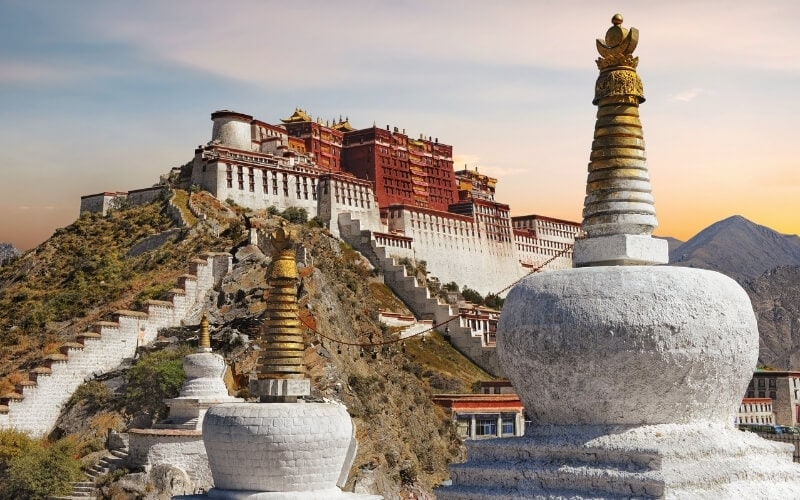
Sprawled across the eastern edge of the Tibetan Plateau, in the remote northern tip of China’s Sichuan province, Ruoergai town and county do not appear on Google maps. To Google, this locality is known by its Tibetan name, Zoige.
After 12 hours of following your car GPS from Chengdu to Zoige, climbing onto the Tibetan Plateau , Chinese road signs welcome you to Ruoergai, 3,500 meters above sea level.
Top cultural experiences on the Tibetan Plateau
Witness nomadic culture: Remote and isolated, Zoige/Ruoergai is the best place in the world to witness the disappearing Tibetan nomadic culture. All you have to do is drive around this vast, open grassland to catch a glimpse. You’ll see white nomads’ tents with smoky chimneys scattered on the sides of the road, surrounded by herds of domestic yak and protected by the menacing Tibetan mastiffs. The nomads are mistrustful of outsiders, which is not surprising given political tensions in the region.
Go horse trekking: Yet there is a way to experience the nomadic culture first-hand here – by taking a horse-trekking adventure with the local Tibetan Horse Trekking Agency in the nearby town of Langmusi. Tours range from a day hike to the hills – the domain of the nomads – to a multi-day horseback adventure with overnight stays in nomad tents. Guides are local Tibetans, so while you may not be having extensive discussions in English, you’ll be welcome in nomadic households.
Visit the monasteries and mosques in Langmusi: Encircled by forest-covered mountains, the small sleepy town of Langmusi is inhabited by three ethnic groups: Amdo Tibetans, Han Chinese and Hui Muslims. So, even just a visit to the town is a unique cultural experience. There are two large Tibetan monasteries on the hills above the town and a Hui mosque at its centre.
The nearest airport to Langmusi is Gannan Xiahe Airport, 130 km away. From Xiahe, you can take a bus to Langmusi, or arrange a car with a driver via Tibetan Horse Trekking.
By Margarita from The Wildlife Diaries
Taiwan – for night markets, Confucianism & forbidden relics

An island nestled off the coast of Mainland China, Taiwan is fast becoming one of the best cultural tourism destinations in Asia.
Its long history and combination of cultural influences – including Indigenous culture, Mainland China, Korea and even Japan – make Taiwan as intriguing as it is complex. Bustling with life, amazing food and beautiful scenery, this island has it all.
Top cultural experiences in Taipei
Eat your way through the Night Markets in Taipei: The capital city of Taiwan, Taipei, offers a world of things for people to see and do . One of the most popular culturally immersive activities for visitors is to head down to the local night market, the biggest one being the Shiling Night Market. Along with delicious local foods, you can also find clothes, accessories, games, cosmetics and more. Night Markets are significant because they play a huge role in Taiwanese culture . Locals and tourists alike flock to these areas each and every day to shop and socialise.
Observe the rituals at a Taiwanese temple: Taiwan is a very religious country with most people following either Buddhism or Confucianism. Many temples are built around these religions in a very extravagant manner. Visitors can take part in the prayer ceremony, burn some incense, or just sit back and observe. If you’re interested in visiting these temples, one of the best places to start is the Songshan Ciyou Temple, which is conveniently located right next to the Raohe Night Market.
Visit the National Palace Museum: This museum houses thousands of cultural relics, art and artefacts, including many items that were carried out of the Forbidden City in China and moved to Taiwan to protect them from destruction during the Chinese Civil War. It’s one of the largest collections of its kind in the world. Here, you can learn how the Chinese language was formed, see what kinds of ancient tools and weapons were used throughout history, and witness what life was like many hundreds of years ago.
By Wayne from Daily Tourist
Learn more: The best cultural experiences in Taiwan .
Cultural trips in Africa & the Middle East
Ethiopia • Oman • Mauritius • Morocco
Ethiopia – for coal-fired coffee, churches & injera

Ethiopia is a country like no other. Here in North East Africa, the steaming tribal lowlands of the Rift Valley collide with the cool thin air of the Northern highlands. The fertile lands towards the West produces some of the world’s best coffee, while the wind from the East carries whispers from Arabia. It’s truly a spectacular place to visit.
Ethiopia is even more unique in terms of its cultural treasures. As the only country in Africa never to be colonised, Ethiopia is a truly African country with African culture. If you want to see lions chase and eat zebras, go somewhere else. If you want to see and experience African culture at its purest, then book your ticket to Ethiopia already!
Top cultural experiences in Ethiopia
Visit the city of Lalibela: Situated in the northern highlands, Lalibela is the most important pilgrimage site in the country for the predominantly Orthodox Christian population of Ethiopia. It is here that you’ll find eleven incredible churches completely hewn from the rock. If you see only one place in Ethiopia, make it Lalibela.
Attend Sunday Mass: The UNESCO recognised Lalibela churches still function as churches, and attending a Sunday morning service before sunrise with hundreds of pilgrims is an experience that you won’t forget. Afterwards you can join the crowds eating injera while basking in the morning sun. Be prepared for the fact that everyone will want to come and talk to you.
Hike to a remote mountain community: Hiking into the mountains surrounding Lalibela will take you to small farming communities where time has seemingly stood still. It’s also possible to visit one of these communities for a day and learn how to cook traditional Ethiopian dishes such as injera , tibs or shiro . You’ll also find a few cave churches and monasteries in these mountains. The priests will be eager to show off their ancient treasures for a small tip.
Participate in a traditional coffee ceremony: Ethiopia is considered the birthplace of coffee, and man are you in for treat! The best way to drink a cup of buna (Ethiopian coffee) is to attend a coffee ceremony. It starts off with the hostess washing green coffee beans and then roasting them in a pan over an open fire. The coals are infused with natural incense made from tree resin. You’ll see bags of these tree resin for sale in markets all over Ethiopia. Finally the coffee beans are ground and brewed in a special coffee pot called a jebena . It’s expected that guests will have at least three cups of buna, but why stop there?
By De Wet & Jin from Museum of Wander
Oman – for dhow boats, frankincense & Bedouin culture

Unlike some of its more glitzy neighbours who’ve traded their souqs for skyscrapers, Oman has approached cultural preservation from a different angle. It’s often called out as the most culturally ‘authentic’ country in the region .
This part of the Middle East has long been a melting pot of Arabian and East African cultures, with a strong South Asian influence. Semi-nomadic Bedouin tribes that paint the desert with their costumes and brightly coloured carpets are less accessible, but a range of tourist-friendly desert experiences allow you to brush with this part of Omani culture.
Contemporary Omani traditions are deeply tied to Ibadism and revolve around an annual calendar of Islamic festivities.
Top cultural experiences in Oman
Get lost in a souq: Perfumed by rose petals and frankincense, Oman’s souqs are a treat for the senses. Roam displays of henna and spices while getting a feel for commerce and culture. Muttrah Souq in the capital, Muscat, and the delightful Nizwa Souq are both must-visits.
Visit a dhow workshop in Sur: Not only are Oman’s wooden boats an impressive feat of engineering, they’re steeped in legend and tradition. In Sur, the home of Sinbad the Sailor, you can watch expert craftsmen fitting the vessels together without glue or nails.
Spend the night at a desert camp. The Sharqiya Sands, Oman’s slice of The Empty Quarter, is the territory of nomads. Bedouin-inspired desert camps recreate the experience of staying with a Bedouin tribe – albeit with a luxury edge! Spending the night in a desert camp involves listening to folk music, eating Omani food, while the very lodgings – the tent lined with carpets you’re sleeping in – is part of the Bedouin tradition.
Mauritius – for street food, Sega & sugarcane
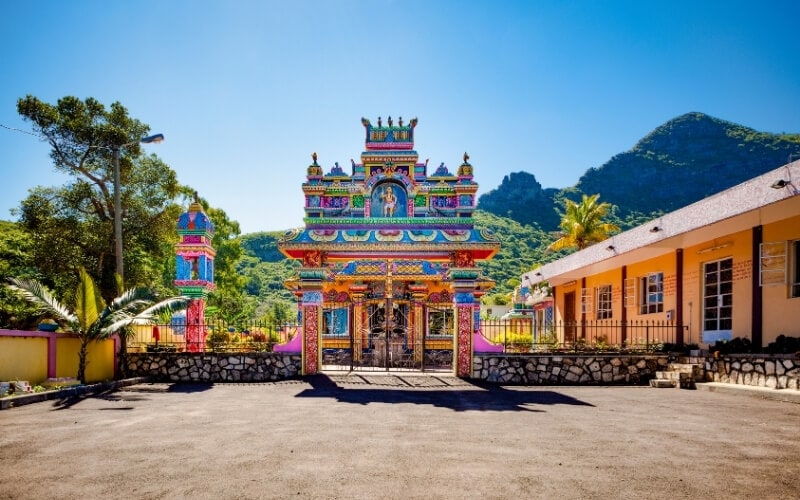
The island nation of Mauritius is normally associated with splendid white-sand beaches and luxury resorts – thus its inclusion on this list of cultural trips might come as a bit of a surprise.
Yes, this is an island paradise incarnate, but it also happens to be one of the most ethnically and religiously diverse countries in the region, with African, Indian, Chinese and South Asian cultures – along with layers of Dutch, French and British influence – all accounted for.
Many elements of Mauritian culture can be traced back to the island’s plantation roots and the legacy of slavery. Mauritians honour this period of history while proudly showing off their culture in everything from the cuisine to the music.
Top cultural experiences in Mauritius
Take a street food tour of Port Louis: Mauritian food, much like Mauritian society itself, combines Chinese, Indian, Creole, East African and European flavours. Must-try dishes include vindaye , an adaptation of West Indian vindaloo, Chatini (chutney) is a popular condiment and traces its roots back to British-Indian origins, briani (biryani) and creations gifted from the island’s Chinese community, such as bol renversé (a layered dish of rice, chicken, shrimp and vegetables). The best way to get a grasp of these edible delights is by joining a guided street food tour of the capital, Port Louis .
Watch a Sega performance: Recognised by UNESCO for its value to Intangible Cultural Heritage, Mauritian Sega is a performance art characterised by music, song, dance and costume. It started out as an expression of pain and loss practiced by slave communities but has morphed over time into a colourful, optimistic expression of local culture. Elaborate Sega costumes moving to the tune of Creole lyrics is a . Many hotels offer Sega performances.
Visit an old sugarcane farm: Mauritius’ history of slavery and plantation farming has left an indelible mark on the island. Visiting preserved plantation homes and crumbling sugar mills is a step back in time to the colonial period, while regenerated cane fields such as those on Frederica Reserve now serve as a sanctuary for the island’s wildlife.
Learn more: 8 ways to experience Mauritian culture .
Morocco – for riads , tajines & mint tea

By all accounts, Morocco is a beguiling destination . The most popular country to visit in North Africa, it stands out for its diversity of landscapes and cultural experiences.
Morocco is an important gateway to the rest of Africa, and has been since Roman times. Its position at the northernmost tip of the continent – with a coast shared between the Atlantic and the Mediterranean – means it’s been at the centre of conquests and various cultural overlap throughout the ages.
Today, Morocco lives with the legacies of various civilisations, including Roman, Phoenician, Jewish, Berber, Arabic, Spanish and French. Morocco has a very hospitable culture, steeped in a refined art of living. When you visit the imperial cities of Marrakech and Fes, or the coastal towns of Essaouira and El Jadida, you will notice a multitude of little details typical of Moroccan life.
This art of living and careful hospitality is very important in Morocco and, as a visitor, you can experience it in many different ways.
Top cultural experiences in Morocco
Try your hand at Moroccan cuisine: Moroccan cuisine is world-famous for its use of spices and mix of sweet and savoury flavours. Every restaurant offers a selection of delicious tajines , a stew of meat and vegetables. Couscous is on the menu every Friday and if you like sweets, you will be in heaven. Sweet biscuits mixing flower, almond and spice flavours make a delicious afternoon treat. If you’re interested in learning new skills, cooking classes are often available in traditional riads in Marrakech. Moroccan cuisine takes time and care, but the results are delicious and quite easy to recreate at home.
Shop for authentic handicrafts at a souq : Another great way to experience the heart of Morocco is to spend time in the souks. Shopping in Morocco is a fun experience and haggling for a good price is the norm. You have to engage with merchants, ask questions, make small talk and, most importantly, have fun with it! Never lose your smile and sense of humour, and it will great fun! The most spectacular shopping experience is in Marrakech due to the volume and intensity of the medina. It’s easy to get lost but that’s part of the experience too!
Sip mint tea, a Moroccan tradition: When you travel throughout Morocco, you will notice that mint tea is served everywhere. This is a pivotal element of Moroccan hospitality. Green tea is mixed with fresh mint leaves and served in little decorated glasses. There is a little bit of theatre in serving mint tea, with the brass or silver teapot held high above the glass… Traditionally, mint tea is served with a lot of sugar, but these days it is common for sugar to be served on the side, so you can dose it yourself. And you can even buy a set of decorated tea glasses in the souk as a souvenir!
By Delphine from Lester Lost
How to have a more culturally immersive travel experience anywhere in the world
It doesn’t matter if it’s a remote community or a popular city – there are things you can do to have a more enriching cultural travel experience no matter where you’re going.
Here are 10 practical tips to help you on your way.
1. Do your research before you go: Familiarise yourself with local customs and learn a bit of the history so you know what types of experiences to look out for. This guide is a great start!
2. Seek out festivals and special events: Many tourism boards feature a calendar on their website, or you can try using Facebook to find local events. Check out my four-part series about the world’s best festivals, starting here .
3. Eat local. Food is one of the easiest routes to culture. Here are my tips for eating local when you travel.
4. Stay at a homestay. Spending time with a local family will give you an invaluable insight into daily life. Here are my tips for using homestays in Vietnam.
5. Participate in a class or workshop . Trying a cooking class, handicraft workshop or any other hands-on experience is one of the easiest ways to immerse yourself in local culture. I recommend using Get Your Guide , Airbnb Experiences, Cookly or Backstreet Academy to find opportunities.
6. Learn a bit of the language. Even knowing a few basic words will show you’re interested and can go a long way to forming relationships.
7. Shop local. Support artisans and heritage skills. Here are my tips for finding authentic and meaningful souvenirs .
8. Slow down. The best cultural experiences are often spare-of-the-moment and can’t be planned in advance. Keep some flexibility in your travel itinerary for spontaneous detours.
9. Go your own way. You don’t always have to follow the pack. Venturing away from the crowds will often give you access to unique and meaningful experiences.
10. Don’t be afraid to ask questions. If in doubt, ask a local. Remember that cultural tourism is all about exchange – don’t just take, make sure you give something back in return.
Are you a cultural tourist? Which of these destinations is your favourite? What other places would you add to the list? I’d love to hear your suggestions in the comments below!
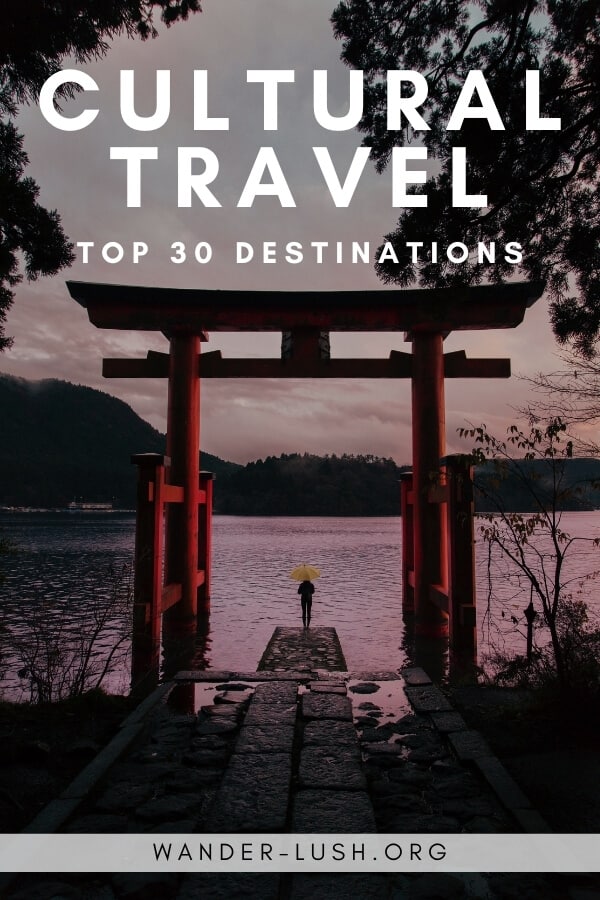
World’s best cultural trips: Save it & share it on Pinterest
More cultural travel inspiration.
- 30+ amazing cultural experiences around the world
- Best cultural festivals around the world
- Best destinations for tea culture
- Best destinations for wine culture
- Unique food cultures around the globe
- My collection of cultural travel guides for 30+ cities and regions
- World’s best unique & underrated travel destinations
This is a very wonderful article about cultural destinations! Thank you so much for sharing!
One can easily visit India and experience the different kinds of cultures in a particular place. Tourism in India has been much more managed and safe with passage of time. Rajasthan tourism has been the most reliable and safe in India. One can enjoy all the traditional dishes and enjoy living in the palaces as a hotel room in different cities. But, whenever you are visiting to Rajasthan, India travel guide is a must because one can easily lose track of pathways in the puzzle like roads of the cities in Rajasthan. One can easily plan for a Kerala tour packages because of the minimal expenses in the state.
Leave a Reply Cancel reply
Your email address will not be published. Required fields are marked *
- Subscribe to future posts
- Careers and Internships
- Cornell Open
- Guest Lecturers
Histories & Cultures of Tourism
Series Editor(s)
Eric G. E. Zuelow
Editorial Board Todd Cleveland Stephen Harp Diane Koenker Yajun Mo
Acquiring Editor
Bethany Wasik
A sizzling hot summer of recent memory saw countless communities pushing back against the tourists who fuel their economies. Spanish leftists sprawled “tourists go home” on buildings. The Swiss lamented that tourists were turning their home into “an open-air toilet.” Italians agonized that the greatest threat to Venice was not rising oceanic levels, but the tide of tourists swarming the famous canals and architectural landmarks. An editorial in The Guardian opined that “only governments can stem the tide of tourism sweeping the globe”—as though tourism were a global pandemic, as opposed to something carefully constructed by governments and others. There is nothing new about the tension between hosts and guests; such discord arose with the very birth of modern tourism. Yet these latest exchanges seem more strident. What are the implications of tourism for politics, for the environment, for the evolution of identities?
Cornell University Press’s book series is uniquely positioned to examine tourist practices through a historical lens. In recent years, what was a small field of study, focused mainly on spas and seaside tourism, expanded dramatically. Scholars now recognize that tourism is a means to explore a range of intersectional issues like race, class, and gender. Studying leisure travel offers a way to comprehend the interplay of particular national histories and the processes and implications of globalization. Books in the series thus give tourism its due as an engine of historical change: from antiquity, through the Grand Tour, to the birth of leisure travel, and the boom of mass tourism.


- Division of Arts and Culture
The Division of Arts and Culture promotes arts and culture as essential to quality of life for all Floridians.
Para español, seleccione de la lista
- Department of State
- Info and Opportunities
Resources by Topic
- Cultural Tourism Toolkit
- What is Cultural Tourism? - Basic Information
What is cultural tourism?
According to the United Nations World Tourism Organization, cultural tourism is “movements of persons for essentially cultural motivations such as study tours, performing arts and cultural tours, travel to festivals and other cultural events, visits to sites and monuments, travel to study nature, folklore or art, and pilgrimages.”
We expand this definition to encompass the participation of visitors in cultural activities whether those activities are the primary purpose of their travel or not.
Why should my organization take action on cultural tourism?
Cultural tourism is big business in Florida. Our state attracts more than 100 million visitors per year, and 65% of those visitors take part in at least one cultural activity.
These visitors spend more on their trips and stay longer than other visitors.
Creating a plan to attract cultural tourism can do more than affect your bottom line, it can also help define your area as a cultural and artistic destination.
Why would a visitor come to my area?
Travelers look for an “authentic experience,” and your community has its own special attributes that set it apart from others. These features include your history, traditions, and yes, your arts and culture.
Your community has a story to tell, and finding an engaging way to tell that tale is one way to attract visitors. Tools are available for creating an inventory of community assets. A few of them are found as links in this toolkit.
Where to begin?
That’s up to you! Engage with other organizations and individuals in your area, or simply measure the effect visitors have on your own organization. The important thing to do is to start somewhere . You don’t even have to spend any money.
How do I approach my local Destination Marketing Organization (DMO)or Convention & Visitors Bureau (CVB)?
Sometimes arts and cultural organizations may be daunted at the idea of approaching the local DMO or CVB. Arts and cultural organizations create value for tourists by offering experiences that cannot be found elsewhere.
You have a product that your DMO can sell… and their goal is to sell your area to visitors. You may find that showing them how many visitors take advantage of your services will catch the DMO’s interest. You may find that the excellent quality of your work will excite them as much as you know it will excite tourists. Finding your way in may be difficult, but it can be done.
Remember, bring them a quality product and show them how they can use it to their own advantage.
Another helpful step is to integrate the boards of directors of DMO/CVB’s with the boards of arts and cultural organizations. If a member of the DMO board is interested in arts and culture, there may be an opportunity for expanding their interest by having a conversation regarding an upcoming project or event.
In addition, if you have someone from the tourism industry on your board, they may be able to provide some useful guidance and new ideas for promoting cultural tourism in the community.
What can I measure that relates to cultural tourism?
You can always start small in measurements. Try collecting the zip codes of your patrons as a way to find out how many of them traveled to your event or activity. Think of what you want to accomplish, and ask yourself some important questions:
“Why do we do what we do?”
“Why do people take advantage of my current offerings?”
“For what reasons are we funded?”
“What change are we trying to create in our community?”
These questions and others like them can help you decide what to measure and how to measure it.
Once you have your numbers, analyze them and look at how you can improve what you’re doing.
Once you’ve implemented a change, no matter how small, measure again to see if you’ve achieved the outcome you wanted.
- Accessibility
- Artist Estate and Legacy Planning
- Arts in Education
- Arts in Health
- Economic Impact of the Arts
- Emergency Preparedness and Recovery
- Cultural Tourism Funding Resources
- Directory of Florida Direct Marketing Organizations (DMOs)
- Arts & Culture Event and Calendar Websites in Florida
- Useful Links

Ron DeSantis, Governor Cord Byrd, Secretary of State
- Privacy Policy
Questions or comments? Contact Us Submit a public records request.
Under Florida law, e-mail addresses are public records. If you do not want your e-mail address released in response to a public records request, do not send electronic mail to this entity. Instead, contact this office by phone or in writing.
Copyright © 2024 State of Florida, Florida Department of State.
Florida Department of State Phone: 850.245.6500
R.A. Gray Building 500 South Bronough Street Tallahassee, Florida 32399-0250
Winter is here! Check out the winter wonderlands at these 5 amazing winter destinations in Montana
- Travel Tips
How Does Tourism Affect Culture
Published: December 12, 2023
Modified: December 28, 2023
by Dorolisa Templin
- Arts & Culture
- Plan Your Trip
Introduction
Travel and tourism have become increasingly popular activities in recent years, with people from all over the world exploring new destinations and immersing themselves in different cultures. While tourism brings numerous benefits, such as economic growth and job opportunities, it also has some less desirable effects on culture. In this article, we will examine the impact of tourism on culture, including its economic, social, environmental, and cultural aspects.
When tourists visit a new destination, they bring with them their own set of beliefs, customs, and behaviors. These interactions between tourists and the local community can significantly influence the cultural dynamics of a place. It is crucial to understand how tourism affects culture to ensure that the positive aspects are maximized, while the negative repercussions are minimized.
Over the years, the global tourism industry has grown exponentially, resulting in an increasing number of tourists venturing to various parts of the world. This influx of visitors can put immense pressure on the local culture and traditions.
In the following sections, we will explore how tourism affects culture from different perspectives, including the economic impact, social impact, environmental impact, and cultural impact. We will also delve into the challenges and issues that arise in preserving culture amidst the growth of tourism, as well as strategies to strike a balance between tourism and cultural preservation.
Additionally, we will examine real-life case studies that illustrate the effect of tourism on culture. These examples will serve to highlight the diversity of experiences and shed light on the various ways tourism can shape and transform a culture.
By understanding the complexities of tourism’s impact on culture, we can work towards creating sustainable and responsible tourism practices that not only benefit the economy but also respect and preserve the cultural heritage of communities around the world. Join us as we delve into this fascinating topic and explore the multifaceted relationship between tourism and culture.
Economic Impact of Tourism on Culture
The economic impact of tourism on culture is significant and multifaceted. Tourism can boost the local economy by creating jobs and generating revenue through visitor spending. When tourists visit a destination, they often engage in various cultural activities, such as visiting museums, attending traditional events, or purchasing local handicrafts. These activities contribute to the preservation and promotion of the local culture, while also providing economic benefits to the community.
One of the key economic benefits of tourism is the creation of employment opportunities. As tourism increases, there is a growing demand for workers in various sectors such as hospitality, transportation, and retail. This leads to job creation, reducing unemployment rates and improving the standard of living for local residents. Additionally, the revenue generated from tourism can be reinvested in the cultural sector, supporting the development and maintenance of cultural sites and activities.
Moreover, tourism can stimulate entrepreneurship and the growth of small businesses within the local community. Local artisans and craftsmen can showcase and sell their products to tourists, providing a sustainable source of income and contributing to the preservation of traditional crafts. This not only supports the local economy but also helps to promote and preserve unique cultural traditions.
However, it is essential to strike a balance between economic growth and the preservation of culture. The pursuit of economic benefits should not come at the expense of cultural integrity. It is crucial to implement sustainable tourism practices that respect and preserve the authenticity of local culture, ensuring that economic growth is coupled with cultural preservation.
Overall, the economic impact of tourism on culture can be highly beneficial if managed responsibly. By leveraging the economic opportunities that tourism presents, while also respecting and preserving cultural heritage, destinations can create a sustainable and thriving tourism industry that benefits both the local economy and the cultural richness of the community.
Social Impact of Tourism on Culture
Tourism has a significant social impact on culture, both positive and negative. It brings people from different backgrounds together, fostering multicultural exchanges and promoting understanding and tolerance. However, it can also lead to social disruptions and conflicts if not managed properly.
One of the positive social impacts of tourism on culture is the promotion of cultural exchange and appreciation. When tourists visit a destination, they often engage with the local community, interact with locals, and learn about their traditions, customs, and way of life. This exchange of ideas and experiences can lead to a greater understanding and respect for diverse cultures, promoting global citizenship and breaking down cultural barriers.
Furthermore, tourism can empower local communities, especially marginalized groups, by providing them with opportunities to showcase their culture and traditions. Indigenous communities, for example, can use tourism as a platform to share their rich cultural heritage, enabling them to preserve their traditions and generate income at the same time. This empowerment can boost self-esteem, cultural pride, and preserve the social fabric of the community.
However, tourism can also have negative social impacts on culture. The influx of tourists can cause overcrowding and disrupt the daily lives of locals. Traditional communities may experience changes in their social dynamics, as they adapt to cater to the preferences and demands of tourists. Additionally, there can be instances of cultural commodification, where cultural practices are commercialized for the sake of tourism, leading to the dilution or distortion of authentic traditions.
It is crucial to mitigate the negative social impacts of tourism by implementing sustainable tourism practices and fostering community engagement. Local communities should be actively involved in decision-making processes, ensuring their voices are heard and their cultural needs are considered. This can include regulating visitor numbers, promoting responsible tourism behavior, and providing locals with opportunities to participate in tourism-related activities.
Overall, the social impact of tourism on culture is complex and multifaceted. By promoting cultural exchange, empowering local communities, and fostering responsible tourism practices, we can harness the positive social benefits of tourism while mitigating its negative effects, ultimately creating a harmonious relationship between tourism and culture.
Environmental Impact of Tourism on Culture
The environmental impact of tourism on culture is a critical consideration in sustainable tourism practices. While tourism can contribute to the preservation and conservation of natural and cultural resources, it can also pose significant threats to the environment.
One of the key environmental impacts of tourism on culture is the degradation of natural habitats and ecosystems. The increased visitor footfall in ecologically sensitive areas can disrupt local flora and fauna, leading to habitat destruction and loss of biodiversity. Moreover, improper waste management and pollution associated with tourism activities can contaminate water bodies, degrade air quality, and harm the natural environment.
Cultural sites and heritage buildings can also be adversely affected by tourism activities. A high influx of tourists can result in excessive wear and tear on archaeological sites, monuments, and historical sites. It is crucial to implement proper conservation measures and visitor management strategies to protect these cultural treasures.
However, tourism can also have a positive environmental impact on culture. Sustainable tourism practices that prioritize environmental conservation can help protect natural resources and preserve cultural heritage. Responsible tourism initiatives such as eco-tourism, community-based tourism, and nature conservation projects can contribute to the preservation of the environment while providing opportunities for visitors to experience and appreciate the local culture.
By implementing sustainable tourism practices, such as reducing carbon emissions, minimizing waste generation, conserving water resources, and supporting local conservation efforts, tourism can have a positive impact on the environment and contribute to the long-term preservation of cultural heritage.
Educating tourists about the importance of environmental conservation and cultural preservation is crucial. Tourists should be encouraged to engage in responsible tourism behavior, respecting the natural environment, and adhering to local cultural norms. This can be achieved through informative signage, guided tours, and educational programs that highlight the significance of culture and the environment.
Overall, the environmental impact of tourism on culture is a complex issue. By implementing sustainable practices, raising awareness, and fostering a sense of responsibility among tourists, we can ensure that tourism not only enriches cultural experiences but also contributes to the protection and conservation of the natural environment.
Cultural Impact of Tourism on Culture
The cultural impact of tourism is perhaps one of the most profound and direct effects of tourism on a destination. It influences the local traditions, customs, and identity of a community. The interactions between tourists and the local culture can result in both positive and negative outcomes.
One of the positive cultural impacts of tourism is the revitalization and preservation of traditional cultural practices. When tourists show interest in local traditions, communities may feel a renewed sense of pride in their cultural heritage. This can lead to the preservation and promotion of traditional arts, crafts, music, dances, and festivals. Additionally, tourism can provide economic incentives for the continued practice of these cultural activities.
Tourism can also create platforms for cultural exchange, promoting intercultural understanding and appreciation. Through interaction with visitors, locals have the opportunity to share their stories, traditions, and beliefs, fostering a sense of mutual respect and understanding. This cultural exchange can challenge stereotypes, break down barriers, and foster empathy among people from different backgrounds.
However, there are also negative cultural impacts associated with tourism. One such impact is the erosion of local culture under the influence of mass tourism. When a destination becomes overly reliant on tourism, there is the potential for the commodification and commercialization of culture, where authenticity is compromised for the sake of catering to tourist expectations. This can lead to the loss of cultural integrity and the homogenization of local traditions.
Furthermore, the sheer volume of tourists in popular destinations can disrupt the social fabric of local communities. The influx of tourists can lead to overcrowding, making it challenging for locals to maintain their way of life and feel a sense of belonging in their own neighborhoods. This can result in tensions between residents and tourists and a loss of cultural cohesion.
It is crucial to strike a balance between tourism and cultural preservation. This can be achieved by implementing sustainable tourism practices that prioritize cultural preservation, empowering local communities in decision-making processes, and promoting authentic and responsible cultural experiences. Encouraging visitors to interact respectfully with the local culture and educating them about cultural norms and traditions can also help mitigate negative cultural impacts.
Overall, the cultural impact of tourism on culture is both complex and influential. By recognizing and addressing the positive and negative outcomes, destinations can harness the power of tourism to foster cultural appreciation, preserve local traditions, and create meaningful and authentic cultural experiences for both locals and visitors.
Challenges and Issues in Tourism and Cultural Preservation
While tourism has the potential to positively impact cultural preservation, it also poses significant challenges and issues that need to be addressed to ensure the long-term sustainability and preservation of culture. These challenges include:
Over tourism: Overcrowding of popular destinations due to excessive tourism can place immense pressure on local communities and their cultural heritage. The sheer number of visitors can lead to the degradation of cultural sites, erosion of authentic traditions, and a loss of quality of life for residents.
Cultural commodification: There is a risk of cultural commodification, where cultural practices and traditions are exaggerated or distorted solely for the purpose of attracting tourists. This can result in the loss of cultural authenticity and the exploitation of cultural heritage for commercial gain.
Unbalanced economic benefits: Tourism can result in an uneven distribution of economic benefits, with large tourism companies or outside investors reaping the majority of profits while local communities and cultural practitioners receive only minimal benefits. This can lead to socio-economic disparities and the marginalization of local cultures and communities.
Lack of community participation: Inadequate involvement of local communities in tourism planning and decision-making processes can result in the mismanagement and unsustainable development of cultural sites. It is crucial to empower local communities and engage them in shaping tourism policies and practices that align with their cultural values and aspirations.
Inadequate infrastructure and resources: Insufficient infrastructure and resources to support tourism and cultural preservation can hinder effective management and protection of cultural heritage sites. Without proper facilities and sustainable practices, the preservation of culture may be compromised, resulting in irreversible damage.
Climate change and environmental degradation: The impacts of climate change and environmental degradation pose a significant threat to cultural preservation. Rising sea levels, natural disasters, and habitat destruction can lead to the loss of cultural sites and traditions that are closely tied to the environment.
To address these challenges, it is essential to adopt a holistic and sustainable approach to tourism and cultural preservation. This includes the implementation of responsible tourism practices that prioritize cultural authenticity, community involvement, and environmental sustainability. Engaging local communities in decision-making processes and ensuring equitable distribution of economic benefits can also foster a sense of ownership and commitment to preserving culture.
Moreover, raising awareness among tourists about the importance of cultural preservation, encouraging respectful behavior, and promoting sustainable travel choices are all vital in supporting cultural resilience and safeguarding cultural heritage for future generations.
Cultural preservation should be seen as a collective responsibility, involving collaboration between local communities, governments, tourism stakeholders, and visitors. By addressing these challenges and working towards sustainable solutions, we can create a tourism industry that preserves and celebrates the rich cultural diversity of our world.
Strategies for Balancing Tourism and Cultural Preservation
Striking a balance between tourism and cultural preservation is crucial to ensure the long-term sustainability and authenticity of destinations. Here are some key strategies that can help achieve this balance:
1. Sustainable tourism planning: Implementing comprehensive tourism planning that considers the cultural, social, economic, and environmental impacts is essential. This involves conducting thorough impact assessments, setting carrying capacities for tourist sites, and establishing regulations and guidelines to protect cultural heritage.
2. Community involvement: Engaging local communities in decision-making processes is vital for successful cultural preservation. Involving community members in tourism planning, development, and management empowers them to take ownership of their cultural heritage and ensures that their voices are heard.
3. Cultural education and awareness: Educating tourists about the cultural significance of a destination fosters respect and understanding. Providing information and organizing cultural workshops or guided tours can help visitors appreciate the local culture, customs, and traditions, encouraging responsible and respectful behavior.
4. Promotion of sustainable practices: Encouraging sustainable tourism practices is crucial for protecting cultural heritage. This includes promoting responsible travel, supporting local businesses, reducing resource consumption, and minimizing waste generation. Collaborating with tourism operators and businesses to adopt sustainable practices can have a positive impact on both culture and the environment.
5. Development of alternative attractions: Developing alternative attractions and dispersing tourist flows can help alleviate the pressure on overcrowded destinations. By promoting lesser-known sites and encouraging visitors to explore different areas, tourism can be better distributed, benefiting both popular and emerging destinations.
6. Preservation of authenticity: It is essential to preserve and promote cultural authenticity. Encouraging the continued practice of traditional crafts, cuisine, music, and dances, while discouraging the commercialization and dilution of cultural traditions, helps maintain the integrity of the local culture.
7. Capacity building and training: Providing training and capacity-building programs for local communities, tourism operators, and cultural practitioners equips them with the knowledge and skills necessary to manage tourism sustainably. This ensures that cultural preservation is effectively integrated into tourism practices.
8. Collaboration and partnerships: Collaboration between different stakeholders, including government agencies, community organizations, tourism operators, and NGOs, is essential for effective cultural preservation. Building partnerships and fostering dialogue can facilitate the exchange of ideas, resources, and best practices, leading to more sustainable tourism development.
9. Monitoring and evaluation: Regular monitoring and evaluation of tourism impacts on culture are crucial to identify emerging issues and assess the effectiveness of implemented strategies. This allows for adjustments and improvements to be made, ensuring that cultural preservation remains a priority.
By adopting these strategies, destinations can achieve a balance between tourism development and cultural preservation. Promoting responsible tourism practices, involving local communities, and preserving the authenticity of cultural traditions contribute to the long-term sustainability and enjoyment of cultural heritage for both present and future generations.
Case Studies on the Effect of Tourism on Culture
Examining real-life case studies can provide valuable insights into the diverse ways in which tourism can impact culture. Here are two notable examples:
1. Bhutan: Bhutan, a small country in the Himalayas, has gained international recognition for its unique approach to tourism and cultural preservation. In an effort to protect its cultural heritage and promote sustainable tourism, Bhutan has adopted a high-value, low-impact tourism policy. The government regulates tourist numbers through a daily fee and requires visitors to book through authorized tour operators. This approach has allowed Bhutan to carefully manage its cultural sites and traditions while ensuring that tourism benefits local communities. Visitors have the opportunity to immerse themselves in Bhutanese culture, participating in local festivals, engaging with the community, and experiencing traditional arts and crafts. By prioritizing cultural preservation and sustainable tourism practices, Bhutan has successfully maintained its unique cultural identity.
2. Venice, Italy: Venice, known for its historic canals and stunning architecture, has been facing significant cultural challenges due to tourism. The city has experienced an overwhelming influx of tourists, which has put immense pressure on its infrastructure and local lifestyle. The overwhelming number of visitors has caused congestion, increased pollution, and driven up housing prices, leading to the displacement of local residents. As a result, Venice has been grappling with the preservation of its cultural heritage and ensuring the well-being of its residents. To address these issues, the city has implemented measures to manage tourism, including limiting the number of cruise ships, regulating tourist accommodations, and promoting responsible visitor behavior. These efforts aim to strike a balance between preserving the city’s cultural heritage and creating a sustainable tourism industry that respects the local community’s way of life.
These case studies highlight the importance of proactive measures in managing the impact of tourism on culture. By implementing well-designed policies, destinations can protect their cultural heritage, support local communities, and create a harmonious relationship between tourism and culture.
The relationship between tourism and culture is a complex and dynamic one. Tourism has the potential to bring both positive and negative impacts on the preservation and promotion of culture. It is crucial to strike a balance that ensures the long-term sustainability and authenticity of cultural heritage while harnessing the economic and social benefits that tourism can bring.
Throughout this article, we have explored the economic, social, environmental, and cultural impacts of tourism on culture. We have seen that responsible tourism practices can create opportunities for economic growth, job creation, and cultural preservation. By engaging with local communities, promoting sustainable practices, and empowering cultural practitioners, tourism can generate positive social and economic outcomes while respecting and promoting local traditions.
However, challenges and issues exist that must be addressed. From over-tourism to cultural commodification, these challenges require thoughtful strategies and collaboration between various stakeholders. It is essential to involve local communities in decision-making processes and prioritize the preservation of cultural authenticity and integrity.
Real-life case studies have provided valuable insights into how destinations navigate the complex relationship between tourism and cultural preservation. From Bhutan’s successful approach to sustainable tourism to the challenges faced by Venice, these examples illustrate the importance of proactive measures and responsible tourism practices in achieving a balance that benefits both cultural preservation and the tourism industry itself.
In conclusion, by adopting strategies that prioritize cultural preservation, responsible tourism behavior, community involvement, and sustainable development, destinations can create a thriving tourism industry while safeguarding their cultural heritage. The effective management of tourism’s impact on culture requires collaboration, education, and continuous monitoring to ensure that future generations can enjoy and appreciate the rich diversity of cultures around the world.

- Privacy Overview
- Strictly Necessary Cookies
This website uses cookies so that we can provide you with the best user experience possible. Cookie information is stored in your browser and performs functions such as recognising you when you return to our website and helping our team to understand which sections of the website you find most interesting and useful.
Strictly Necessary Cookie should be enabled at all times so that we can save your preferences for cookie settings.
If you disable this cookie, we will not be able to save your preferences. This means that every time you visit this website you will need to enable or disable cookies again.
6 years to the Global Goals – here's how tourism can help get us there

Inclusive governance and community engagement in tourism planning and management can aid sustainable development goals. Image: Unsplash/D Jonez
.chakra .wef-1c7l3mo{-webkit-transition:all 0.15s ease-out;transition:all 0.15s ease-out;cursor:pointer;-webkit-text-decoration:none;text-decoration:none;outline:none;color:inherit;}.chakra .wef-1c7l3mo:hover,.chakra .wef-1c7l3mo[data-hover]{-webkit-text-decoration:underline;text-decoration:underline;}.chakra .wef-1c7l3mo:focus,.chakra .wef-1c7l3mo[data-focus]{box-shadow:0 0 0 3px rgba(168,203,251,0.5);} Zurab Pololikashvili

.chakra .wef-1nk5u5d{margin-top:16px;margin-bottom:16px;line-height:1.388;color:#2846F8;font-size:1.25rem;}@media screen and (min-width:56.5rem){.chakra .wef-1nk5u5d{font-size:1.125rem;}} Get involved .chakra .wef-9dduvl{margin-top:16px;margin-bottom:16px;line-height:1.388;font-size:1.25rem;}@media screen and (min-width:56.5rem){.chakra .wef-9dduvl{font-size:1.125rem;}} with our crowdsourced digital platform to deliver impact at scale
- Tourism is a significant economic force that has returned close to pre-pandemic figures, with 1.3 billion international travellers and tourism exports valued at approximately $1.6 trillion in 2023.
- The tourism sector must adopt sustainable practices in response to climate change, biodiversity loss and pollution.
- Inclusive governance and community engagement in tourism planning and management are key to ensuring the sector’s support to local identity, rights and well-being.
With mounting challenges to our societies – conflict, geopolitical tension, climate change and rising inequality – we should look to the 17 Sustainable Development Goals (SDGs) and their promise of a shared blueprint for peace, prosperity, people and planet by 2030. However, as UN Secretary General Antonio Guterres reminds us , “that promise is in peril” with the impact of the COVID-19 pandemic having stalled three decades of steady progress.
Tourism can help deliver a better future, and with less than six years to go, it must unleash its full power to achieve this.
Have you read?
Turning tourism into development: mitigating risks and leveraging heritage assets, what is travel and tourism’s role in future global prosperity, how travel and tourism can reach net zero, tourism’s economic boon.
International tourists reached 88% of pre-pandemic levels in 2023. Around 1.3 billion tourists travelled internationally, with total tourism exports of $1.6 trillion, almost 95% of the $1.7 trillion recorded pre-pandemic. Preliminary estimates indicate that tourism's direct gross domestic product (GDP) reached $3.3 trillion, the same as 2019, as per our World Tourism Barometer .
Yet, persisting inflation, high interest rates, volatile oil prices and disruptions to trade could impact the pace of recovery. Uncertainty derived from ongoing Russian aggression against Ukraine, the Israel-Hamas conflict and growing tensions in the Middle East, alongside other mounting geopolitical tensions, may also weigh on traveller confidence.
Results from the World Economic Forum’s latest Travel & Tourism Development Index reflect the impact of some of these challenges on the sector’s recovery and travel and tourism’s potential to address many of the world’s growing environmental, social and economic problems.
Therefore, as the sector returns, it remains our responsibility to ensure that this is a sustainable, inclusive and resilient recovery.
The climate imperative
Climate change, pollution and biodiversity loss are making extreme weather events increasingly challenging for destinations and communities worldwide. The tourism sector is simultaneously highly vulnerable to climate change and a contributor to harmful greenhouse gas emissions.
Accelerating climate action in tourism is critical for the sector’s and host communities’ resilience. We are taking responsibility but more needs to be done to reduce plastics, curb food waste, protect and restore biodiversity, and reduce emissions as the demand for travel grows.
The framework proposed by the Glasgow Declaration on Climate Action in Tourism is catalyzing the development and implementation of climate action plans, guided by and aligned to five pathways (measure, decarbonize, regenerate, collaborate and finance). It’s a clear plan to enable the transition towards low carbon and regenerative tourism operations for resilience. Over 850 signatories from 90 countries are involved in innovating solutions, creating resources and connecting across supply chains, destinations and communities.
Leaving no-one behind
Tourism can be a powerful tool to fight inequality, within and between countries but only so long as we also address diversity, equity and inclusion in the sector, provide decent jobs and ensure respect for host communities and shared benefits.
One good example of tourism’s potential to progress shared prosperity is Rwanda’s Tourism Revenue Sharing Programme . Initiated in 2005 and revised in 2022, it aligns conservation efforts with community development. The programme designates a portion of National Parks revenues to ensure that local communities benefit directly from conservation and tourism activities. Initially set at 5%, the share of total revenue now stands at 10% .
Travel & Tourism Development Index 2024
New tools, jobs and values
Technology, ease of travel and the pandemic have all accelerated changes in how we work. Again, as we progress, we have a duty to ensure we are leaving nobody behind. Education and skills are vital to progressing equality, growth and opportunities for all, making them a cornerstone of the SDGs. However, tourism businesses face a labour shortage to cope with travel demand. We must make tourism more attractive to young people so they see it as a valued career path.
We also need to support micro-, small- and medium-sized enterprises (MSMEs), which make up around 80% of all tourism businesses worldwide and up to 98% in some Group of 20 (G20) economies. While each country’s challenges are different, digitization, market access, marketing and skill gaps are key areas we should address with targeted policies for MSMEs and entrepreneurship.
Measuring impact
Sustainable tourism is only possible if we can properly measure the sector’s impact and progress in three dimensions: economic, social and environmental.
Last March, the UN adopted a new global standard to measure the sustainability of tourism (MST) – economic, social and environmental. Developed under the leadership of UN Tourism and endorsed by all 193 UN member states, the MST statistical framework provides the common language (agreed definitions, tables and indicators) for producing harmonized data on key economic, social and environmental aspects of tourism.
Countries and other stakeholders now have the foundation to produce trustworthy, comparable data for steering the sector towards its full potential. And indeed, over 30 countries and subnational regions have already implemented the flexible MST framework, focusing on the data most relevant to their sustainability efforts.
Centring community wellbeing
Increasingly, communities worldwide demand a tourism sector that respects their identity, rights and wellbeing.
Transforming the sector requires rethinking governance as more holistic with a whole-government approach, multi-level coordination between national and local policies and strong public-private-community partnerships. Listening and engaging residents in tourism planning and management is at the core of the sector’s future.
Take Barcelona as an example. Here, e tourism represents 14% of the city’s GDP. The Tourism and City Council was created in 2016 and relies on citizen participation to advise the municipal government on tourism public policies. This initiative demonstrates the advancement of tourism governance from classic public-private collaboration to public-private-community. Therefore, issues around the visitor economy become those for official city consideration.
Delivering on tourism’s potential
We urgently need to grow investment in tourism. The data is encouraging: the UN Conference on Trade and Development World Investment Report 2023 shows that global foreign direct investment across all sectors, tourism included, reached approximately $1.37 trillion that year, marking a modest increase of 3% from 2022.
At the same time, we need to ensure this investment is targeted where it will make the most significant and most positive impact by building greater resilience and accelerating the shift towards greater sustainability.
The significant benefits tourism can offer our economies and societies, as well as the challenges obstructing us from fully delivering on this potential, are now more widely recognized than ever.
Tourism is firmly on the agenda of the UN, G20 and Group of Seven nations and the Forum. Delivering on this potential, however, will require political commitment and significant investment. But given what is at stake and the potential benefits to be gained, it should be seen as a huge opportunity rather than a daunting challenge.
Don't miss any update on this topic
Create a free account and access your personalized content collection with our latest publications and analyses.
License and Republishing
World Economic Forum articles may be republished in accordance with the Creative Commons Attribution-NonCommercial-NoDerivatives 4.0 International Public License, and in accordance with our Terms of Use.
The views expressed in this article are those of the author alone and not the World Economic Forum.
The Agenda .chakra .wef-n7bacu{margin-top:16px;margin-bottom:16px;line-height:1.388;font-weight:400;} Weekly
A weekly update of the most important issues driving the global agenda
.chakra .wef-1dtnjt5{display:-webkit-box;display:-webkit-flex;display:-ms-flexbox;display:flex;-webkit-align-items:center;-webkit-box-align:center;-ms-flex-align:center;align-items:center;-webkit-flex-wrap:wrap;-ms-flex-wrap:wrap;flex-wrap:wrap;} More on Sustainable Development .chakra .wef-17xejub{-webkit-flex:1;-ms-flex:1;flex:1;justify-self:stretch;-webkit-align-self:stretch;-ms-flex-item-align:stretch;align-self:stretch;} .chakra .wef-nr1rr4{display:-webkit-inline-box;display:-webkit-inline-flex;display:-ms-inline-flexbox;display:inline-flex;white-space:normal;vertical-align:middle;text-transform:uppercase;font-size:0.75rem;border-radius:0.25rem;font-weight:700;-webkit-align-items:center;-webkit-box-align:center;-ms-flex-align:center;align-items:center;line-height:1.2;-webkit-letter-spacing:1.25px;-moz-letter-spacing:1.25px;-ms-letter-spacing:1.25px;letter-spacing:1.25px;background:none;padding:0px;color:#B3B3B3;-webkit-box-decoration-break:clone;box-decoration-break:clone;-webkit-box-decoration-break:clone;}@media screen and (min-width:37.5rem){.chakra .wef-nr1rr4{font-size:0.875rem;}}@media screen and (min-width:56.5rem){.chakra .wef-nr1rr4{font-size:1rem;}} See all

Tourism is bouncing back - but can we make travel sustainable?
Robin Pomeroy and Sophia Akram
May 23, 2024

Protecting the magic of travel - and local economies
Topaz Smith
May 21, 2024

The ‘4 Cs’ of being a Chief Sustainability Officer
Gareth Francis
May 17, 2024

5 ways businesses can help to alleviate poverty
Sreevas Sahasranamam and Vivek Soundararajan
May 3, 2024

5 countries leading the charge on recycling e-waste
UN Tourism | Bringing the world closer
Share this content.
- Share this article on facebook
- Share this article on twitter
- Share this article on linkedin
International tourism reached 97% of pre-pandemic levels in the first quarter of 2024
- All Regions
- 21 May 2024
International tourist arrivals reached 97% of pre-pandemic levels in the first quarter of 2024. According to UN Tourism, more than 285 million tourists travelled internationally in January-March, about 20% more than the first quarter of 2023, underscoring the sector’s near-complete recovery from the impacts of the pandemic.
In 2023 international tourist arrivals recovered 89% of 2019 levels and export revenues from tourism 96%, while direct tourism GDP reached the same levels as in 2019.
UN Tourism’s projection for 2024 points to a full recovery of international tourism with arrivals growing 2% above 2019 levels. In line with this, the newest data released by the UN specialized agency for tourism show that:
Yet it also recalls the need to ensure adequate tourism policies and destination management, aiming to advance sustainability and inclusion, while addressing the externalities and impact of the sector on resources and communities
- The Middle East saw the strongest relative growth, with international arrivals exceeding by 36% pre-pandemic levels in Q1 2024, or 4% above Q1 2023. This follows an extraordinary performance in 2023, when the Middle East became the first world region to recover pre-pandemic numbers (+22%).
- Europe , the world's largest destination region, exceeded pre-pandemic levels in a quarter for the first time (+1% from Q1 2019). The region recorded 120 million international tourists in the first three months of the year, backed by robust intra-regional demand.
- Africa welcomed 5% more arrivals in the first quarter of 2024 than in Q1 2019, and 13% more than in Q1 2023.
- The Americas practically recovered pre-pandemic numbers this first quarter, with arrivals reaching 99% of 2019 levels.
- International tourism is experiencing a rapid recovery in Asia and the Pacific where arrivals reached 82% of pre-pandemic levels in Q1 2024, after recovering 65% in the year 2023.
UN Tourism Secretary-General Zurab Pololikashvili said: "The recovery of the sector is very welcome news for our economies and the livelihoods of millions. Yet it also recalls the need to ensure adequate tourism policies and destination management, aiming to advance sustainability and inclusion, while addressing the externalities and impact of the sector on resources and communities".
By subregions, North Africa saw the strongest performance in Q1 2024 with 23% more international arrivals than before the pandemic, followed by Central America (+15%), the Caribbean and Western Europe (both +7%). Southern Mediterranean Europe exceeded pre-pandemic levels by 1%, while South America virtually reached 2019 levels. Northern Europe recovered 98% of pre-pandemic levels, while Subsaharan Africa and North America both recovered 95%.
According to available data, many destinations across the world continued to achieve strong results in Q1 2024, including Qatar (+177% versus Q1 2019), Albania (+121%), Saudi Arabia (+98%), El Salvador (+90%), Tanzania (+53%), Curaçao (+45%), Serbia (+43%), Turks and Caicos (+42%), Guatemala (+41%) and Bulgaria (+38%).
The robust performance of international tourism can also be seen in the UN Tourism Confidence Index which reached 130 points (on a scale of 0 to 200) for the period January-April, above the expectations (122) expressed for this period in mid-January.
International tourism receipts reached USD 1.5 trillion in 2023, meaning a complete recovery of pre-pandemic levels in nominal terms, but 97% in real terms, adjusting for inflation.
By regions, Europe generated the highest receipts in 2023, with destinations earning USD 660 billion, exceeding pre-pandemic levels by 7% in real terms. Receipts in the Middle East climbed 33% above 2019 levels. The Americas recovered 96% of its pre-pandemic earnings in 2023 and Africa 95%. Asia and the Pacific earned 78% of its pre-crisis receipts, a remarkable result when compared to its 65% recovery in arrivals last year.
Total export revenues from international tourism, including both receipts and passenger transport, reached USD 1.7 trillion in 2023, about 96% of pre-pandemic levels in real terms. Tourism direct GDP recovered pre-pandemic levels, reaching an estimated USD 3.3 trillion in 2023, equivalent to 3% of global GDP.
Several destinations achieved remarkable results in terms of receipts in the first quarter of 2024 as compared to 2019 levels based on available data, including Serbia (+127%), Türkiye (+82%), Pakistan (+72%), Tanzania (+62%), Portugal (+61%), Romania (+57%), Japan (+53%), Mongolia (+50%), Mauritius (+46%) and Morocco (+44%).
Looking ahead to a full recovery globally in 2024
International tourism is expected to recover completely in 2024 backed by strong demand, enhanced air connectivity and the continued recovery of China and other major Asian markets.
The latest UN Tourism Confidence Index shows positive prospects for the upcoming summer season, with a score of 130 for the period May-August 2024 (on a scale of 0 to 200), reflecting more upbeat sentiment than earlier this year. Some 62% of tourism experts participating in the Confidence survey expressed better (53%) or much better (9%) expectations for this 4-month period, covering the Northern Hemisphere summer season, while 31% foresee similar performance as in 2023.
Challenges remain
According to the UN Tourism Panel of Experts, economic and geopolitical headwinds continue to pose significant challenges to international tourism and confidence levels.
IMF's latest World Economic Outlook (April 2024) points to a steady but slow economic recovery, though mixed by region. At the same time, persisting inflation, high interest rates, volatile oil prices and disruptions to trade continue to translate into high transport and accommodations costs.
Tourists are expected to continue to seek value for money and travel closer to home in response to elevated prices and the overall economic challenges, while extreme temperatures and other weather events could impact the destination choice of many travellers. This is increasingly mentioned by the UN Tourism Panel of Experts as a concern for the sector.
Uncertainty derived from the Russian aggression against Ukraine, the Hamas-Israel conflict and other mounting geopolitical tensions, are also important downside risks for international tourism.
As international tourism continues to recover and expand, fuelling economic growth and employment around the world, governments will need to continue adapting and enhancing their management of tourism at the national and local level to ensure communities and residents are at the center of this development.
Related links
- Download News Release on PDF
- Excerpt | World Tourism Barometer - Volume 22 • Issue 2 • May 2024
Category tags
Related content, international tourism to reach pre-pandemic levels in 2024, international tourism to end 2023 close to 90% of pre-p..., tourism’s importance for growth highlighted in world ec..., international tourism swiftly overcoming pandemic downturn.
Uzbekistan's Spanish tour guide
Ruben Sanchez, the only 11-a-side footballer in Uzbekistan, raves about the country's culture, people and tourist attractions.
Ruben Sanchez is the only Spanish footballer playing in Uzbekistan
The Central Asian country is set to host the FIFA Futsal World Cup
Sanchez enthuses about its culture, people and tourist attractions
In July 2022, Spanish footballer Ruben Sanchez began a new phase of his career in Uzbekistan, the host nation of the FIFA Futsal World Cup 2024™. Keen to learn more about the central Asian country, FIFA turned to the Toledo native, who was happy to play the role of guide and offer advice to fans planning to go there for the tournament. With spells at Toledo, Sporting Gijon, Recreativo Granada and Rayo Majadahonda already to his name, the 29-year-old forward is now with his second Uzbek club, having moved to AGMK Olmaliq in January 2023 after six months with Surkhon Termez. Sanchez is the only Spaniard – or person from a Hispanic country – playing in the Uzbekistan Super League. Who better then to tell us what to expect from 14 September to 6 October in host cities Tashkent, Bukhara and Andijan.
FIFA: Having played your football in Uzbekistan since July 2022, you must already know the country pretty well? FIFA: Having played your football in Uzbekistan since July 2022, you must already know the country pretty well?
Ruben Sanchez: The capital Tashkent is very nice, as it combines traditional and modern culture. The city has some very cool areas with nice buildings and parks. One example is Tashkent City Park, which is very large and has buildings that are lit up at night. They have also built a shopping mall that is the largest in Central Asia.
I’ve travelled around the country less than I would have liked, because my football commitments don’t leave me much spare time, but I have to mention Samarkand. It’s a must-see if you visit Uzbekistan, as it’s one of the most historic cities in the country, with it being an important stop on the old Silk Road. Outside the capital, you can find more 'authentic' cities. People are very polite and always willing to help you.
Samarkand is the venue for this Sunday's group-stage draw, which will take place in the unbeatable setting that is the historic Registan Square... Samarkand is the venue for this Sunday's group-stage draw, which will take place in the unbeatable setting that is the historic Registan Square...
Registan Square is one of the most beautiful plazas in the world and not to be missed. Samarkand has many mosques that are steeped in history, and you can see a lot of sights if you’re able to spend two days in the city.
What can we expect from a city of more than three million inhabitants like Tashkent? What can we expect from a city of more than three million inhabitants like Tashkent?
The capital will really surprise you! It is a very touristic city and the centre has people from many countries like Japan, China, Russia, Ukraine and Serbia. Outside the centre, you can find numerous traditional food markets, such as the Chorsu Bazaar, which I highly recommend. You’ll also find every kind of restaurant. People here drink a lot of tea, at any time really, even on very hot days, but they drink less coffee.
Could you recommend a typical local dish? Could you recommend a typical local dish?
Their signature dish is plov, a sweet rice containing raisins, grapes, carrots, lamb, onions and spices. Somsas are a bit like our empanadas (savoury pastries) and are filled with minced lamb or chicken, as well as potato, cheese and onions. There’s also shashlik, which is diced meat on skewers, usually of grilled lamb, although there are variants of beef and chicken. Soups are also very common, and the typical bread is very interesting. But when it comes to everyday life, I do the same supermarket shopping as I did in Spain.
Can you tell us a bit about the Uzbek people, who will be passionately engaged with the FIFA Futsal World Cup? Can you tell us a bit about the Uzbek people, who will be passionately engaged with the FIFA Futsal World Cup?
Andijan, one of the venues for the futsal tournament, has a great love for football. But when the national football team plays, which it does at the Milliy Stadium used by capital side FC Bunyodkor, the club where Rivaldo once played and Luiz Felipe Scolari coached, the venue is packed with passionate supporters. Whenever the national team plays, the fans turn out en masse to support them.
We understand there will be special affection from the locals for Spain because they have another Spaniard as their coach in Venancio Lopez. He is someone steeped in the sport’s history… We understand there will be special affection from the locals for Spain because they have another Spaniard as their coach in Venancio Lopez. He is someone steeped in the sport’s history…
I recently had dinner with him at one of the gatherings the Spanish consul in Uzbekistan organise from time to time. He sat next to me and told me about Uzbekistan's goals for the World Cup. He also told me about their adventure at the Asian Cup, where they finished third, and it’s clear that they have what it takes to perform very well. Venancio said that reaching the last 16, or even surpassing it to have Uzbekistan's best-ever result at a World Cup, would be great.
When you moved to Uzbekistan in 2022, we imagine you didn't know much about the country. What was the move like and how has your time there been? When you moved to Uzbekistan in 2022, we imagine you didn't know much about the country. What was the move like and how has your time there been?
I was about to sign for a club in Spain when I got the offer from FC Surkhon through the Spanish coach who was there. At first, it came as a shock, as I couldn’t even place Uzbekistan on the map. Luckily there were Spaniards playing there already, so I got in touch with them. They told me about Tashkent, the city I was going to be living in, and so I came. I wanted to experience playing outside of Spain, and in truth it was the correct decision. Today I’m happy, as is my partner, who works at an international university here in Tashkent. We’ve adapted very well to the culture of the country. Uzbek people treat tourists very well. When the Surkhon project was finished, the other Spanish left but I received a proposal from another club, which I accepted. We were content and happy here, so we decided to stay on. We feel good here and are suited to life in Uzbekistan.
FUTSAL WORLD CUP STORIES FUTSAL WORLD CUP STORIES
- About Manassas
- Historic Sites
- Manassas Museum
Visitor Guide
- Rainy Day Activities
- Recreation & Outdoors
- Places To Stay

NVA Thai Street Food & Culture Festival
« All Events
Apr 7 @ 10:00 am - 4:00 pm EDT
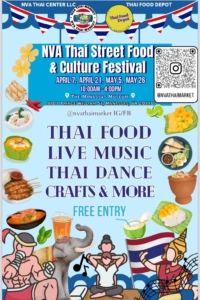
Spend Sundays enjoying authentic Thai street food on the Manassas Museum Lawn April 7, April 21, May 5, May 26, June 9, June 23, July 14, July 28, Aug. 4, Aug. 18, Sept. 8, Sept. 15, Oct. 13, and Nov. 17! To pair with these authentic Thai street eats, there will be live music, Thai dance, crafts, and more! Free entry.
NOTE: On these dates, location is Prince William Commuter Lot (instead of on the museum lawn): June 9, July 28, Aug. 4, Sept. 15.
NVA Thai Market
703-507-3175
View Organizer Website
nvathaicenter@gmail.com
Manassas Museum Lawn
- Google Calendar
- Outlook 365
- Outlook Live
Related Events
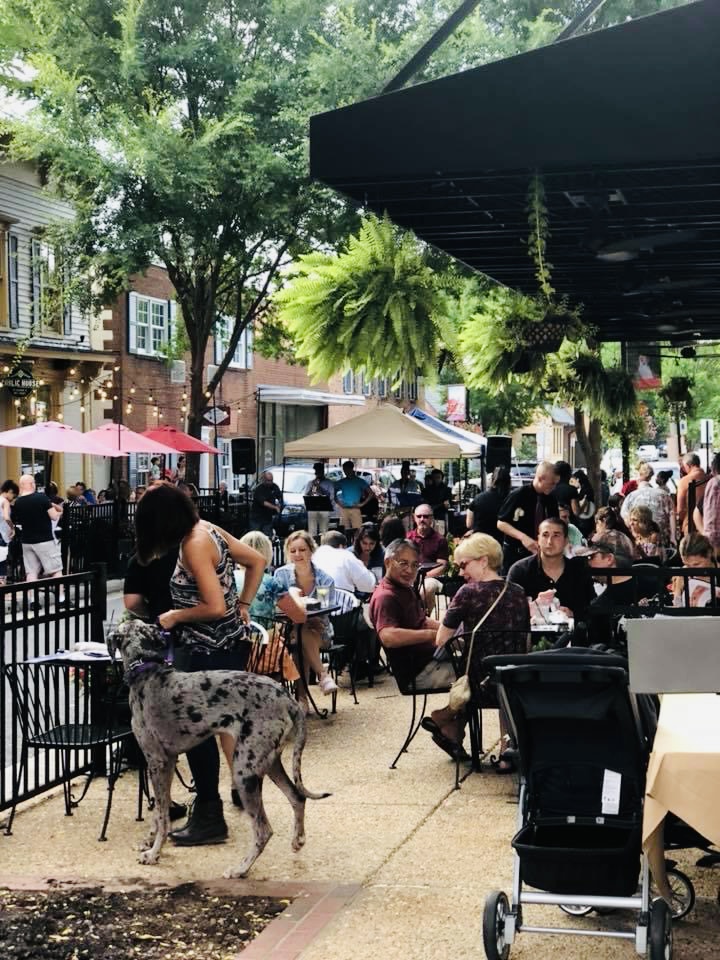
Battle Street Live
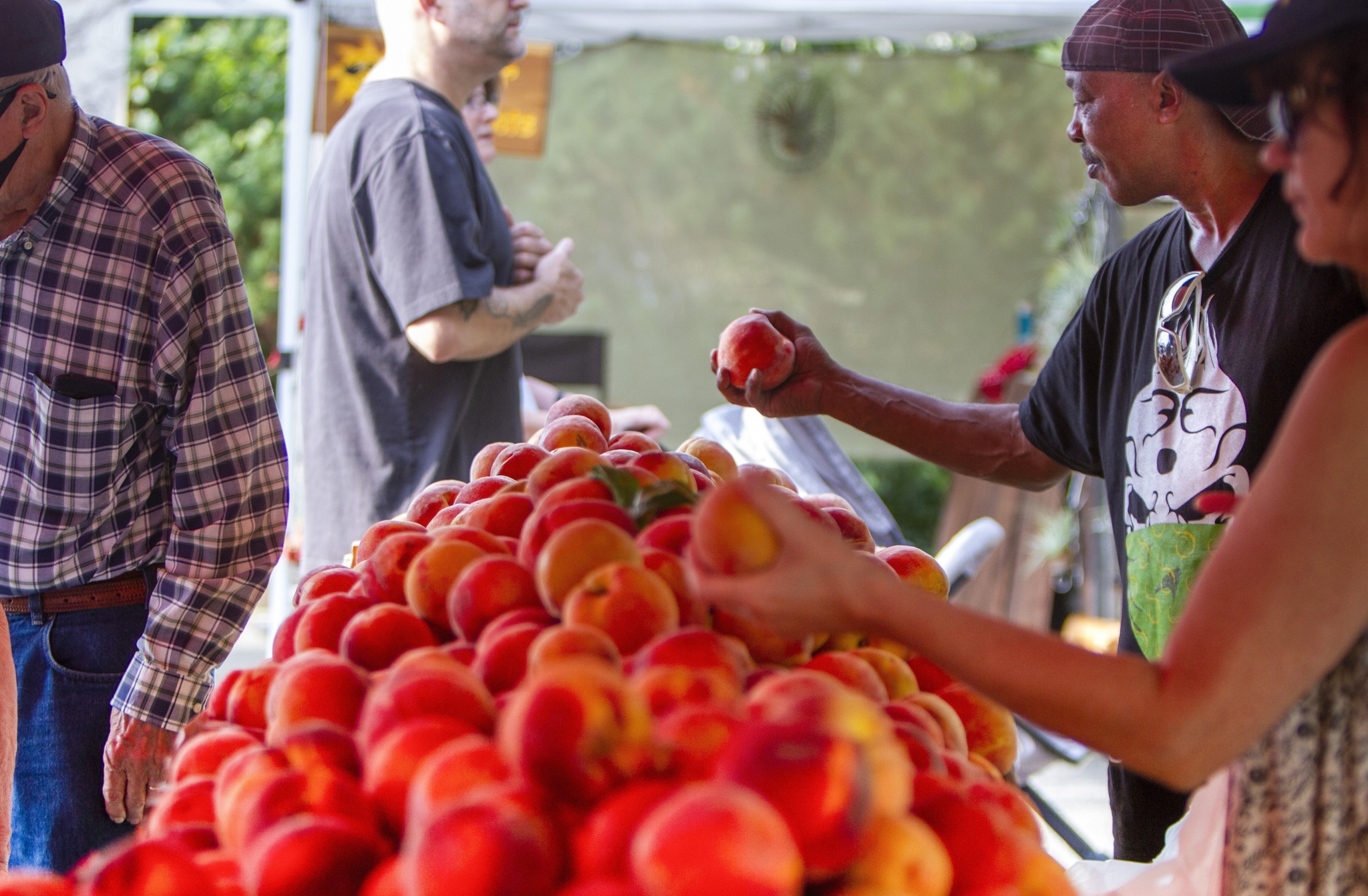
Farmers Market (Saturdays)

- Things To Do
E-Newsletter

Quick Links
Latest posts, banner art for sale, livestream shopping is coming to manassas, lorem ipsum dolor.

IMAGES
VIDEO
COMMENTS
The World Tourism Organisation (WTO) (1985) broadly define cultural tourism as the movements of persons who satisfy the human need for diversity, tending to raise the cultural level of the individual and giving rise to new knowledge, experience and encounters. Cultural tourism is commonly associated with education in this way, some describing ...
This webpage provides UN Tourism resources aimed at strengthening the dialogue between tourism and culture and an informed decision-making in the sphere of cultural tourism. It also promotes the exchange of good practices showcasing inclusive management systems and innovative cultural tourism experiences.. About Cultural Tourism. According to the definition adopted by the UN Tourism General ...
So, mobility is at the core of tourism. In Australia, for example, in 2013 75.8 million people travelled domestically for an overnight trip - spending 283 million visitor nights and $51.5 ...
Cultural tourism in Egypt in the 19th century. Tourists at Hearst Castle, California. Tourists taking pictures at the khmer Pre Rup temple ruins, an example of cultural tourism.. Cultural tourism is a type of tourism in which the visitor's essential motivation is to learn, discover, experience and consume the cultural attractions and products offered by a tourist destination.
Culture has become a key product in the international tourism market, with tourists engaged in cultural activities accounting for 40% of international arrivals in 2016 (UNWTO, Citation 2016).Destinations build on cultural supplies to conform their tourism offer, given the interest of visitors for cultural attractions (OECD, Citation 2009).City tourism relies on culture as a major product (ETC ...
Cultural tourism is a travel and tourism trend that is here to stay. With more and more accessibility to the world and the people in it, there is peak interest in being able to immersively travel. Peaks an interest to immerse yourself in a particular culture. Creates meanings, stories and understanding between host and guest.
Bringing cultural tourism back in the game The COVID-19 pandemic has stopped cultural tourism in its tracks. Throughout 2020 international arrivals plunged by 74% worldwide, dealing a massive blow to the sector, which faces ongoing precarity and unpredictability. Amidst international travel restrictions, border closures and physical distancing measures, countries have been forced to impose ...
The growing body of cultural tourism scholarship is confirmed by a literature search on the term "cultural tourism" on Google Scholar. As Fig. 1 indicates, cultural tourism sources have risen from less than 100 in 1990 to over 6000 in 2016. Growth was particularly sharp between 2005 and 2015, and cultural tourism publications have risen as a proportion of all tourism publications, to reach ...
In discussing the relationship between tourism and culture, it is said that "the convergence between tourism and culture, and the increasing interest of visitors in cultural experiences, bring unique opportunities as well as complex challenges for the tourism sector" (UNWTO 2021).The challenges include the accelerated commercialization of culture which causes overtourism, the crisis of ...
Part 1: Introduction. Culture and tourism have a mutually beneficial relationship which can strengthen the attractiveness and competitiveness of regions and countries. Culture is increasingly an important element of the tourism product, which also creates distinctiveness in a crowded global marketplace. At the same time, tourism provides an ...
Cultural tourism is a significant and growing aspect of the global tourism industry. The United Nations World Tourism Organization (UNWTO) defines cultural tourism as the movement of people to cultural attractions away from their normal residence, with the intention of gathering new information and experiences that satisfy their cultural needs. It encompasses various activities undertaken by ...
Karolina Buczkowska-Gołąbek is an Assistant Professor and researcher specialising in anthropology of culture and tourism (her main research concerns cultural tourists), food in tourism, as well as childhood studies (especially in the context of children, food and travel). She is a university lecturer in Poznań, Poland, where she is also the tutor of Cultural Tourism and Food Tourism courses.
Tourism Culture: Tourism culture is relatively undeveloped due to the limited influence of guest culture and the relative distance between that of guests and hosts. Tourism culture evidenced by a multicultural atmosphere with high levels of economic and cultural entrepreneurship. Hosts and guests in close proximity, sharing spaces and forming ...
Cultural tourism is a form of travel that focuses on exploring and appreciating the unique traditions, history, and practices of a place. It is not just about visiting museums or attending festivals, but also delving deeply into the everyday aspects of local life. Authentic local food, local markets, and even casual chats with locals are an ...
It's a different type of trip entirely. Cultural travel is about experiencing and preserving the various traditions around the world. It's about being open to new experiences and willing to step into another's shoes. Cultural travel is jumping in with both feet and leaving your preconceived notions about what your trip should be behind you.
Since the mid-1980s, another phase of tourism has emerged, namely, one which highlights the cultural component of tourist experiences. This focus has entailed rethinking the nature both of tourism and of its impacts. Specifically, the culture of tourism includes: maximising the culture of tourism products, re-defining tourist experiences ...
Nevertheless, the rapid development of popular culture-induced tourism brings also to the fore its innate fragmentation, which is currently being escalated as disciplinary foci studying different facets of popular culture place boundaries between them according to their own agendas and priorities (Connell, 2012; Lundberg & Ziakas, 2018a).This obscures the common ground, shared among different ...
World's best unique & underrated travel destinations. # Bosnia & Herzegovina # Colombia # Greece # Mauritius # Morocco # Oman # Spain # Taiwan # Timor. Discover the best cultural trips our world has to offer. From India to the Arctic, here are the 30 best countries and regions for cultural tourism.
Tourists increasingly visit places to experience the lifestyles, everyday culture and customs of the people they visit. In many places and countries, the 'creative industries' or the ...
Books in the series thus give tourism its due as an engine of historical change: from antiquity, through the Grand Tour, to the birth of leisure travel, and the boom of mass tourism. Cornell University Press fosters a culture of broad and sustained inqiry through the publication of scholarship that is engaged, influential, and of lasting ...
According to the United Nations World Tourism Organization, cultural tourism is "movements of persons for essentially cultural motivations such as study tours, performing arts and cultural tours, travel to festivals and other cultural events, visits to sites and monuments, travel to study nature, folklore or art, and pilgrimages." ...
Cultural tourism today appears to be everywhere, and in many people's perceptions, it also appears to have attained all-powerfulness. Therefore, local, national, and transnational organisations have embraced cultural tourism on a worldwide scale. The European Commission supports cultural tourism as a significant sector, and the newly ...
The cultural impact of tourism is perhaps one of the most profound and direct effects of tourism on a destination. It influences the local traditions, customs, and identity of a community. The interactions between tourists and the local culture can result in both positive and negative outcomes.
Here, e tourism represents 14% of the city's GDP. The Tourism and City Council was created in 2016 and relies on citizen participation to advise the municipal government on tourism public policies. This initiative demonstrates the advancement of tourism governance from classic public-private collaboration to public-private-community.
International tourist arrivals reached 97% of pre-pandemic levels in the first quarter of 2024. According to UN Tourism, more than 285 million tourists travelled internationally in January-March, about 20% more than the first quarter of 2023, underscoring the sector's near-complete recovery from the impacts of the pandemic.
Ruben Sanchez, the only 11-a-side footballer in Uzbekistan, raves about the country's culture, people and tourist attractions. In July 2022, Spanish footballer Ruben Sanchez began a new phase of ...
May 22, 2024. By. Daily Post Staff. …showcases commitment to global cultural preservation and innovation. Abu Dhabi, UAE - 22 May 2024: The Department of Culture and Tourism - Abu Dhabi (DCT ...
Governor Ned Lamont today visited Silver Sands State Park in Milford - one of Connecticut's 110 state parks and 32 state forests - where he held an event to kick off the summer tourism season and encourage the state's residents and visitors to consider the many outdoor recreation opportunities Connecticut has to offer.
NVA Thai Street Food & Culture Festival. Spend Sundays enjoying authentic Thai street food on the Manassas Museum Lawn April 7, April 21, May 5, May 26, June 9, June 23, July 14, July 28, Aug. 4, Aug. 18, Sept. 8, Sept. 15, Oct. 13, and Nov. 17! To pair with these authentic Thai street eats, there will be live music, Thai dance, crafts, and more!
Renewed concerns linked to overtourism coincide with the announcement by the Japan National Tourism Organisation on Wednesday that a record 3.04 million foreign visitors were in the country in ...